

Thank you for your contribution to ensuring safety and security in sports! Find out more about #SafeSPORTevent at www.safesportevent.net






Thank you for your contribution to ensuring safety and security in sports! Find out more about #SafeSPORTevent at www.safesportevent.net





#SafeSPORTevent project comes in very challenging times for Europe and the World when the European Commission’s main objective is the safety of all Erasmus+ and European Solidarity Corps participants and far abroad – protection of any further similar challenges that might come in future. #SafeSPORTevent main aim is to protect athletes, especially the youngest, from health and safety hazards by improving training and competition conditions and especially during force Majeure security threads that need to be handled by specific security protocols that at this point of development do not exist in the sports sector. The project will support the mobility of volunteers, coaches, managers and staff of non-profit sports organisations for educational purposes and will enrich their skills and knowledge for reaction in safety and security situations.
The following Outputs will be developed to achieve the project aims mentioned above:
• Good practices toolkit edition Safe Sports Event including practical brochures (protocols) for Safe Sports Event that sports organiza tions can use as a guide during the organization of local/national/ international sports events and innovative education, through Sports activities with a focus on safety and security (non-formal educational activities);
• Empowered sport managers, administrators and volunteers in 2 European Union, 1 Programme country and 1 Western Balkans country to focus on the empowerment of safety and security in sport, especially during sports events;

• Delivered international training Complex security environment and Sport and implemented local training courses as replication of the international TC in order to ensure snowfall effect.
The present research aims to find the state of the art of safety and security in the sports sector. The collected data will be analyzed by the project team and the aggregated data of the research will be considered during the planning of the educational activities of the #SafeSPORTevent project.
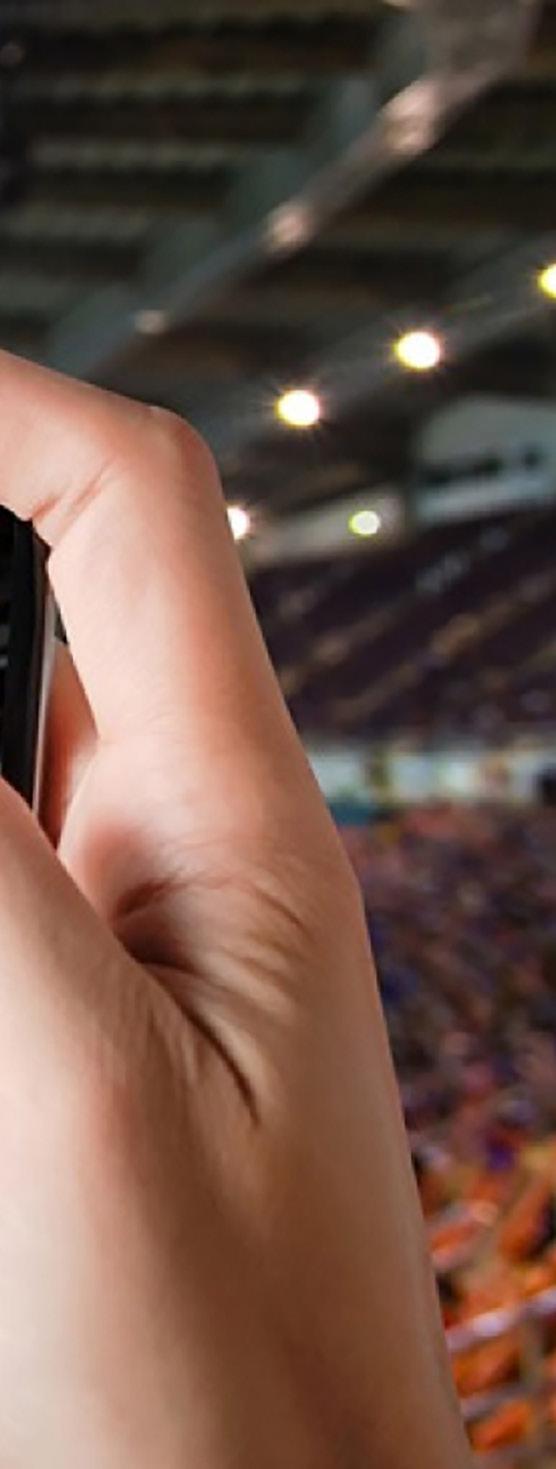


2.4.2 Case studies analysis – Bulgaria (BUL) 79
2.4.2 Case studies analysis – Greece (GRE) 101
2.4.4 Case studies analysis – Turkey (TUR) 103 2.5. National legislation in the field of sport security
106


National legislation in the field of sport security – Bosnia and Herzegovina (BiH) 106
National legislation in the field of sport security – Bulgaria (BUL) 108
National legislation in the field of sport security – Greece (GRE) 111
National legislation in the field of sport security – TUR 129


Since ancient times, sport has been a symbol of peace, unity and strength of the human spirit and physical endurance. Sport is an essential component of the life of modern societies. Major sporting events attract the interest of many people from all over the world. The development of new and modern technologies has accelerated media coverage of sporting events, and access to sports competitions, soccer tournaments etc. has become easier than ever before.
The rapid speed of globalization has allowed fans to get together and travel as part of an organized group of supporters or to attend sports events on their own. These mass public gatherings to support a particular player or a team have come to represent the unity of mankind, regardless of race, gender or social status.
Yet it is during these major sports events that the risks of security and safety of persons are the highest. Sport security is an umbrella term covering a variety of risks emerging either from man-made factors, such as ter rorism and negligence regarding safety regulations, or from external phenomena, such as natural disasters, political instability and pandemics. All of these have made sort events highly vulnerable and increasingly attached to international and national security, politics and natural threats, among others.
In recent years, youth radicalization and violence have become a significant global issue. It has led to an in crease in hate speech, xenophobia and racist violence, as well as religious and political violent extremism and ultimately terrorism.
There have been numerous examples in the past where prominent athletes and/or spectators have fallen victim to sports disruptions due to various risk factors. As a result, such incidents could cause con siderable damage to both the safety of people and the integrity of the organizations involved. Incidents at sports events in the past have led to the partial or even complete cancellation of sporting events, which in turn results in serious financial losses and disturbances for athletes and spectators altogether.

Some of the most serious incidents during major sporting events are as follows:
• May 1964 – PERU: In one of the worst ever soccer disasters, more than 300 fans died and 500 were injured in a riot during an Olympic qualifying match in Lima.
• January 1971 – BRITAIN: Sixty-six people died after being trampled upon at Ibrox stadium in Glasgow as they were leaving a match between Rangers and Celtic.
• October 1982 – RUSSIA: Fans were crushed as they left a UEFA Cup tie between Moscow Spartak and Dutch side HFC Haarlem at the Luzhniki sta dium in Moscow. Officials from the former Soviet Union did not disclose the tragedy for years. When they did, the authorities gave an official death toll of 66 although the number who died could have been as high as 340.
• May 1985 – BRITAIN: At least 56 people were killed and more than 200 injured when a fire broke out in the stands at Bradford.
• March 1988 – NEPAL: A stampede towards locked exits in a hailstorm at the stadium in Kathmandu killed more than 90 fans.
• April 1989 – BRITAIN: Ninety-six people were killed and at least 200 injured in Britain’s worst sports disaster after a crowd surge crushed packed fans against barriers at the English F.A. Cup semifinal match between Liverpool and Nottingham Forest at the Hillsborough stadium in Sheffield.
• October 1996 – GUATEMALA: Up to 82 people died when an avalanche of fans tumbled down seats and stairs at a World Cup qualifying match between Gua temala and Costa Rica in Guatemala City.
• May 2001 – GHANA: Around 126 people were killed in a stampede at Accra’s main soccer stadi um when police fired teargas at rioting fans.
•



At least 74 people were killed and more than 1,000 people injured.
 February 2012 – EGYPT: Fans rioted at the end of a match in Port Said when the local team al-Masry beat Al Ahli, one of Egypt’s most successful clubs.
February 2012 – EGYPT: Fans rioted at the end of a match in Port Said when the local team al-Masry beat Al Ahli, one of Egypt’s most successful clubs.
Terrorism is a global threat. We have witnessed differ ent terrorist attacks carried out in different countries and by different methods. Terrorist attacks can be carried out by terrorist groups, lone-actor terrorists, or radicalized individuals. The weapons used can be different as well; firearms, bombs, knives or ordinary and easily accessible tools, like cars, etc.
Many terrorist attacks were perpetuated against sportsmen or the public, or were associated with sports games.

Some of the major sporting events in the past depict ing the link between terrorism and sport are:
was killed, but the incident sparked the university’s first emergency drill in 2007.
March 2009 - Sri Lankan cricket
Pakistan has been playing international matches almost exclusively outside their homeland since six policemen and two civilians were killed when the tour ing Sri Lankan team bus was attacked en route to the Gaddafi Stadium in Lahore for the third day of the sec ond Test. Thilan Samaraweera and Tharanga Paranavi tana were hospitalised while several other players sustained lesser injuries as a result of the incident.

September’
Eleven Israeli athletes and coaches were taken hos tage and then killed, along with one German police of ficer, by the Palestinian Liberation Organization faction ‘Black September’ during the ‘Munich Massacre’ at the 1972 Summer Olympics.
In 1996, Eric Robert Rudolph, a former explosives ex pert for the US Army, placed a backpack with a bomb at Centennial Olympic Park, causing two deaths and injuries to more than 110 others. Rudolph was later on referred to as the Olympic Park Bomber. The park was the only Olympic space open to the public and imme diately following the incident, security and surveillance were doubled and bags needed to be checked before entering the park.
Joe Hinrichs, a student of the University of Oklaho ma, set off a bomb in an open plaza during a 2005 Oklahoma Sooners football game. The bomb was set less than 200 yards from the 82,112-capacity Gaylord Family Oklahoma Memorial Stadium. Only the bomber
Three people - the bus driver, an assistant coach and a press officer - died when terrorists opened fire on the Togo coach in the Cabinda region of Angola, where the team were travelling for the start of the African Nations Cup. Defender Serge Akakpo and goalkeeper Kodjovi Obilale were among a number of passengers injured.
Chechen-American brothers Dzhokhar Tsarnaev and Tamerlan Tsarnaev detonated two bombs near the Boston Marathon finish line in 2013, resulting in the deaths of three people while more than 200 other participants and spectators were injured. Following the incident, security measures at such racing compe titions increased significantly, with participants being encouraged to carry all personal items in clear plastic bags.
A wave of terror swept the city of Paris and caused 137 casualties, four of which, including three suicide bombers, died when three explosions occurred near
the Stade de France, where France and Germany were playing a friendly international. While the game played to a conclusion, fans were brought onto the pitch and the teams spent the night inside the stadium.
The number of casualties might have been higher if it was not for the improved security at Stade de France. A private security guard denied entry to the stadium to a 20-year-old suicide bomber after noticing his sus picious behaviour. The bomber instead detonated the device outside the stadium, injuring bystanders and causing no deaths but his own.




Besides the threat of terrorism, there have been known cases of sports events incidents caused by natural
disasters or other security risks, or boycotting of Olym pic Games motivated by political reasons and social disturbances.
It is, therefore, reasonable to conclude that security measures and activities are an essential component of the preparation and conduct of sports events. Every Sports Club, as well as every sports manager, must have a risk assessment strategy and must take all necessary measures to protect the sportsmen, the public and the related assets of the event. It is of paramount importance to identify the greatest threats and to eliminate or reduce vulnerabilities, which will help minimize risks during sporting events.

In order to identify security risks to the organization of sports events, it is important to have an understanding of what sports security means and what it entails.

The Council of Europe Convention on an Integrated Safety, Security and Service Approach at Football Matches and Other Sports Events (CETS No. 218) conceptualizes sports security as “all measures aiming to tackle violence inside and outside of stadiums, and incorporates all measures designed to deter, prevent and sanction any incident of violence or misbehaviour in connection with football matches and other sports events. It includes, in particular, risk assessment, cooperation between police and other relevant agen cies and the establishment of sanctions.” This detailed definition includes spaces both inside and outside

stadiums, which broadens the scope of the measures applied to sports events.
Alongside the concept of security, the Convention identifies the safety of sports events as “all measures related to the protection of people from being injured or facing a risk to their health and well-being during sports events. This comprises stadium infrastructures and certification and contingency plans.”1
Both safety and security, incorporated into risk man agement and assessment plans, could help reduce risks to the threat of terrorism, violent extremism, nat ural disasters and negligence to the safety of critical infrastructure.
Sports security has become an increasing concern not only on a local and national, but also on an internation al level. Major international organizations, like the Unit ed Nations and the European Union, have established and developed global programs and initiatives to tackle threats to the security of sporting events.
The United Nations Office of Counter-Terrorism (UNOCT) has put forward a Global Program on Security of Major Sporting Events & Promotion of Sport & Its Values to Prevent Violent Extremisms in line with the Tokyo Summer Olympics and FIFA World Cup 2022 in Qatar.2
The European Union also pays a close attention to the fight against terrorism in sports events. The EU has adopted a strategy to counter terrorism with two out of four pillars being to “prevent and protect”, which is directly applicable to sports events.

According to the “Action Plan to support the protection of public spaces”, the “most recent terrorist attacks have shown a recurrent targeting of public spaces, exploiting the intrinsic vulnerabilities of these so-called “soft targets” that result from their open nature and public character”. The Action Plan emphasizes on the emergence of a growing number of ‘low tech’ attacks intending to cause mass casualties and greater public outreach.
Protecting public spaces and venues poses particular challenges to the EU Member States. This is due to the broad variety of public places that have been or could be targeted, their different characteristics ranging from fully open spaces to areas with some form of protec tion, the variety of actors involved in the protection of such sites, the risk of mass casualties and, importantly, the imperative to strike a balance between improving security and preserving the open nature of public spac es, ensuring that citizens can continue their daily lives.



This is why, in 2017, the EU has undertaken an inte grated and multi-agency approach to the security of major sporting events.3 The approach emphasizes on the need of implementing safety, security and service measures in a combination so as to preserve the open nature of public spaces all the while ensuring that the safety and security of both athletes and spectators are being guaranteed.
Even though it is up to the Member States to decide on how to implement such measures, the EU Action Plan and related documents provide important support, guidance and coordination to policy measures taken by national governments.
2 https://www.un.org/counterterrorism/sport-and-security-programme 3 https://www.coe.int/en/web/sport/-/the-new-convention-on-safety-security-and-service-now-in-force-
safesportevent.net

It can be observed that sports incidents are of differ ent natures and could be caused by different factors. We have already witnessed bloody terrorist attacks against sportsmen and the public, violence caused by hooligans, or casualties caused by construction failures or similar incidents. Keeping in mind the complexity of the security environment, it is impossible to guar antee that there will be no attacks or incidents related to sports events in the future. We may even anticipate that incidents will happen, emergencies will arise and attacks might become even more sophisticated. It is a matter of how one prepares, responds, and recovers to mitigate the consequences of emergencies at sports events. Sport managers need to be aware of risk assessment methodologies to detect threats, identify vulnerabilities, and reduce consequences. Information gathered through this process is extremely valuable for enhancing security measures.
Based on the information above, the factors that could cause security incidents at sports events can be grouped as follows: 1. Man-made incidents: terrorism, hooliganism,
the protection of critical assets against terrorist attacks and other threats. Sport venue managers are able to identify vulnerabilities and thus improve the infrastruc ture of the facility and strengthen physical protection systems.



Risk is inherent in almost all aspects of life and can not be fully eliminated from the environment. Risk management is a systematic and analytical process to consider the likelihood that a threat will endanger an asset, individual, or function, and to identify actions to reduce the risk and mitigate the consequences of an attack or a hazardous event.
The above factors can manifest themselves alone or in different combinations, thus complicating both preven tion measures and overall security management. Fac tors can also manifest to varying degrees. One problem that sports managers face is determining the potential threat level and taking appropriate measures.
The risk assessment process is a way to determine risk and threat levels, and identify potential vulnerabil ities. These assessments provide vital information for
1. Man-caused incidents: terrorism, hooliganism, negligence of safety norms, etc.
In recent years, we have witnessed a variety of terrorist attacks - politically or ideologically motivated activi ties - directed against people and/or infrastructure. In most cases, terrorist activities are motivated by Islamic radicalism or far-right or far-left radicalism. The primary objective of terrorists is to carry out attacks causing maximum number of victims, mainly civilians, thus creating panic and chaos. Regarding the methods of committing terrorist activities, actors can make use of bombs, firearms, cold steel – knives, swords and others. Over the past few years, we have witnessed common means, such as cars and trucks becoming weapons of mass terrorist attacks.
In most cases, the targets of terrorists are large groups of people since the main goal is to cause more casu alties. The media coverage of the events, including the recording of the actions carried out by the terrorists themselves, is an integral component of the desired results. In this way, their goals of achieving greater public response and causing fear and chaos are more easily achieved.
We have already had several serious terrorist attacks aimed at sporting events. Sports events are targeted by terrorists for several reasons. First, there is a gath ering of many people - athletes and spectators. Sec ondly, sporting events are the focus of the media and a very large circle of people. This way, terrorist attacks receive a greater response. Third, with an unlimited number of participants and spectators, it becomes more difficult to carry out inspections, and security checks and control the movement and behaviour of people.
The degree of threat of terrorist attacks varies from country to country. It can depend on the degree of radicalization in the country, on the policy pursued by the state, as well as on many other factors. The degree of risk may vary over time. In most cases, this assessment is performed by specialized government
agencies. Organizers of sporting events should be aware that sporting events can be one of the targets of terrorists and seek the assistance of specialized bodies.

Risk factors to the threat of terrorism at sports events vary as well, according to the structure of the public venue, the magnitude of the event, the availability and preparedness of security personnel and the impact of external factors, such as geographical location and financial resources allocated to the safety and security of the event.
A sample tool used to determine the risk of terrorism incidents is the EU Terrorism Risk Assessment of Pub lic Spaces for Practitioners. A critical evaluation of the probability of certain public spaces becoming a target for terrorist activities includes the following indicators:
• People attendance;
• Site symbolism (for example cultural, religious, ideological, historical, economic);
• Size of the facility;
• Importance (consequences if the public space is attacked – human life, logistical, economic, social);
• Specific event and presence of VIPs;
• Already existing security measures;
• Accessibility (free, access control, pedestrian, vehicles etc.).4

Even though these weighing factors might be subjec tive relative to a particular venue, it is reasonable to conclude that sports events enjoy great attendance, have certain symbolic importance and large-scale nature, and thus possess the attributes of becoming attractive targets of malicious activity.
In terms of potential consequences, terrorist attacks are considered low-probability, high-consequence events. Consequences are often serious and irrevers ible, and could be divided into short to medium-term
and long-term ones. In the short term, terrorist at tacks cause injuries to persons and in many cases, the loss of human life. Serious economic losses and the destruction of property and infrastructure is other immediate impact. Taking into account long-term con sequences, terrorist incidents might negatively impact tourism and direct foreign investment in the country or region. The long-term fear of the public leads to eco nomic losses and market disturbances, as well as the loss of trust in government institutions and authorities.
Hooliganism is widespread in many countries. Sports events could be used as an opportunity to disseminate propaganda. Very often the participation of hooligans in sports events is accompanied by the use of alcohol and/or drugs, which trigger aggressive behaviour. This behaviour of hooligans can be life-threatening for many people or can be materialized into vandalism and other illegal activities. There are known cases of causing death and personal injury to more than one person in the course of sporting events. Sports events can also be an occasion to gather agitators who sub sequently take “punitive action” against other teams or their supporters, or decide to carry out pogroms or criminal actions against minorities and other groups of people.
Football fandom provides another important example of the dissemination of violent extremism amongst supporters. The Ultras, which are defined as hard core football fans, are highly active in the terraces of Europe and use the occasion to promote far-right violent extremism, anti-LGBT, racist, islamophobia and anti-Semitic narratives5. Thus, sports stadiums fairly often become places for the expression of all forms of extremism and anti-establishment sentiments. This in turn breeds violence, hatred and ultimately, hooligan ism among football fans.
All this sets a clear task for the state authorities and the organizers of sports events to take measures to prevent illegal actions by agitators/hooligans.
The degree of risk of aggressive behaviour of agitators and hooligans depends on many factors, including what and how much such agitators are, the type of sport that is being practised and others. State author ities usually keep records and monitor the activities of agitators and their leaders. Therefore, event organizers should contact the police and the like.
The factors contributing to violent behaviour and hooliganism during sports events are triggered by a conjunction of factors. A study6 on the youth and hooli ganism in sports events conducted by the Organization for Security and Co-operation in Europe divided risk factors to hooliganism into two groups; personal traits of an individual and external (mainly social) factors.
In regards to individual factors, contributing causes could be frustration caused by the social and economic situations, unemployment, chronic existential uncer tainty, hopelessness, lack of perspectives, economic inequalities, as well as psychological motives like boredom, adventurism and curiosity. External factors include social status and position in society, however, the study points out that not all hooligans come from the vulnerable lower social strata as some of the vio lent characteristics could be attributed to the middle or upper classes.


Other causes of hooliganism at sports events include resentment towards fans of the opposing club, poor security at stadiums, poor infrastructure of the event venue and excessive consumption of alcohol and drugs.
RAND Europe has also examined the factors associ ated with violent and antisocial behaviour at football events, identifying the following7:
• The influence of alcohol, even though the causal relationship between alcohol and hooliganism is unclear;
• Internal and external or relational psychological factors (rush of adrenaline, sense of meaning, etc.);
5 https://www.frontiersin.org/research-topics/19494/sport-radicalisation-and-violent-extremism

6 https://www.osce.org/serbia/118397
7 https://www.rand.org/content/dam/rand/pubs/research_reports/RR2500/RR2580/RAND_RR2580.pdf
• Sporting rivalries, which have been shown to in crease aggression among fans;
• Socio-political factors, such as unemployment, repression by state agents and ethnic-nationality tensions. This factor might be intertwined with the one of political instability in a particular country;
• Spatial factors: a large number of football fans may travel to another country without the intention of attending the game, but rather to gather with supporters in public spaces and fan zones;
• Situational and atmosphere-related factors: these include, but are not limited to, the size of the foot ball game, the match venue, the crowd size and the size of the group of fans attending the event;
• Reactions to the play coupled with fans’ expecta tions of the game.
Overall, the threat of hooliganism can be considered a multi-layered occurrence, which is very often unpre dictable and bears serious consequences.
Failure to perform regulated activities or non-compli ance with safety rules and regulations are also com mon actions or omissions that can lead to accidents at sporting events. These can be non-compliance with fire regulations, which can lead to fires, the admission of more people in certain facilities which could cause the destruction or collapse of infrastructure under pres sure from spectators, and many others. Event manag ers should make a detailed analysis of risk factors and take the necessary preventive measures. This includes identification of risk elements, compliance with all requirements and prescriptions of the authorities and others.
Risk factors associated with the lack of security and safety regulations at sports venues are often related to ineffective, and in some cases even non-existent, stadi um licensing and safety certification agreements. The presence of such licenses is of paramount importance since it would help those responsible for the venue and for the organization of the event to check, evaluate and
monitor the design, construction and crowd manage ment arrangements put in place at stadiums and thus to ensure that all points under consideration are in compliance with national and international standards and good practices.
Lack of licensing and poor oversight of legal standards and obligations are often tied to corruption and there fore collaboration between the public and the private sector in addressing safety issues is crucial. The consequences of poor infrastructure at sports events could be detrimental both for the security and safety of athletes, the audience and staff at the venue, as well as to the reputation of organizers and the security man agement team.
Natural disasters are diverse and rarely predictable. It is very difficult to predict exactly when, with what force and in what way they can influence one or another event. There are known cases of volcanic eruptions preventing the participation of athletes and spectators. To give an example, in 2010, due to a volcanic eruption, all air traffic over Northern Europe was suspended. Earthquakes have caused many destructions and casualties, etc.
The activity of the sports manager, when determining the risk, is to evaluate whether all the norms required for the construction of facilities have been met.
In other cases, the nature, strength, and timing of certain natural events, such as hurricanes, tornadoes, heavy rains, hail, and others, can be determined. Typi cally, this information can be obtained from specializa tion services and taken into account when deciding to hold, postpone or cancel a sporting event.

As the severity of climate change is expected to increase in the near future, so will the threat to the or ganization and conduct of sporting events. Heatwaves hospitalize players in sports from tennis to cricket, competitions are cancelled due to extreme weather conditions, and winter sports try to cope with less snow and ice. All these require sporting bodies to adapt to the changing climate environment.

The planet is heating up and risk factors include meg afires, harsher heatwaves and more intense rain. As a result, many outdoor sports are becoming increasingly challenging. For instance, disruptions on the Europe an continent due to climate conditions could be seen through the course of an entire year; wetter autumns and winters result in muddy conditions and drier sum mers negatively impact the quality of surfaces.
Research in the United Kingdom has found that ex treme weather conditions are posing risks to athletes and the public, and are having serious financial reper cussions8. For example, the 2015/16 sports season in the UK saw the cancellation of 25 matches in total.
Given the above circumstances, an effective and up-todate risk assessment is necessary for sports manag ers to anticipate and, wherever possible, mitigate the risks of natural disasters.



Political instability and wars create serious risks to sporting events, athletes and spectators. A good risk analysis should be made when deciding to send athletes to participate in sports competitions in fragile regions and individual unstable countries. Account should be taken of the risk of athletes and spectators

falling victim to hostilities or to a hostage crisis. On the other hand, such situations can make it impossible for people to leave a country where hostilities are taking place due to flight delays and port blockades.
The risk posed by pandemics can be seen in the ex ample of COVID-19. The pandemic has caused major disruptions to the planning and conduct of sporting competitions. This has affected both athletes and organizers. For example, it is becoming increasingly difficult to gather many people in one place without endangering the health of the public. On the other hand, events like the Olympic games have enormous historical, social and cultural value and their cancella tion could have consequences for the host country, not only in terms of financial losses but also in diplomatic relations with other countries etc.
Holding sporting events with a mass gathering of people can be a factor in the spread of the disease, thus compromising the measures of the health au thorities. According to the World Health Organization (WHO) “sports events can attract a particularly high attendance of domestic and international spectators who come together at stadiums, pitches and fan zones but also before and after the events themselves. These might occur at fan activities, public squares, airports,
on buses, trains and other “pinch points” where people come together in large numbers”9
In case of pandemics, better coordination of the decision-making process with the participation of all stakeholders is needed as well as implementing necessary measures, rethinking the need for inter national travel and organizing mass gathering events and use of a risk-based approach to decide whether to hold, modify, postpone or cancel mass gatherings, etc. The organizers and all stakeholders can use the “WHO Mass Gathering COVID-19 Risk Assessment Tool – Sports Events” see at: https://apps.who.int/iris/ handle/10665/333187.
The organizers should be aware that several factors can be combined, thus multiplying the risks. For exam ple, in pandemic situations, when a decision is made to hold a competition with a limited number of spectators, special care must be taken to tickets, which may lead to a gathering of more people than authorized, and thus compromise the health measures.
Another risk factor could be found in the case of politi cal instability in the particular country hosting a sports event. Public disorder, riots and disobedience are dis turbances which may affect negatively the perceptions of the safety of sports events. A study revealed that in cases where there is a risk of political and/or social violence, tourists were less likely to travel to and attend the country where the event is being held10
Hybrid risks are relatively new and are mostly associ ated with the mass penetration of social networks into human life and the ability to receive and send informa tion at any time and from any place.
Hybrid risks still remain insufficiently studied in terms of their possible impact on sporting events. It can be concluded that the risk of sporting events is related to the spread of false news, for example. Generating and sending fake news related to a sporting event, athletes
or the public can provoke unwanted actions and cause negative consequences.
It is important to analyze the possible risks and iden tify channels and ways to share valid and reliable information.
The spread of inaccurate or false information could directly affect major sporting events. A recent case showing the impact of hybrid threats to sports security was the spread of disinformation and fake news on the spread of Zika during the 2016 Olympic Games in Rio de Janeiro, Brazil. Social media posts were spread claiming that Zika is made up or is a plan to depopulate the civilized world, leading to increased concerns over attendance or even discussions on the cancellation of the Olympics in Rio11
Fake news has also been surrounding the organiza tion of the Tokyo Olympic games which were initially set for 2020 but were postponed due to the outbreak of the COVID-19 pandemic. The International Olympic Committee and Tokyo 2020 organizers warned of the spread of fake news over the cancellation of the sports event.
Hybrid threats might range from amateur social media posts with low impact to well-planned hybrid attacks against the conduct of a sporting event. A risk man agement strategy taking this threat into account would help organizers put measures in place to avoid such disruptions.
The political instability worldwide, exacerbated by the COVID-19 health crisis, has led to the upholding of the ban on protests at the Olympic Games by the Interna tional Olympic Committee12. External factors, such as protests against racialized police lethality, authoritarian regimes and human rights abuses in certain countries, create risks to the use of major sporting events as an instrument to depict disobedience and politicize the occasion, causing further polarization and backlash.
9 https://www.euro.who.int/__data/assets/pdf_file/0005/502853/sporting-event-considerations-COVID-19.pdf
10 https://www.researchgate.net/publication/338651838_Prospective_tourists’_risk_perceptions_and_intentions_to_travel_to_a_mega-sporting_event_ host_country_with_apparent_risk
11 https://link.springer.com/chapter/10.1007/978-3-030-49576-3_32

12 https://www.washingtonpost.com/sports/2021/04/25/ioc-rule-50-olympics/

Cyber-attacks can affect any high-tech activity, leading to negative consequences for systems and equipment.
Cyber-attacks can suspend certain activities or trigger technological processes that can lead to malfunctions of systems and make them potentially dangerous. The advent of Internet-based solutions will make systems increasingly risky in terms of cyber-attacks.
This is why cybersecurity must be a priority for every activity, including the organization and holding of sport ing events. Preliminary assessment of vulnerabilities and taking adequate measures for protection and de fence are absolutely mandatory for sports managers.
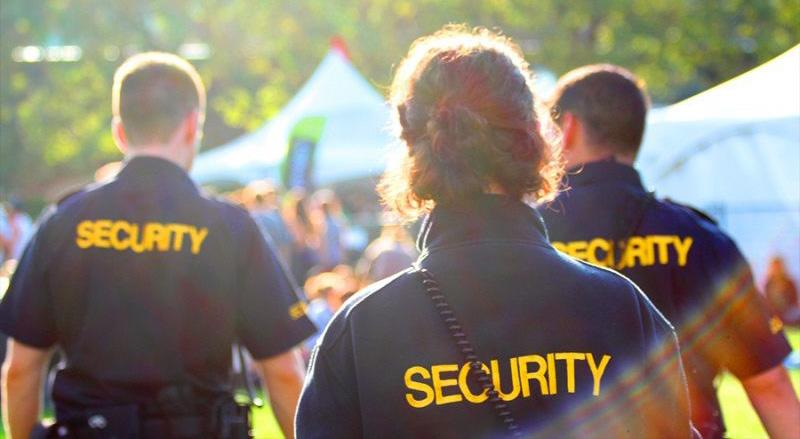
The increasing pace of digitalization has created both opportunities and challenges for the security staff at sports events. From the organization to the conduct of events, interconnected smart devices, such as the Internet of Things, tablets and smartphones, have become an intrinsic aspect of the world of sports. Most sporting events are now digitalized and the better the connectivity, the higher the risk of obstruction by mali cious actors.
The ‘technification’ of sports is set to continue and dig ital technologies will be incorporated into every aspect of the sporting experience. From the scoring systems and the care of athletes, to ‘smart’ stadiums and de vice-enhanced viewing experiences for fans. Some of the cyber trends identified by the Center for Long-Term Cybersecurity (CLTC)13 include:



• The increased quantification of sports scoring systems, requiring detailed numerical scoring schemes;
• Video review that incorporates technology de signed to aid in officials’ decisions;
• Increased interest in data collection on athlete performance and training;
• The proliferation of devices in every aspect of sports facilities, from refrigerators to hair dryers;
• The growth in wearable devices and concomitant data tracking;
• Increased viewer immersion in sports through technology, including virtual reality and drones.
Despite the improvements that come with the devel opment of technology, many future risks include hacks that would cut to the integrity of the sporting event results, as well as to the key operations at stadiums.
CLTC identified eight key areas of risk to the conduct of future sporting events:
• Stadium system hacks;
• Scoring system hacks;
• Photo and video replay hacks;
• Athlete care hacks;
• Entry manipulation;
• Transportation hacks;
• Hacks to facilitate terrorism and kidnapping;
• Panic-inducing hacks.
Hacks affecting the integrity of sports are particularly concerning because they can be difficult to identify. It is problematic to detect when a digital system has been compromised.
For instance, officials in Japan found that government websites were attacked approximately twice per min ute during the Tokyo Olympics. Infamous cybersecurity incidents from previous Olympic Games include:
BEIJING:
• Ticket scamming;
• DDoS and related attacks against IT infrastructure.
LONDON OLYMPICS:

• Ticket scamming;
• DDoS and related attacks against IT infrastructure;
• False alarm threat to the electrical grid.
14 https://www.secureworldexpo.com/industry-news/cyber-threat-to-sports

• Ticket scamming;
• DDoS and related attacks against IT infrastructure;
• Athlete data hack.
In 2018, the Winter Olympics in Pyeongchang was hit by an advanced and wide-ranging series of cyber-at tacks, reportedly causing disruption to the opening cer emony and the event’s website. These activities were almost certainly conducted by a nation-state, with the intent to disrupt the games. The incident happened despite North Korea’s improved cybersecurity meas ures and enhanced collaboration with private-sector actors14
In light of the perceived cybersecurity risks to major sporting events, organizers should be careful when introducing new technologies to sporting events. The tangible benefits should be weighed against the poten tial security risks before moving forward with imple menting them.
In terms of consequences, cyberattacks on critical in frastructure could have serious potential damages and bodily harm to spectators, athletes, officials, and other attendees. Although attacks of such scale are exceed ingly rare, they often rely on targeting physical infra structure which is designed to protect human lives: security systems, transportation, medical devices etc.
A more likely event would be the incurring of physical harm due to a panic-causing situation. For example, if a networked digital display board on a stadium is hacked to show a terrorist alert, then spectators could get injured rushing to leave the venue, even if the alert is false.
Thus, organizers and security managers should be better prepared for such scenarios with protective sys tems and risk management in order to handle potential cyber incidents in the safest way possible.
Technological developments have undoubtedly con tributed to the progress of mankind. Yet, the rapid advancement of IT systems and electronic devices comes with certain downsides in terms of predicting and detecting the negative impact of their application. Some of the most significant developments in the field of new and disruptive technologies include Artificial Intelligence (AI), Blockchain technology, Robotics, Quan tum computing, 3D printing and Serverless computing.
Due to the swift and unpredictable development of these technologies, security managers and law en forcement personnel are often lagging behind in terms of their ability to spot and prevent a potential ‘high-technology’ incident. This is of particular impor tance in the organization of sporting events. Organizers across the globe have the responsibility of keeping their employees, staff, visitors and assets safe and secure. It is essential to embrace the ability to map security systems across physical security, together with operation technology platforms. To avoid and eliminate potential gaps and risks, sports managers should integrate converged security solutions, invest in advanced technologies, equip security guards with wearable technology, deploy ground robots to enhance human security and develop monitoring systems which connect the public and private sector and law enforcement15
New and disruptive technologies create systemic risks to the global ecosystem which have not yet been fully understood by practitioners. Therefore, it is important to have a risk assessment strategy, especially empha sizing new technological developments.
One of the technological developments with the high est risk of disrupting a sports event is the so-called unmanned aerial vehicles (UAVs), commonly known as drones. Drones can be used for both beneficial and malicious purposes – from flying a drone above the stadium to create a better filming angle of the event,


to potentially attaching an explosive device to a drone, which may cause serious damage if left undetected.
Drones should be of particular concern for securi ty managers because they are not only becoming cheaper and easier to own, but also so technologically advanced that virtually anyone, be it a hobbyist or a terrorist – could use the device. Even amateur pilots of UAVs with good intentions or journalists can pose a safety threat to athletes and spectators. The use of such systems has been highly debated during major sporting events and Olympic Games.
The airborne nature of drone systems is what creates the greatest threats to sports security, as it is very dif ficult to stop something that is airborne. For instance, some Triathlon World Championships spread across many miles and numerous outdoor stadiums, which in turn makes it burdensome, if not impossible, to track the entire area of competition.
A case in point was the 2018 Winter Olympics in Pyeongchang, South Korea. Since the government has had increased concerns over the possible disruption of the sports event by North Korea, it enforced no-flying zones over its stadiums in order to mitigate the poten tial risk of a drone attack. The flight restrictions arrived as a part of an update to drone software that instituted restrictions on the duration of the sporting games. Part of the protection included the so-called “drone-cach ing drones”, which had the capability to drop nets over suspicious unmanned aerial vehicles which entered unauthorized areas at stadiums. In addition, a drone detection radar was used to take control of potential offending drones and land them16
Officials also used sensor systems to ‘sniff’ and detect chemical warfare agents and explosive threats, as part of risk management strategies to disrupt threats emerging from new technologies.
Despite all security measures put in place during the Olympics, the South Korean government confirmed a cyberattack during the opening ceremony, which they claimed had been in preparation for over a year and involved a state actor, most likely Russia or North
15 https://securitytoday.com/articles/2020/04/13/how-to-enhance-public-safety-with-emerging-technologies.aspx
16 https://www.cnbc.com/2018/02/05/pyeongchang-olympics-deploy-60000-security-forces-anti-drone-tech.html

Korea17. This example shows that the risk of new and disruptive technologies is intertwined with other risk factors, such as cyberattacks and hybrid threats.

AI is another risk factor which can be used both to detect as well as to enable malicious activities during sporting events. To give an example, AI can be used by security managers to gain insight into the poten tial behaviour and intentions of attendees of an event, particularly when it comes to high-profile events. The process of ‘information mining’ is accelerated by AI and is used by security staff to monitor content on social media, online forums and other websites which can be potentially harmful or related to the security of the sporting event18
Another increasingly concerning yet still underdevel oped phenomenon is the use of AI in facial recognition scanners that detect potential terrorist threats. Such scanners and detectors are becoming widespread in airports and public spaces with a concentration
of crowds. South Korea used such facial recognition during the 2018 Winter Olympics to ensure security at stadiums.
However, as AI technology evolves, so will malicious strategies in turn. Research conducted by the Belfer Center for Science and International Affairs reveals that AI attacks on facial recognition systems could in fact be used to avoid recognition by law enforcement and degrade the accuracy of such systems19. AI-based attacks could be used by terrorists to manipulate facial recognition by cutting or dyeing one’s hair or chang ing facial characteristics, which automatically makes the efficacy of security systems at sports events jeopardized.
It can be observed that new and disruptive technolo gies pose one of the highest risks to security at major sporting events, due to their ability to cause hidden damage and penetrate into AI-based systems which were initially believed to support rather than disrupt the work of security officials.

17 https://www.cnbc.com/2018/02/05/pyeongchang-olympics-deploy-60000-security-forces-anti-drone-tech.html 18 https://www.policechiefmagazine.org/emerging-tech-event-security/ 19 https://www.belfercenter.org/publication/AttackingAI



#SafeSPORTevent state of the art.
#SafeSPORTevent project is totally in line with the spe cific objectives, pursued by the Erasmus+ Programme in the field of sport to develop and reinforce networks; increase their capacity to operate at the transnational level; exchange good practices, and confront ideas and methods in different areas relating to sport and phys ical activity. #SafeSPORTevent main aim is to protect athletes, especially the youngest, from health and safety hazards by improving training and competition conditions and especially during force Majeure security threads that need to be handled by specific security protocols that at this point of development do not exist in the sports sector. The project supports the mobility of volunteers, coaches, managers and staff of non-profit sports organisations for educational purpos es and to enrich their skills and knowledge for reaction in safety and security situations.

#SafeSPORTevent project aims to contribute to further human capacity development in sport through the development of a set of mobilities for sports managers, volunteers and administrators that will include both educational modules and modules for the exchange of good practices in the field of safety and security in sport, with the accent on sports events and gatherings of huge amount of people in the sports environment. Project use and further development in the field of safety and security, the non-formal educational meth odology, Education Through Sport /ETS/ which is an il lustration of using sport as a learning tool and thereby taking steps to stretch sport beyond the activity itself. ETS approach in the context of education, based on non-formal education, experiential learning and active participation, is a conceptual model and a practical learning tool. The activities of this methodology as sist and enrich the non-formal learning processes in the sports sector and equip participating sports management and organization experts with new skills and instruments to be used daily during sports events. ETS methodology (official Salto resource) is a structured pedagogical non-formal educational ap proach that works with sport and physical activity and refers to the development of key competencies of in dividuals and groups, in order to contribute to personal development and sustainable social transformation with a main goal - active citizenship.
The practical focus of the project is to develop skills and knowledge through educational mobility of sports managers, volunteers and administrators in order to empower them to co-create and use specific protocols for safety and security, tailored for sports events and gatherings of huge groups of people in the sports environment. Through increased educa tional possibilities in the field of safety and security in sport, the #SafeSPORTevent project would make positive change in Bosnia and Herzegovina, Bulgaria, Greece and Turkey as direct project beneficiaries, but also all over Europe as project deliverables will be freely shared with the sports community.
Some of the challenges sports organizations face both on professional/elite and grassroots levels are:
• Lack of formal and non-formal education in the field of safety and security in sports and especially during organized sports events that gather huge amounts of people together;
• Lack of specific protocols for reaction in force Ma jeure situations that might ensure proper reaction if such situations are suddenly happening;
• Clearly expressed need at national and European levels to ensure quality protocols and instruments for reaction during force Majeure situations on the sports field.
At the same time, there is a huge amount of sports events (more than 300 over the World, including the major sports forum - the Olympic Games) that have been cancelled in the last months due to the biosecu rity emergency COVID-19 pandemic and as some of them had to be interrupted while happening and there were none or very limited protocols for the reaction of sports organizations, organizing those events.

Until the moment, on the field of sport and physical activity in the EU has been implemented the following phases of sports policy development:
• The 2007 White Paper on Sport noted that self-regulation can deal with most challenges that affect sport if good governance principles are being applied;
• In its 2011 Communication (Developing the Euro pean Dimension in Sport) the Commission took a more elaborate position, noting that good govern ance in sport is a condition for the autonomy and self-regulation of sports organisations;
• In 2011, the topics of good governance and strengthening the organisation of sport in Europe were included in the Preparatory Actions in the field of sport. Eight projects were selected, imple mented, and concluded by the end of 2013;
• European funding in the field of sport and physical activity has become reality in 2014 with the kickoff of the Erasmus Plus Programme 2014 – 2020 and 2021 - 2027 which allows sports clubs and organizations in the EU to combine efforts and find solutions to common problems;
• The European week of sport has been launched in 2016 and it is supporting sports clubs and organizations to reach better visibility for their activities with huge success in the last editions.

In the field of security, the Union has developed the following policies:


• EU Counter-Terrorism Strategy, adopted by the European Council in 2005, commits the Union to combat terrorism globally, while respecting human rights and allowing its citizens to live in an area of freedom, security and justice. It is built around four strands: Prevent people from turning to terrorism and stop future generations of terrorists from emerging; Protect citizens and critical infrastruc ture by reducing vulnerabilities against attacks; Pursue and investigate terrorists, impede planning, travel and communications, and cut off access to funding and materials and bring terrorists to justice; Respond in a coordinated way by pre paring for the management and minimisation of the consequences of a terrorist attack, improving
capacities to deal with the aftermath and taking into account the needs of victims.
• European Agenda on Security, adopted on 28 April 2015. Based on its objectives, the Commission adopted several measures to deny terrorists as much as possible the means to carry out attacks, strengthening the defences and building resilience against the terrorist threat.
• Directive on combating terrorism that reinforces the legal framework so that it covers more com prehensively conduct related to terrorism. Mem ber States should have in place mechanisms to provide for efficient emergency response, including access to reliable information, thereby avoiding any additional suffering for victims of terrorism and their families.
A central element of the fight against terrorism is to support the Member States in protecting European society and critical infrastructures from attack. Those efforts involve a broad spectrum of governmental, pri vate and non-government partners. Specific areas of focus include the prevention of terrorist attacks using chemical, biological, radiological and nuclear (CBRN) materials, the protection of public spaces, explosives and explosives precursors, and critical infrastructure protection (CIP). Besides facilitating networks of experts cooperating on these topics, the Commission works to track threats and develop guidance for the Member States. Given that the implementation and fur ther development of counter-terrorism policies rely on the availability of cutting-edge technologies, the Com mission is involved in facilitating their advancement through security research projects, in order to equip the Member States with the tools necessary to mitigate against the terrorist threat to European citizens.
Specific policies on reaction and preparedness for biosecurity and medical emergencies such as the COVID-19 pandemic will be developed at the future stage and the present moment will contribute to the evidence base of documents and resources that can be used by the sports sector, but most of them can be also applicable for any kind of huge group gatherings such as concerts, art festivals, exhibitions, etc.
Background of the project

Background of the report
Methodology
Statistical analysis
• Language
• Device
• Type of organization
• Does your sports organization organize sports events
• Does your sports organizations implement a risk assessment before the delivery of each sports event
• Risk assessment is implemented in the following phases of the delivery of sports events:
• Does your organization can count on safety and se curity experts in order to ensure safe sports events

• Does your organization possess a safety and secu rity procedure (strategy, protocol, guidelines)
• Does your organization implement safety and se curity training for its employees and volunteers
• Risk assessment training is delivered to
• Terrorist attack
• Biosecurity emergency (potential risks for diseases)
• Radicalized groups (fans, team supporters)
• Hybrid attacks (propaganda, deception, sabotage and other non-military tactics)
• Winning opportunity for the national athletes
• Incomes (financial benefits)
• Sport results
• Proper delivery of the event
• Ensuring the security of athletes and spectators
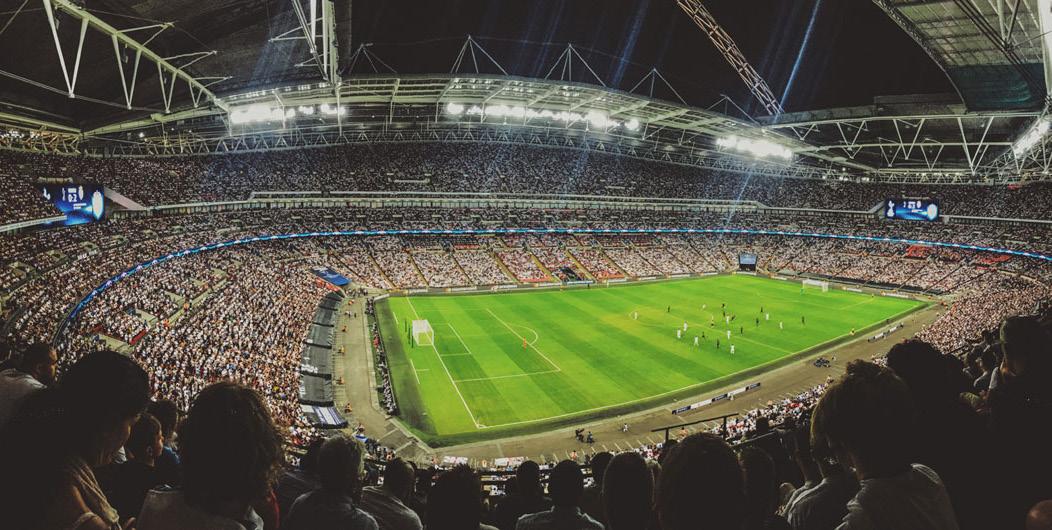
• If you are informed that there is a security risk at the event you are organizing, what would you do
• In your budget plans, are you counting on safety and security as an important factor
• Have you ever had a problem with security during events you organized
• Are you interested to take part in safety and securi ty training opportunities regarding the organization of sports events
• Questionnaire
The structure of our project, Safety and security in sports, was aimed to protect athletes, especially the youngest, from health and safety hazards by improving training and competition conditions and especially dur ing major security threads that need to be handled by specific security protocols that at this point of develop ment do not exist in the sports sector. The main focus of the project was on athletes and players from four major countries (Bosnia, Bulgaria, Greece and Turkey) who were part of three main organizations i.e. Sports clubs, sports federations and sports organizations. The main purpose of the investigation was to plan safety and security in the sports sector and to implement the findings of this research in the planning of educational activities. The project will support the mobility of volun teers, coaches, managers and staff of non-profit sports organizations for educational purposes and will enrich their skills and knowledge for reaction in safety and security situations.



SafeSPORTevent is a project that is designed during a hard time in European countries and the World when the European Commission’s main objective is the safety of all Erasmus and European Solidarity Corps participants and far abroad – protection of any further similar challenges that might come in future. From a more personal perspective, this event aims to get views of athletes and players about security concerns that what are their expectations and what plans and programs they are getting to fulfil the security pur poses. By getting the viewpoints of players it will be easier to implement the planning for the future in a safer effort. For this purpose, the four main countries (Bosnia, Bulgaria, Greece and Turkey) were targeted for getting the data who were part of major sports organ izations so the information can be disseminated in the European Union
The common methodological tool used to collect and analyze data and information in their origin countries has been a questionnaire.
• Country of origin
• Native language
•
• Risk assessment
•
•
•
Each section has been created according to its rele vance to the project’s objectives and expected results. The final version of the questionnaire is the conse quence of long revision work by all the members involved in this project.
First of all, the country of a participant was asked to compare the results of each country involved in this research. Each question was organized in the form of a multiple choice question to choose the best one. Each possible answer was given in choice. There were a total of 217 questions with 2 open-ended questions. The questionnaire was filled through an online survey in which participants were voluntarily asked to solve it. The results were extrapolated through statistical analysis, with simple, linear correlations between the used variables and were differentiated through means and charts.
The following Outputs will be developed to achieve the project aims mentioned above:
• Good practices toolkit edition Safe Sports Event including practical brochures (protocols) for Safe Sports Event that sports organizations can use as a guide during the organization of local/national/ international sports events and innovative Educa tion Through Sport activities with a focus on safety and security (non-formal educational activities);
• Empowered sport managers, administrators and volunteers in 2 European Union, 1 Programme country and 1 Western Balkans country to work with more focus on empowerment of safety and security in sport, especially during sports events;

• Delivered international training Complex security environment and Sport and implemented local training courses as replication of the international TC in order to ensure snowfall effect;
As a premise, a review of the literature at the in ternational and local level, has been performed on SafeSPORTeventopics aims to establish the best-avail able information and data (most recent and most ro bust). Researchers from the partners have conducted a literature search to identify existing, tested ques tionnaires. In each country, a sample of at least 214 athletes and players completed the questionnaire, over two weeks (April 2021).

In Bulgaria, the inquiry was executed via an online questionnaire, distributed through the BSDA network and social media.
In Greece, Bosnia and Turkey the questionnaire has been completed online.
• CAWI (Computer Assisted Web Interviewing) method: respondents will receive an email asking them to fill out the form online (link to the “Google Forms”).
The percentage of participants from Bosnia and Her zegovina was 17.8% of the total sample population. In Bulgaria, it was 17.3%. Similarly in Greece and Turkey, the participation was 22.4% and 42.5% respectively. If we talk about the type of organization, members of Sport club were 59.8%, Sports organizations 28.5% and Sports federations were 11.7%.
The data collected in the four countries participating in the project were merged into a single database as the information collected was the same in each sub-sam ple. As the data was collected through an online survey so excel file was first converted to SPSS for data anal ysis. The whole data was converted to numeric form to find out the correlation and differences. Data related to each country was analyzed separately to find out the country-wise differences and differences among the type of sports organization in each country was also analyzed separately for a thorough overview and comparison among these. First of all the demographic table shows the frequencies of the point of view of the concerned sample in different countries with differen tiation with the help of pie charts. Next is the difference in descriptives based on the type of organization. This difference is also illustrated with the help of pie charts.
The statistical analysis consists of counts reported as percentages to guarantee comparability for each topic dealt with among the participating countries. This sample is not exactly representative of the whole population but it gives the main themes regarding improvements in sports for the safety and security of further plans made in this regard.
Country of residence
Bosnia and Herzegovina


Language Frequency Percent
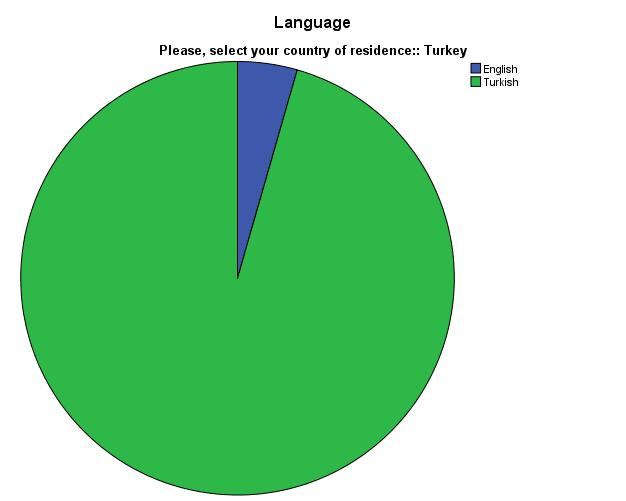
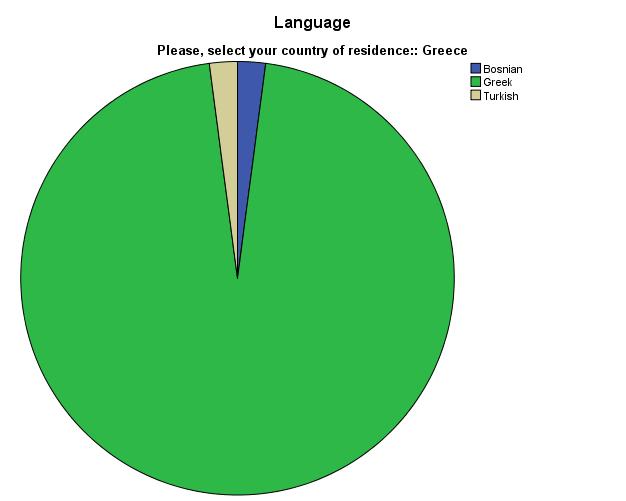
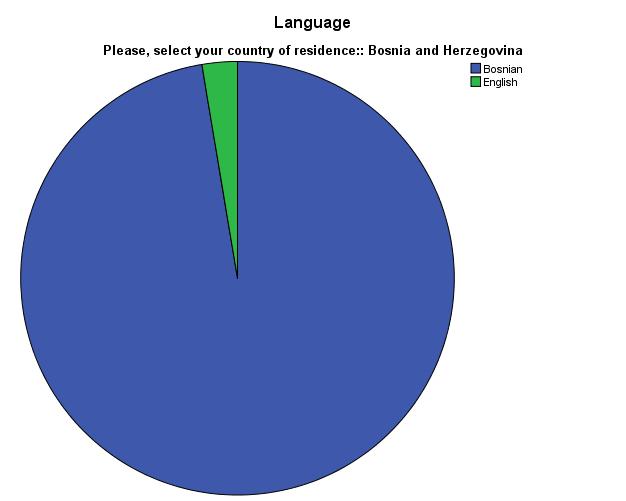

Bosnian 37 97.4 English 1 2.6 Total 38 100.0

Bulgaria Bulgarian 37 100.0
Greece
Bosnian 1 2.1 Greek 46 95.8 Turkish 1 2.1 Total 48 100.0
Turkey English 4 4.4 Turkish 86 95.6 Total 90 100.0
As mentioned earlier, participants from four major countries (Bosnia and Herzegovina, Bulgaria, Greece and Turkey) participated in this activity in which in formation was collected for security purposes. So all these tables are based on differences in countries. As mentioned in the above table and figures, it shows that in Bosnia and Herzegovina 97.4% selected the Bosnian
language and 2.6% of participants choose the English language. If we talk about Bulgaria, all the partici pants (100%) opted for Bulgarian to fill the Performa. In Greece, the frequency of participants was Bosnian (2.1%), Greek (95.8%) and Turkish (2.1%), while in Tur key, English and Turkish languages were selected with the frequency of 4.4% and 95.6% respectively.
Table 2
Bosnia and Herzegovina
Bulgaria
Greece
Turkey
Device
Frequency Percent
Desktop 7 18.4 Mobile 31 81.6


Total 38 100.0
Desktop 17 45.9 Mobile 20 54.1 Total 37 100.0
Desktop 31 64.6 Mobile 15 31.3 Tablet 2 4.2 Total 48 100.0
Desktop 6 6.7 Mobile 84 93.3 Total 90 100.0 Mobile 84 93.3 Total 90 100.0
If we talk about devices used in filling the questionnaire above table and figures show that 18.4% of desktops and 81.6% of mobiles were used in Bosnia and Her zegovina. Similarly in Bulgaria, 45.9% of participants used desktop and 54.1% used mobile. In Greece, 64.6%
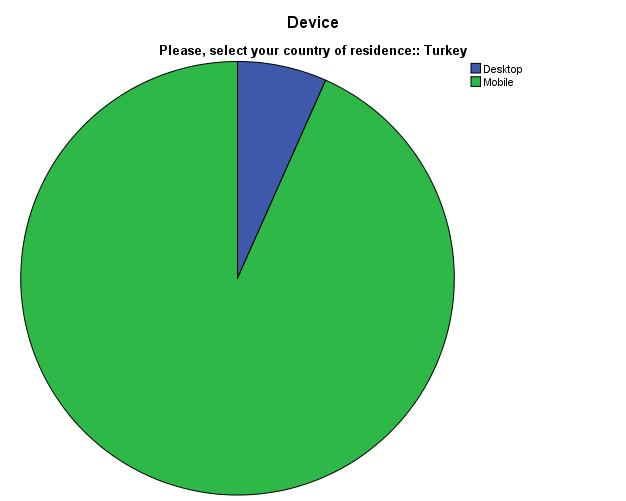


used desktop and 31.3% used mobile while in Tur key, 6.7% used desktop which was comparatively low usage as compared to other countries and 93.3% used mobile which is the highest used mobile as compared to other countries.

Table 3
Please
Country of residence Organization type
Bosnia and Herzegovina
Bulgaria


Greece
Turkey
Frequency Percent
Sport club 28 73.7 Sport organization 10 26.3

Total 38 100.0
Sport club 21 56.8 Sport federation 10 27.0 Sport organization 6 16.2
Total 37 100.0
Sport club 40 83.3 Sport federation 5 10.4 Sport organization 3 6.3
Total 48 100.0
Sport club 38 42.2 Sport federation 10 11.1 Sport organization 42 46.7
Total 90 100.0
If we talk about sports organizations working in different countries and the ratio of participants who participated in this activity, then 73.3% of participants of sports clubs were from Bosnia, 56.8% for Bulgaria, 83.3% from Greece and 42.2% from Turkey. If we talk
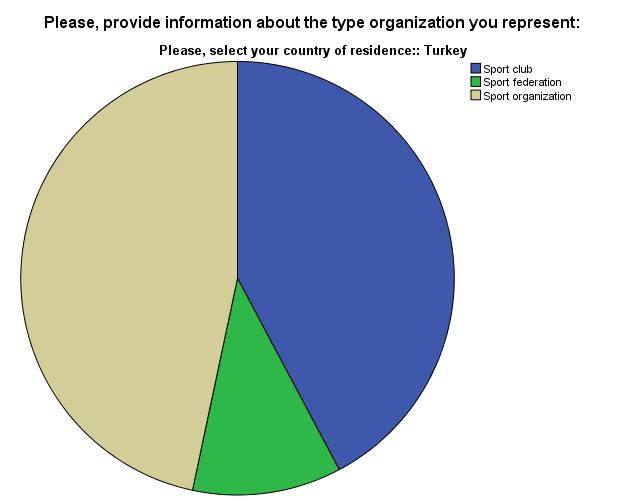
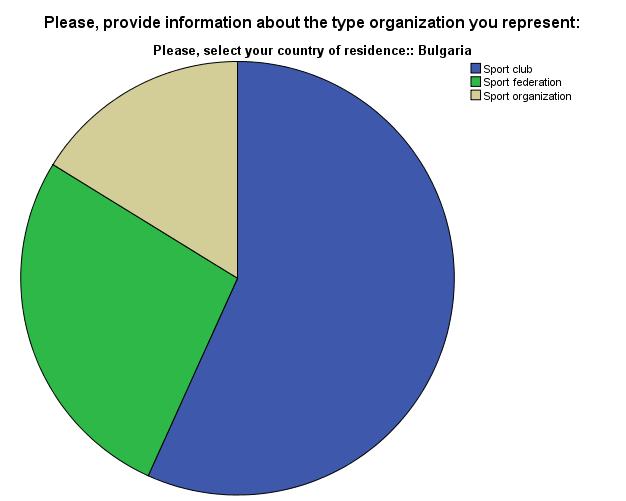
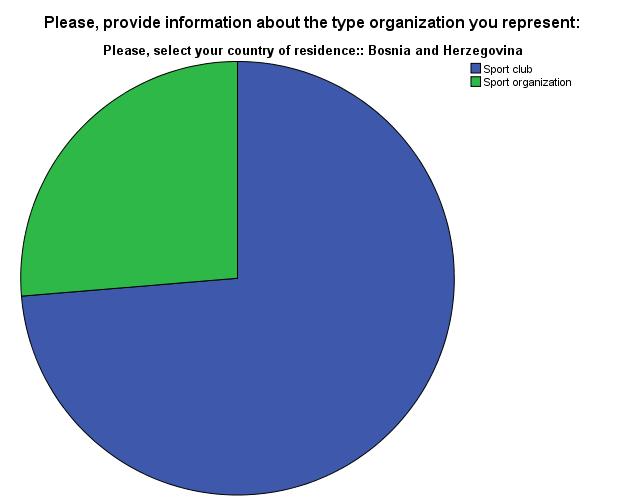
about the Sports federation; 27% of participants were from Bulgaria, 10.4% from Greece and 11.1% from Turkey. Similarly, for sports organizations, 26.3% of participants were from Bosnia, 16.2% from Bulgaria, 6.3% from Greece and 46.7% from Turkey.

Bosnia and Herzegovina
Bulgaria
Greece
Turkey
Table 4


Responses

Frequency Percent
No 1 2.6
Yes, on local level 19 50.0
Yes, on national level 9 23.7 Yes, on international level 9 23.7
Total 38 100.0
No 2 5.4
Yes, on local level 12 32.4
Yes, on national level 10 27.0 Yes, on international level 13 35.1
Total 37 100.0
No 4 8.3
Yes, on local level 23 47.9
Yes, on national level 14 29.2 Yes, on international level 7 14.6
Total 48 100.0
No 2 2.2
Yes, on local level 47 52.2
Yes, on national level 23 25.6 Yes, on international level 18 20.0
Total 90 100.0
A question was asked if their sports organization organize sports events, only 2.6% of participants from Bosnia, 5.4% from Bulgaria, 8.3% from Greece and 2.2% from Turkey answered No to this question. While 50% of participants from Bosnia, 32.4% from Bulgaria, 47.9% from Greece and 52.2% from Turkey said that their organization conduct such events at the local level. Participants who said that their organization
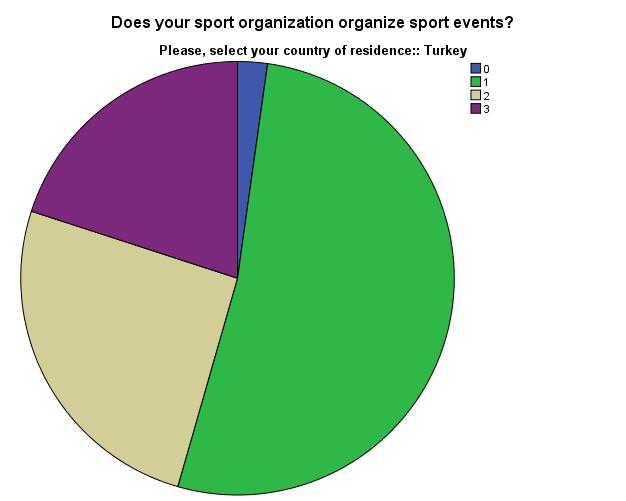
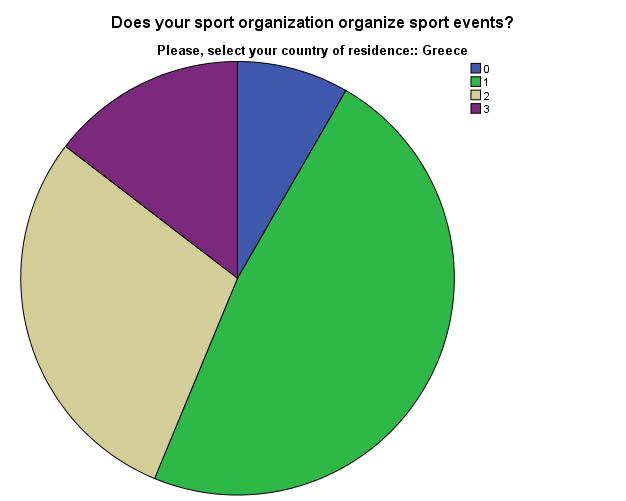
conducted such events at the National level were 23.7% participants from Bosnia, 27% from Bulgaria, 29.2% from Greece and 25.6% from Turkey. On the oth er hand, participants who said that their organization conducted such events at an International level were 23.7% participants from Bosnia, 35.1% from Bulgaria, 14.6% from Greece and 20% from Turkey.
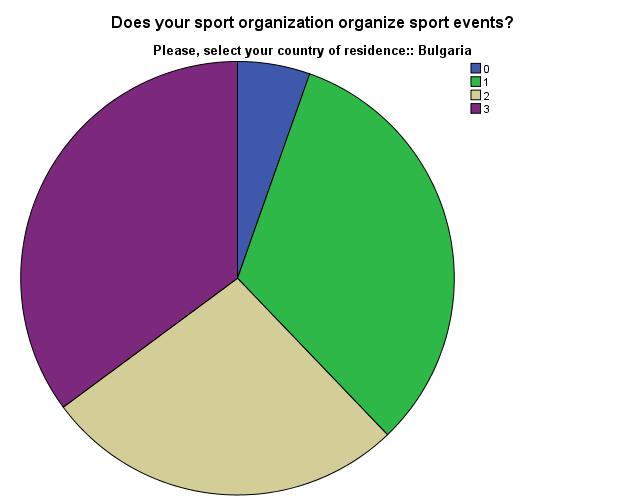
Country of residence
Responses

Bosnia and Herzegovina


Bulgaria
Greece
Turkey
Table 5
Frequency Percent
No 2 5.3 Yes 20 52.6 Sometimes, but not for all events we are organizing 16 42.1
Total 38 100.0
No 10 27.0 Yes 12 32.4 Sometimes, but not for all events we are organizing 15 40.5 Total 37 100.0
No 13 27.1 Yes 21 43.8 Sometimes, but not for all events we are organizing 14 29.2 Total 48 100.0
No 16 17.8 Yes 36 40.0 Sometimes, but not for all events we are organizing 38 42.2 Total 90 100.0
A question was asked if their organization implements a risk assessment before the delivery of each sports event only 5.3% of participants were from Bosnia while 27% were from Bulgaria, 27.1% from Greece and 17.8% from Turkey answered No to this question. While 52.6% of participants from Bosnia, 32.4% from
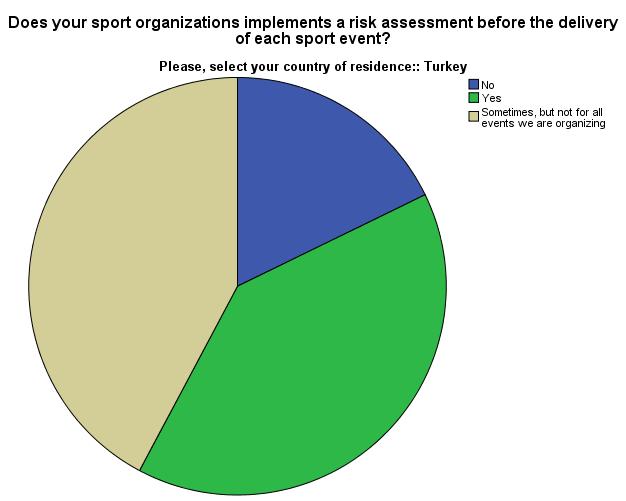


Bulgaria, 43.8% from Greece and 40% from Turkey said that their organization implement a risk assessment. Participants who said that their organization some times conduct a risk assessment were 42.1% partic ipants from Bosnia, 40.5% from Bulgaria, 29.2% from Greece and 42.2% from Turkey.
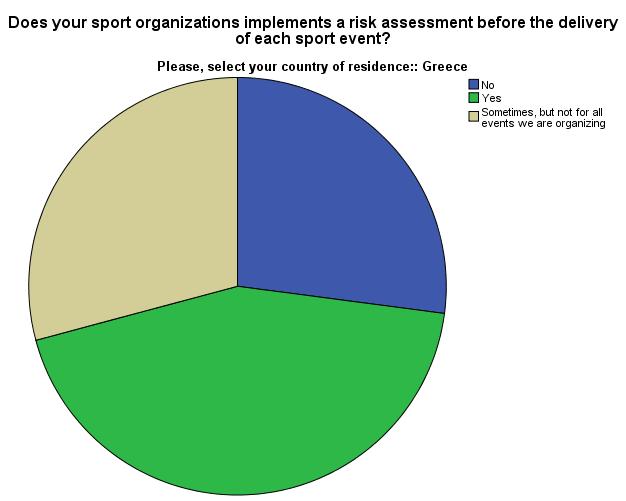 Do your sports organizations implement a risk assessment before the delivery of each sports event?
Do your sports organizations implement a risk assessment before the delivery of each sports event?
Table 6
Frequency Percent
No risk assessment is implemented 7 18.4
Risk assessment of the preparation activities of the delivery of sports event 5 13.2


Bulgaria
Greece
Risk assessment of the delivery activities of the delivery of sports event 6 15.8
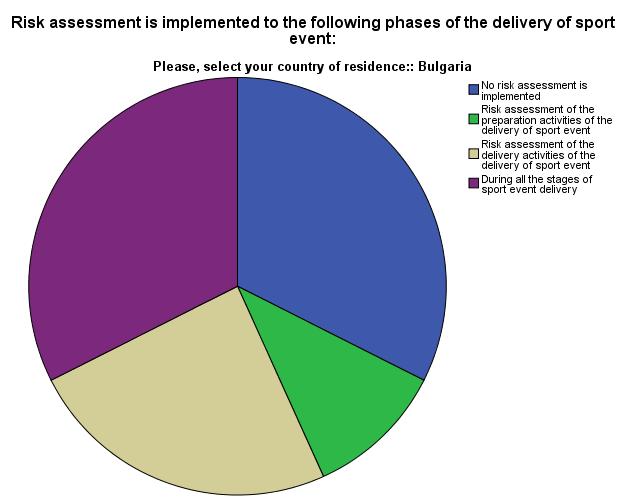

During all the stages of sports event delivery 20 52.6
Total 38 100
No risk assessment is implemented 12 32.4
Risk assessment of the preparation activities of the delivery of sports event 4 10.8
Risk assessment of the delivery activities of the delivery of sports event 9 24.3
During all the stages of sports event delivery 12 32.4
Total 37 100.0
No risk assessment is implemented 7 14.6
Risk assessment of the preparation activities of the delivery of sports event 10 20.8
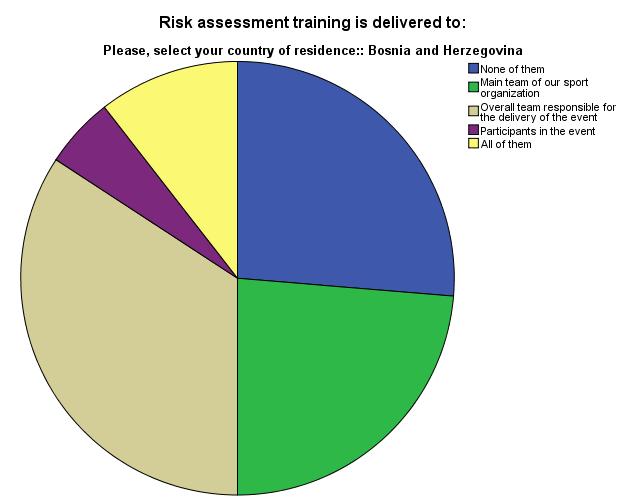
Risk assessment of the delivery activities of the delivery of sports event 4 8.3
During all the stages of sports event delivery 27 56.3
Total 48 100.0
No risk assessment is implemented 10 11.1
Risk assessment of the preparation activities of the delivery of sports event 19 21.1

Risk assessment of the delivery activities of the delivery of sports event 9 10.0
During all the stages of sports event delivery 52 57.8
Total 90 100.0
Another question was if a risk assessment is implement ed; participants who said ‘’No risk is implemented’’ were 18.4% participants from Bosnia while 32.4% from Bul garia, 14.6% from Greece and 11.1% from Turkey. Partici pants who answered ‘’Risk assessment of the preparation activities of the delivery of sports event’’ were 13.2% from Bosnia, 10.8% from Bulgaria, 20.8% from Greece and
21.1% from Turkey. Participants who answered ‘’Risk as sessment of the delivery activities of the delivery of sports event’’ were 15.8% from Bosnia, 24.3% from Bulgaria, 8.3% from Greece and 10% from Turkey. Participants who answered ‘During all the stages of sports event delivery’’ were 52.6% from Bosnia, 32.4% from Bulgaria, 56.3% from Greece and 57.8% from Turkey.
Table 7
Country of residence
Bosnia and Herzegovina
Responses
Frequency Percent
No 16 42.1


Yes, we are counting on external safety and security expert 22 57.9
Total 38 100.0
Bulgaria No 23 62.2
Greece
Turkey
Yes, we are counting on external safety and security expert 14 37.8
Total 38 100.0
No 28 58.4
Yes, we are counting on external safety and security expert 20 41.6
Total 48 100.0
No 24 26.7
Yes, we are counting on external safety and security expert 66 73.3
Total 90 100.0
Another question which respondents answered was either their ‘organization can count on safety and se curity experts in order to ensure safe sports events. In the answers, 42.1% of participants from Bosnia 62.2% from Bulgaria, 58.4% from Greece and 26.7% from Turkey answered that their organization don’t count on


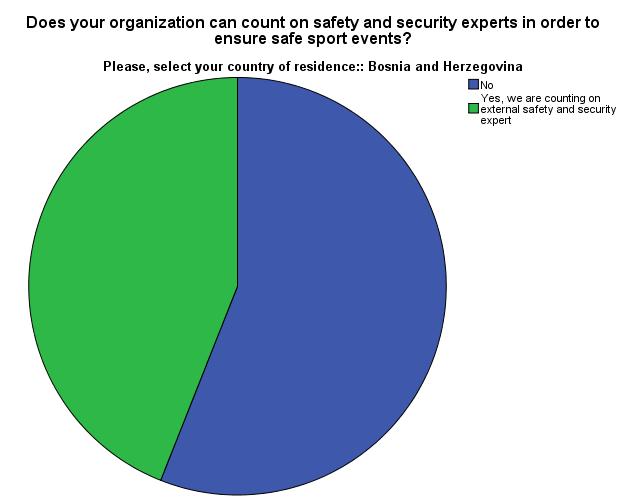
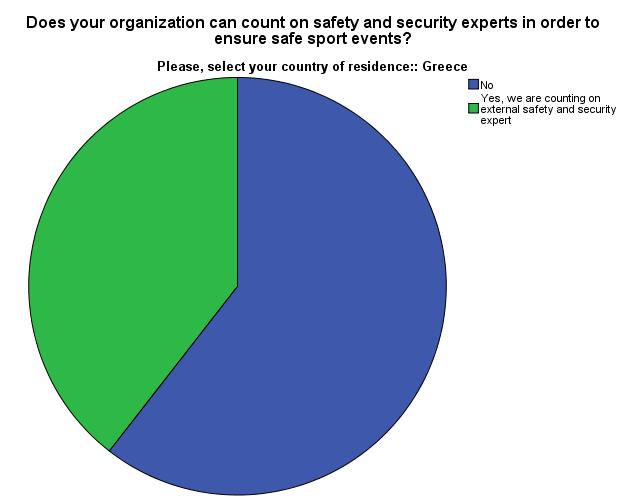
such security experts to ensure safe sport event while on the other hand 57.9% of participants from Bosnia 37.8% from Bulgaria, 41.6% from Greece and 73.3% from Turkey answered that their organization rely on such experts.
 Does your organization count on safety and security experts in order to ensure safe sports events?
Does your organization count on safety and security experts in order to ensure safe sports events?
Table 8



Bosnia and Herzegovina
Bulgaria
Greece
Turkey
Frequency Percent
No, we do not possess such protocol 22 57.9 Yes, we count on safety and security protocol 16 42.1
Total 38 100.0
No, we do not possess such protocol 26 70.3 Yes, we count on safety and security protocol 11 29.7
Total 37 100.0
No, we do not possess such protocol 24 50.0 Yes, we count on safety and security protocol 24 50.0
Total 48 100.0
No, we do not possess such protocol 28 31.1
Yes, we count on safety and security protocol 62 68.9 90 100.0
Another question which respondents answered was ‘Does your organization posses a safety and security procedure (strategy, protocol, guidelines)’. In the an swers, 57.9% of participants from Bosnia 70.43% from Bulgaria, 50% from Greece and 31.1% from Turkey
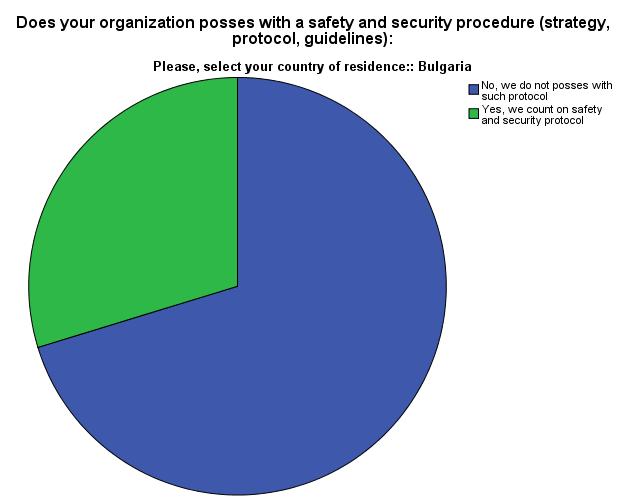
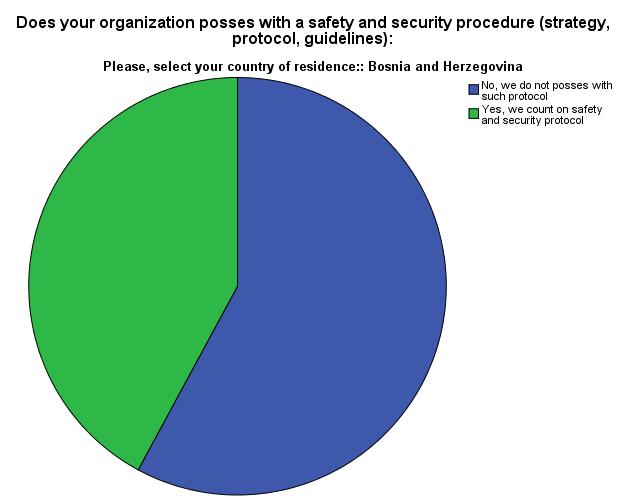
answered that their organization don’t possess such security procedure while on the other hand 42.1% of participants from Bosnia 29.7% from Bulgaria, 50% from Greece and 68.9% from Turkey answered that their organization rely on such procedures.
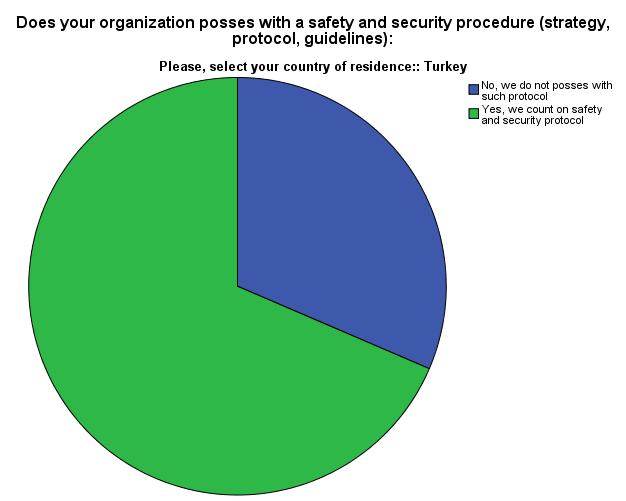
Bulgaria


Greece
Turkey
Table 9
No, we do not have such practice 23 60.5
Yes, on a regular basis 2 5.3 Yes, before the delivery of the concrete sports event 13 34.2
Total 38 100.0
No, we do not have such practice 23 62.2 Yes, on a regular basis 2 5.4 Yes, before the delivery of the concrete sports event 12 32.4
Total 37 100.0
No, we do not have such practice 24 50.0 Yes, on a regular basis 8 16.7 Yes, before the delivery of the concrete sports event 16 33.3
Total 48 100.0
No, we do not have such practice 30 33.3 Yes, on a regular basis 25 27.8 Yes, before the delivery of the concrete sports event 35 38.9
Total 90 100.0

A question was asked if their organization implements safety and security training for its employees and vol unteers most of the ration of participants answered NO to this question with a percentage of 60.5% from Bos nia, 62.2% from Bulgaria, 50% from Greece and 33.3% from Turkey. While a very low ratio said that they con duct such training on regular basis with a percentage
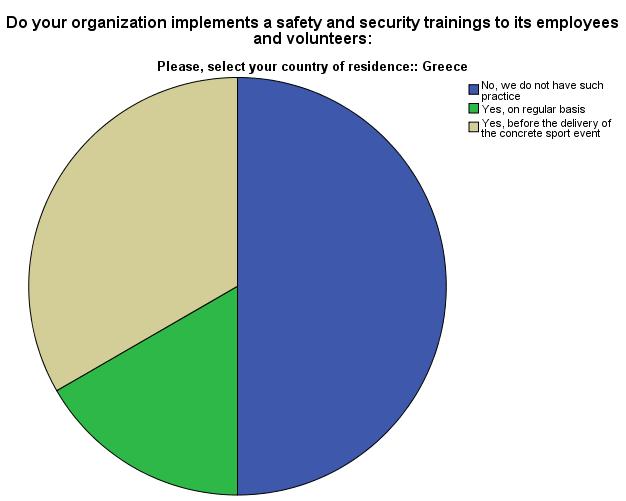
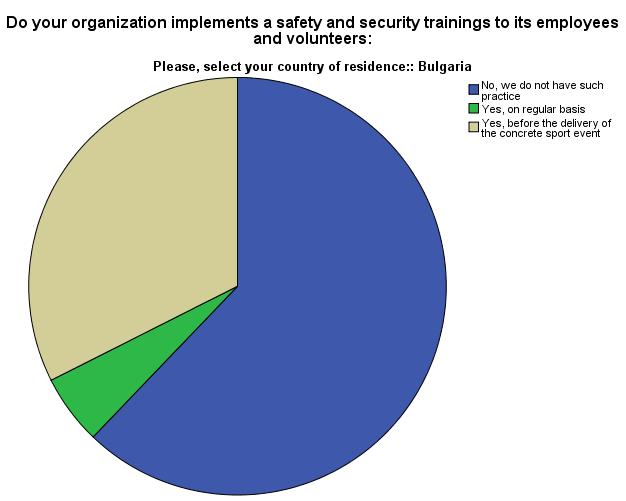
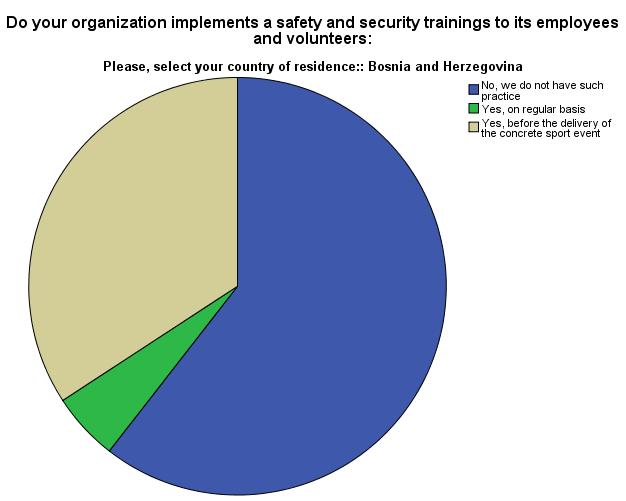
of 5.3% participants from Bosnia, 5.4% from Bulgaria, 16.7% from Greece and 27.8% from Turkey. Partic ipants who said that their organization sometimes conducted such training just before a concrete sports event were 34.2% from Bosnia, 32.4% from Bulgaria, 33.3% from Greece and 38.9% from Turkey.
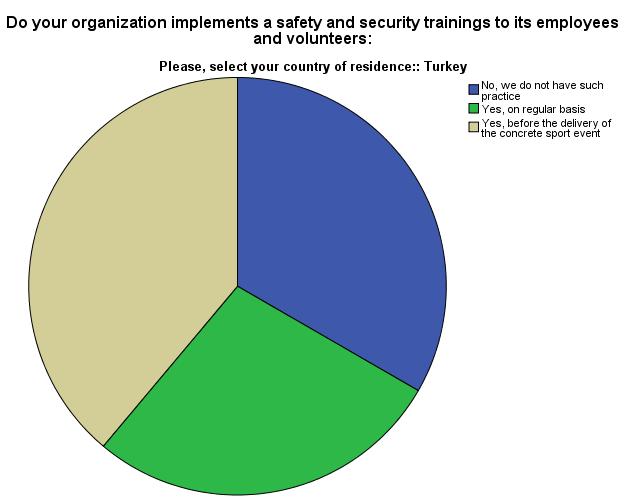 Does your organization implement safety and security training for its employees and volunteers: Country of residence: Responses Frequency Percent
Does your organization implement safety and security training for its employees and volunteers: Country of residence: Responses Frequency Percent
Bulgaria

Greece
Turkey
Table 10


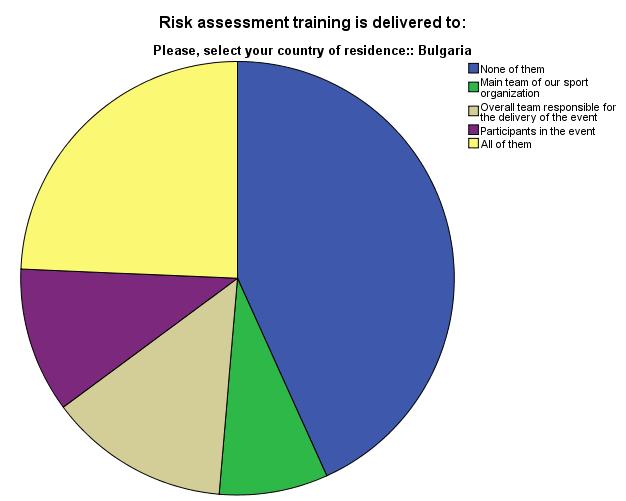
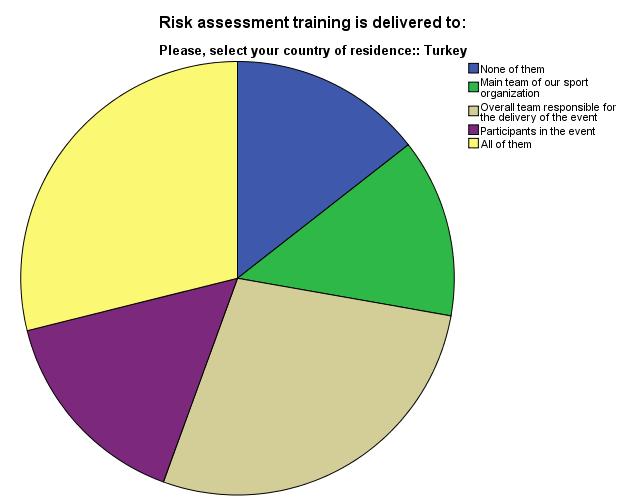
None of them 10 26.3
The main team of our sports organization 9 23.7
The overall team responsible for the delivery of the event 13 34.2

Participants in the event 2 5.3 All of them 4 10.5
Total 38 100.0
None of them 16 43.2
The main team of our sports organization 3 8.1
The overall team responsible for the delivery of the event 5 13.5
Participants in the event 4 10.8
All of them 9 24.3
Total 37 100.0
None of them 12 25.0
The main team of our sports organization 9 18.8
The overall team responsible for the delivery of the event 10 20.8
Participants in the event 9 18.8
All of them 8 16.7
Total 48 100.0
None of them 13 14.4
The main team of our sports organization 12 13.3
The overall team responsible for the delivery of the event 25 27.8
Participants in the event 14 15.6 All of them 26 28.9
Total 90 100.0
Another question was if risk assessment training is implemented; participants who said ‘None of them’ were 26.3% from Bosnia while 43.2% from Bulgaria, 25% from Greece and 14.4% from Turkey. Participants who answered risk assessment training is implemented only for ‘Main team of our sports organization’ were 23.7% from Bosnia, 8.1% from Bulgaria, 18.8% from Greece and 13.3% from Turkey. Participants who answered ‘Overall
team responsible for the delivery of the event’ were 34.2% from Bosnia, 13.5% from Bulgaria, 20.8% from Greece and 27.8% from Turkey. Participants who answered that training is provided to participants in the event were very less; ranging from 5.3% from Bosnia, 10.8% from Bulgar ia, 18.8% from Greece and 15.6% from Turkey. While those who responded that training is provided to all of them ranged from 10.5% for Bosnia to 28.9% for Turkey.
Table 11
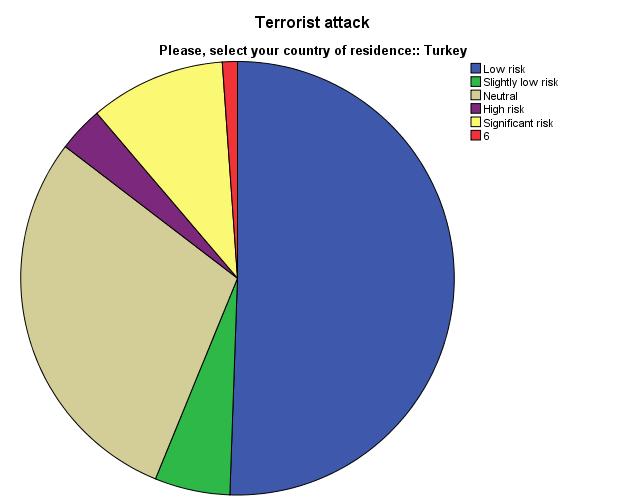




Bulgaria
Greece
Turkey
Frequency Percent
Low risk 36 94.7
Neutral 1 2.6 Significant risk 1 2.6
Total 38 100.0
Low risk 27 73.0
Slightly low risk 5 13.5
Neutral 1 2.7 High risk 1 2.7 Significant risk 3 8.1
Total 37 100.0
Low risk 45 93.8
Slightly low risk 1 2.1 Neutral 2 4.2
Total 48 100.0
Low risk 45 50.0 Slightly low risk 5 5.6
Neutral 26 28.9 High risk 3 3.3 Significant risk 11 12.2
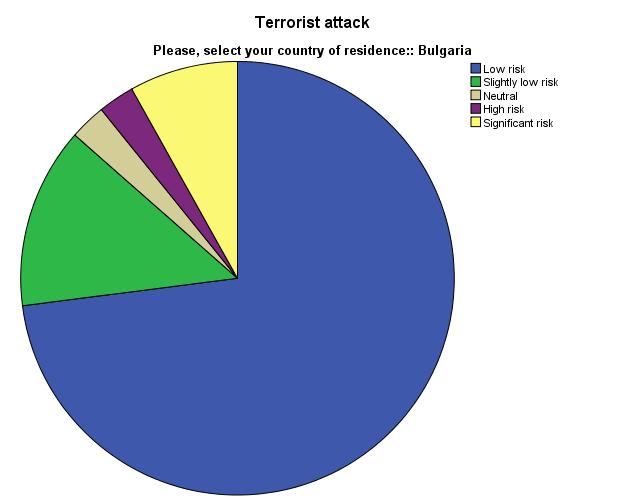
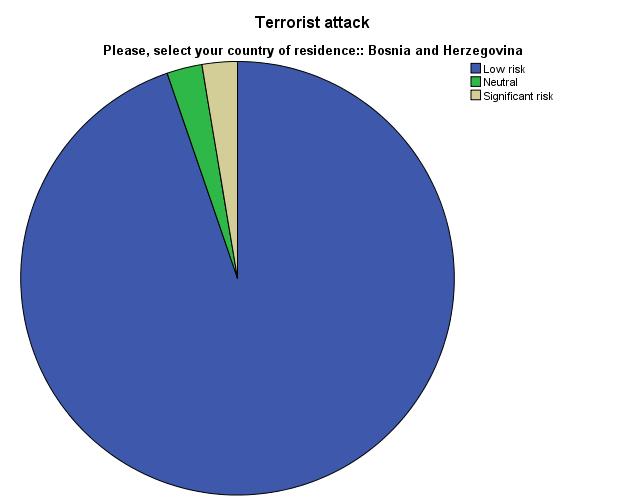
Total 90 100.0
Participants were also asked if they were at risk of terrorist attack, and most of them responded very low risk ranging from 94.7% for Bosnia, 73% for Bulgaria, 93.8% for Greece and 50% for Turkey. While those who
said that they were at very high risk had a very low frequency of 2.6% for Bosnia, 8.1% for Bulgaria, 0% for Greece and 12% for Turkey. While other ratios fall in between these two.

Bulgaria

Greece
Turkey
Table 12


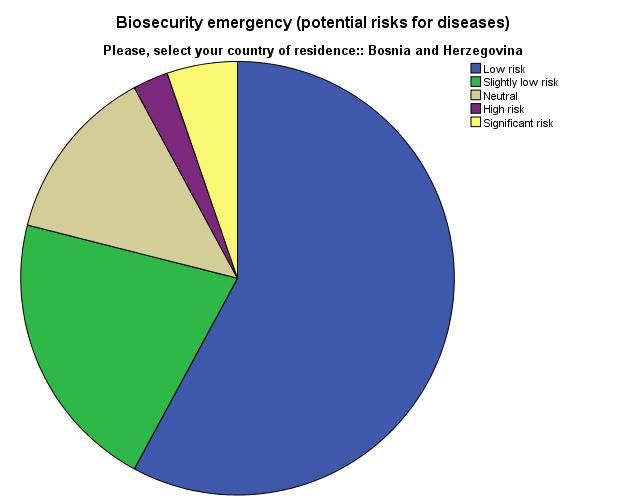
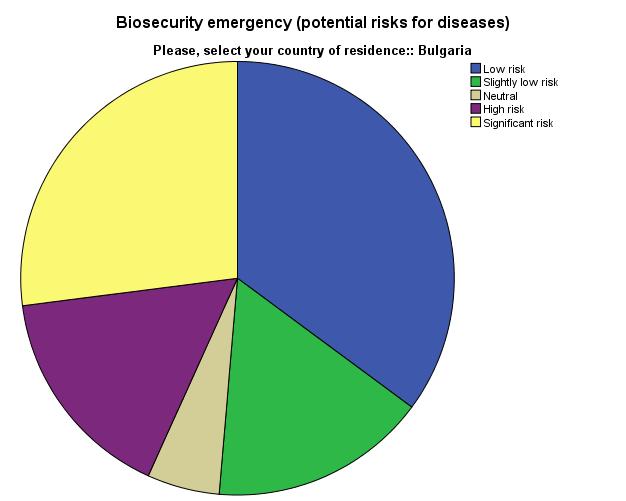
Frequency Percent
Low risk 22 57.9
Slightly low risk 8 21.1
Neutral 5 13.2 High risk 1 2.6 Significant risk 2 5.3
Total 38 100.0
Low risk 13 35.1
Slightly low risk 6 16.2
Neutral 2 5.4 High risk 6 16.2 Significant risk 10 27.0
Total 37 100.0
Low risk 20 41.7
Slightly low risk 10 20.8 Neutral 9 18.8 High risk 5 10.4 Significant risk 4 8.3
Total 48 100.0
Low risk 40 44.4
Slightly low risk 12 13.3 Neutral 22 24.4 High risk 6 6.7 Significant risk 10 11.1
Total 90 100.0
Participants were also asked if they had any biosecu rity emergency, most of them responded very low risk ranging from 57.9% for Bosnia, 35.1% for Bulgaria, 41.7% for Greece and 44.4% for Turkey. While those
who said that they were at very high risk had a very low frequency of 5.3% for Bosnia, 27% for Bulgaria, 8.3% for Greece and 11.1% for Turkey. While other ratios fall in between these two.
Bulgaria


Greece
Table 13

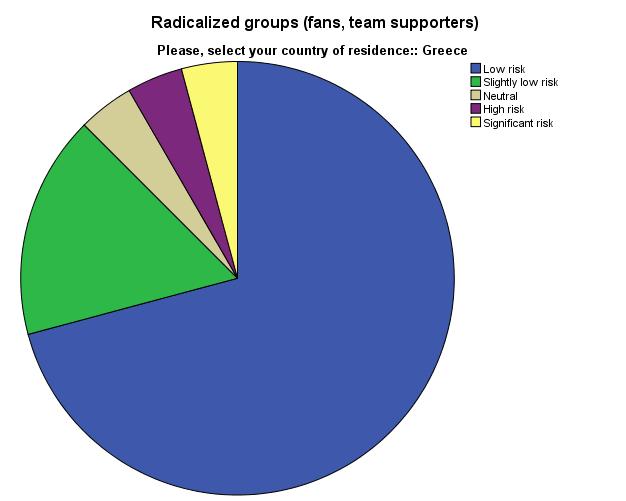
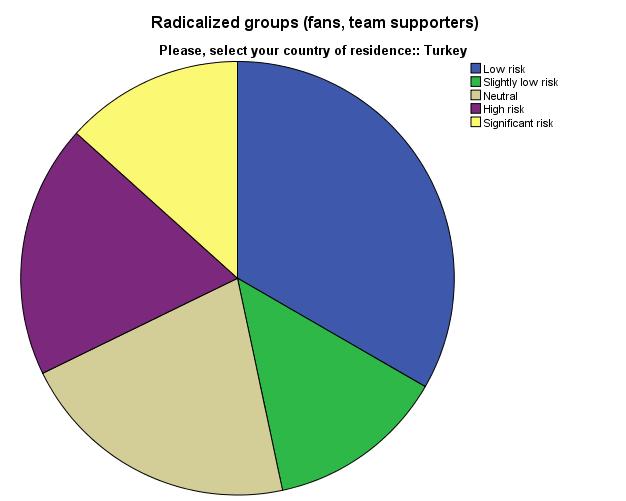

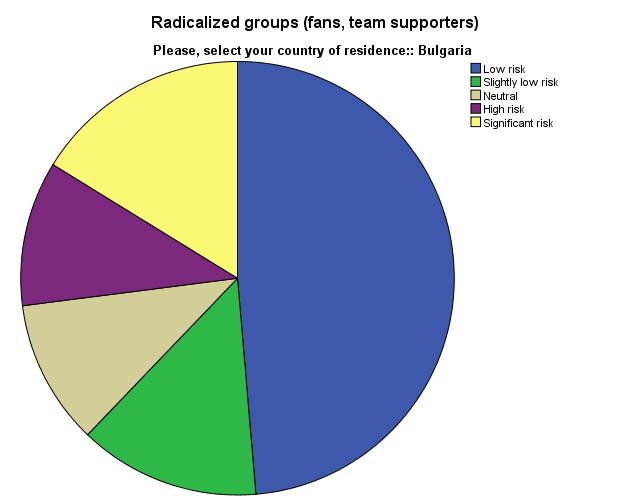
Low risk 25 65.8
Slightly low risk 4 10.5
Neutral 6 15.8 High risk 1 2.6 Significant risk 2 5.3
Total 38 100.0
Low risk 18 48.6
Slightly low risk 5 13.5
Neutral 4 10.8 High risk 4 10.8 Significant risk 6 16.2
Total 37 100.0
Low risk 34 70.8
Slightly low risk 8 16.7
Neutral 2 4.2 High risk 2 4.2 Significant risk 2 4.2
Total 48 100.0
Low risk 30 33.3
Slightly low risk 12 13.3
Neutral 19 21.1
High risk 17 18.9 Significant risk 12 13.3
Total 90 100.0
Participants were also asked if they were at risk of radicalized group, most of them responded very low risk ranging from 65.8% for Bosnia, 48.6% for Bulgaria, 70.8% for Greece and 33.3% for Turkey. While those
who said that they were at very high risk had a very low frequency of 5.3% for Bosnia, 16.2% for Bulgaria, 4.2% for Greece and 13.3% for Turkey. While other ratios fall in between these two.
Table 14
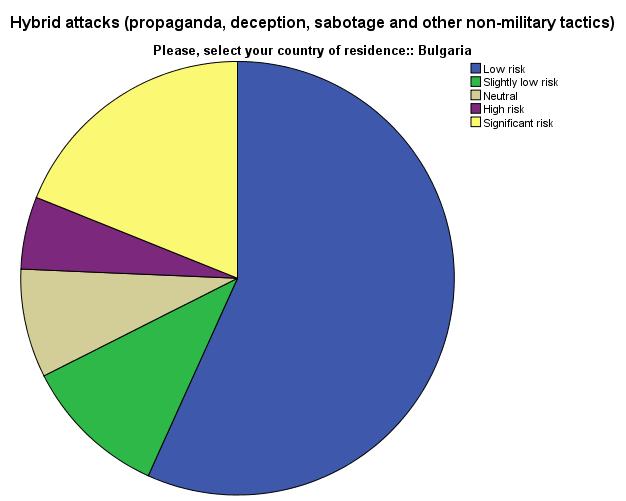

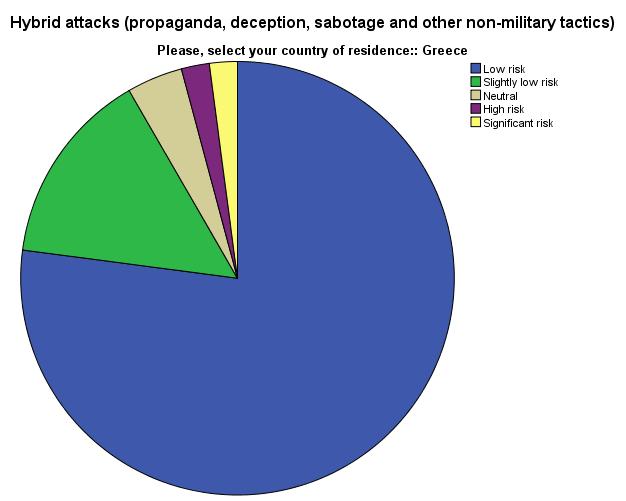
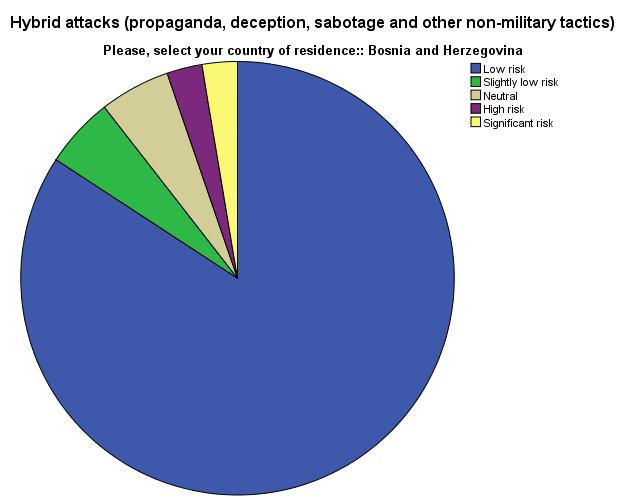
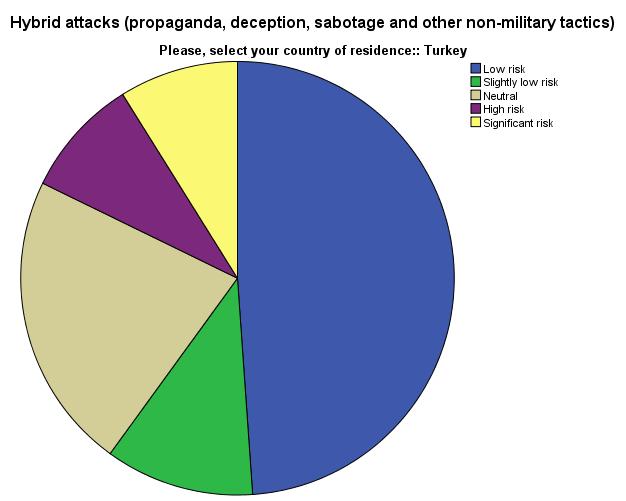
Frequency Percent
Low risk 32 84.2
Slightly low risk 2 5.3

Neutral 2 5.3 High risk 1 2.6 Significant risk 1 2.6
Total 38 100.0
Low risk 21 56.8
Bulgaria
Slightly low risk 4 10.8 Neutral 3 8.1 High risk 2 5.4 Significant risk 7 18.9
Total 37 100.0
Low risk 37 77.1
Slightly low risk 7 14.6
Greece
Neutral 2 4.2 High risk 1 2.1
Significant risk 1 2.1
Total 48 100.0
Low risk 44 48.9
Slightly low risk 10 11.1
Neutral 20 22.2 High risk 8 8.9 Significant risk 8 8.9
Total 90 100.0
Participants were also asked if they were at risk of hybrid attack, most of them responded very low risk ranging from 84.2% for Bosnia, 56.8% for Bulgaria, 77.1% for Greece and 48.9% for Turkey. While those
who said that they were at very high risk had a very low frequency of 2.6% for Bosnia, 18.9% for Bulgaria, 2.1% for Greece and 8.9% for Turkey. While other ratios fall in between these two.
Bulgaria


Greece
Turkey
Table 15

Most important 5 13.2
Important 4 10.5 Neutral 12 31.6 Less important 9 23.7 Least important 8 21.1
Total 38 100.0
Most important 3 8.1
Important 8 21.6 Neutral 9 24.3 Less important 12 32.4 Least important 5 13.5 Total 37 100.0
Most important 2 4.2
Important 7 14.6 Neutral 19 39.6 Less important 13 27.1 Least important 7 14.6 Total 48 100.0
Most important 11 12.2 Important 20 22.2 Neutral 24 26.7 Less important 21 23.3 Least important 14 15.6 Total 90 100.0
Participants were also asked if the winning opportunity for a national athlete was important or not, it was a combination of answers ranging from most important i.e. 13.2% for Bosnia, 8.1% for Bulgaria, 4.2% for Greece
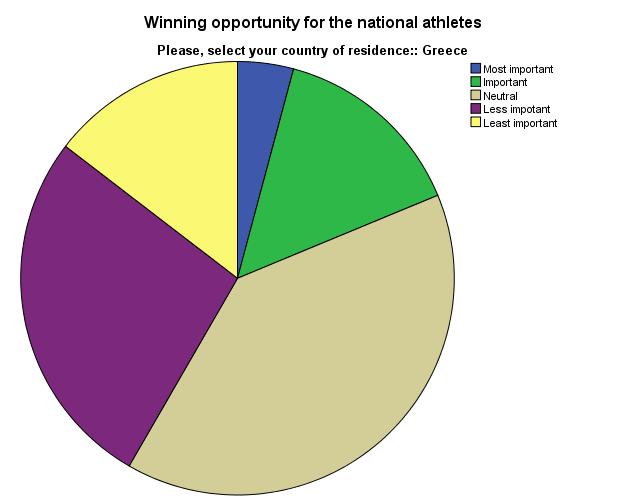
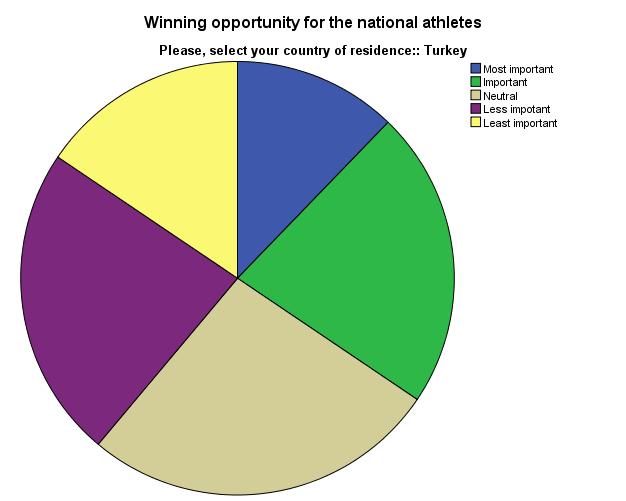
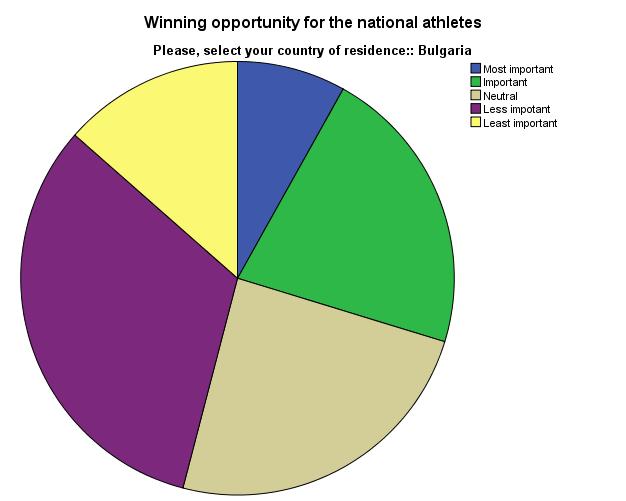
and 12.92% for Turkey. While in the least important it was 21.1% for Bosnia, 13.5% for Bulgaria, 14.6% for Greece and 15.6% for Turkey. While other ratios fall in between these two.
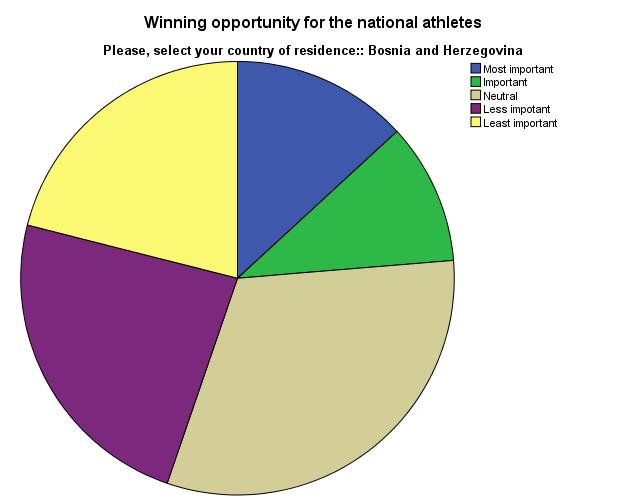

Bulgaria

Greece
Turkey
Table 16

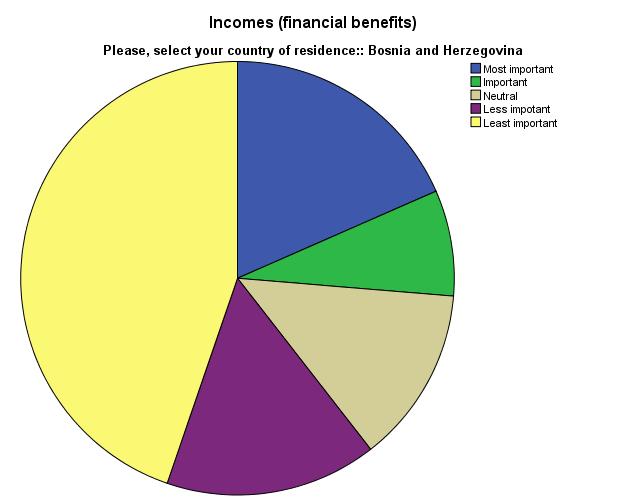


Frequency Percent
Most important 7 18.4
Important 3 7.9 Neutral 5 13.2 Less important 6 15.8 Least important 17 44.7
Total 38 100.0
Most important 5 13.5
Important 2 5.4 Neutral 5 13.5 Less important 6 16.2 Least important 19 51.4 Total 37 100.0
Most important 3 6.3
Important 2 4.2 Neutral 3 6.3 Less important 8 16.7 Least important 32 66.7 Total 48 100.0
Most important 26 28.9 Important 18 20.0 Neutral 17 18.9 Less important 12 13.3 Least important 17 18.9 Total 90 100.0
Participants were also asked if income was important or not, it was a combination of answers ranging from most important i.e. 18.4% for Bosnia, 13.5% for Bul garia, 6.3% for Greece and 28.9% for Turkey. While it
had more percentage of least important ranging from 44.7% for Bosnia, 51.4% for Bulgaria, 66.7% for Greece and 18.9% for Turkey. While other ratios fall in between these two.
Bulgaria


Greece
Turkey
Table 17

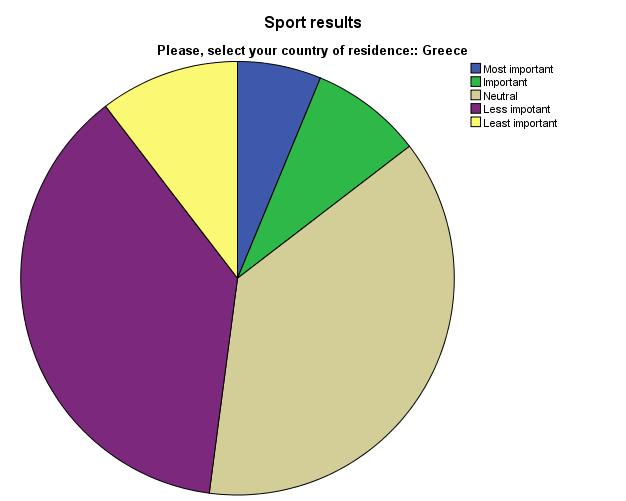
Frequency Percent
Most important 4 10.5
Important 7 18.4 Neutral 6 15.8 Less important 13 34.2 Least important 8 21.1
Total 38 100.0
Most important 4 10.8
Important 11 29.7 Neutral 11 29.7 Less important 8 21.6 Least important 3 8.1 Total 37 100.0
Most important 3 6.3
Important 4 8.3 Neutral 18 37.5 Less important 18 37.5 Least important 5 10.4 Total 48 100.0

Most important 18 20.0 Important 22 24.4 Neutral 12 13.3 Less important 22 24.4 Least important 16 17.8 Total 90 100.0
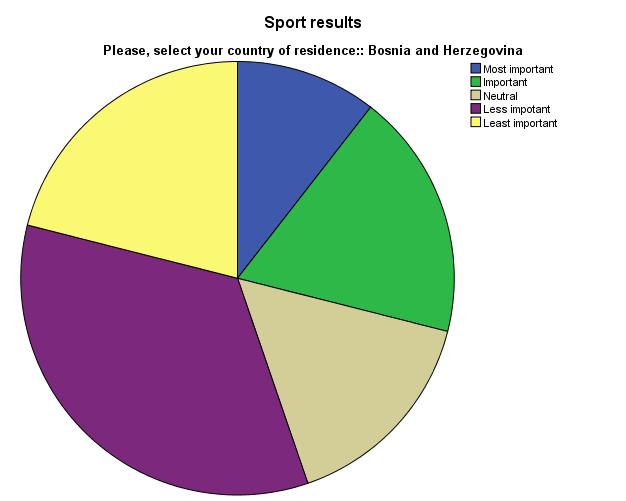

Participants were also asked if sports results were im portant or not, it was a combination of answers rang ing from most important i.e. 10.5% for Bosnia, 10.8% for Bulgaria, 6.3% for Greece and 20% for Turkey. While
it had more percentage of least important ranging from 21.1% for Bosnia, 8.1% for Bulgaria, 10.4% for Greece and 17.8% for Turkey. While other ratios fall in between these two.
Bulgaria
Greece
Turkey
Table 18



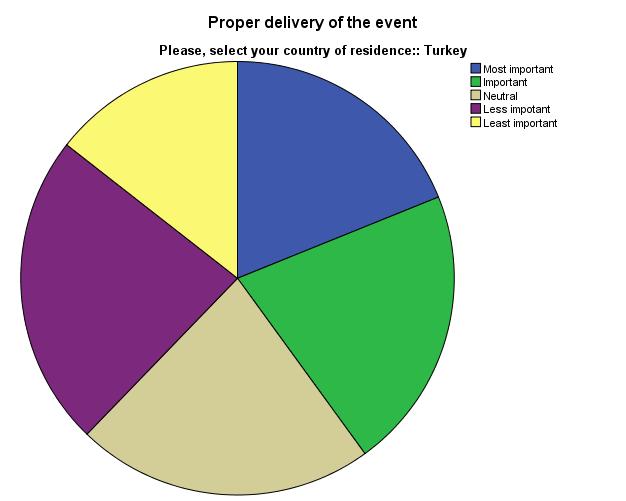
Most important 12 31.6
Important 16 42.1 Neutral 5 13.2 Less important 3 7.9 Least important 2 5.3
Total 38 100.0
Most important 19 51.4
Important 6 16.2 Neutral 5 13.5 Less important 5 13.5 Least important 2 5.4 Total 37 100.0
Most important 14 29.2
Important 24 50.0 Neutral 6 12.5 Less important 1 2.1 Least important 3 6.3 Total 48 100.0

Most important 17 18.9 Important 19 21.1 Neutral 20 22.2 Less important 21 23.3 Least important 13 14.4
Total 90 100.0
Participants were also asked if proper delivery of the event was important or not, most of the participants answered that it was very important for them i.e. 31.6% for Bosnia, 51.4% for Bulgaria, 29.2% for Greece
and 18.9% for Turkey. While it had more percentage of least important ranging from 5.3% for Bosnia, 5.4% for Bulgaria, 6.3% for Greece and 14.4% for Turkey. While other ratios fall in between these two.
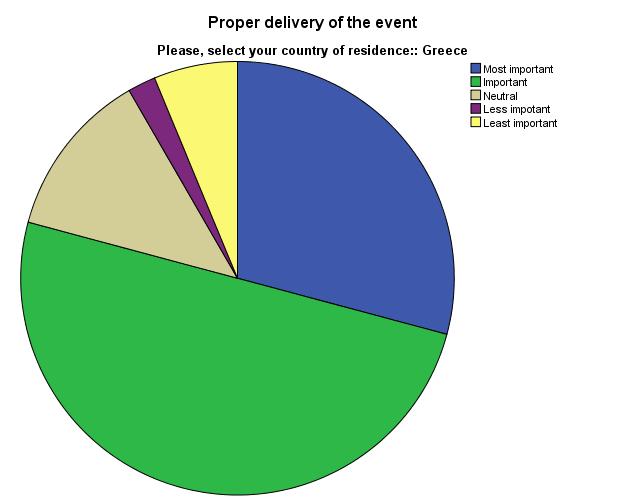
Bulgaria


Greece

Most important 10 26.3
Important 8 21.1 Neutral 10 26.3 Less important 7 18.4 Least important 3 7.9
Total 38 100.0
Most important 6 16.2
Important 10 27.0 Neutral 7 18.9 Less important 6 16.2 Least important 8 21.6 Total 37 100.0
Most important 26 54.2
Important 11 22.9 Neutral 2 4.2 Less important 8 16.7 Least important 1 2.1 Total 48 100.0
Most important 18 20.0
Important 11 12.2 Neutral 17 18.9 Less important 14 15.6 Least important 30 33.3
Total 90 100.0
Participants were also asked if ensuring the security of athletes and spectators was important or not, most of the participants answered that it was very important for them i.e. 26.3% for Bosnia, 16.2% for Bulgaria, 54.2% for

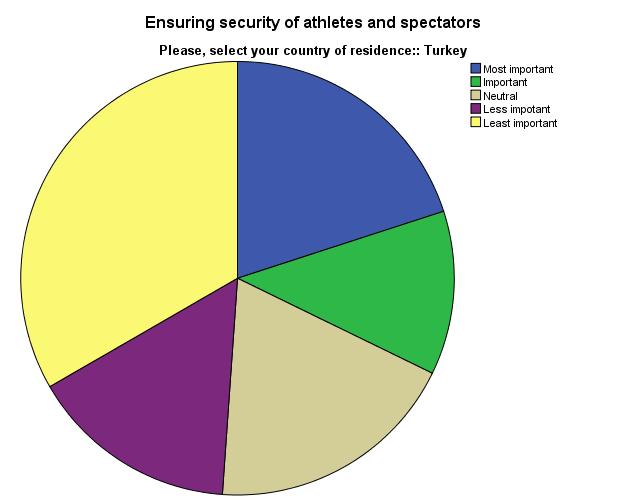

Greece and 20% for Turkey. While it had more percent age of least important ranging from 7.9% for Bosnia, 21.6% for Bulgaria, 2.1% for Greece and 33.3% for Tur key. While other ratios fall in between these two.
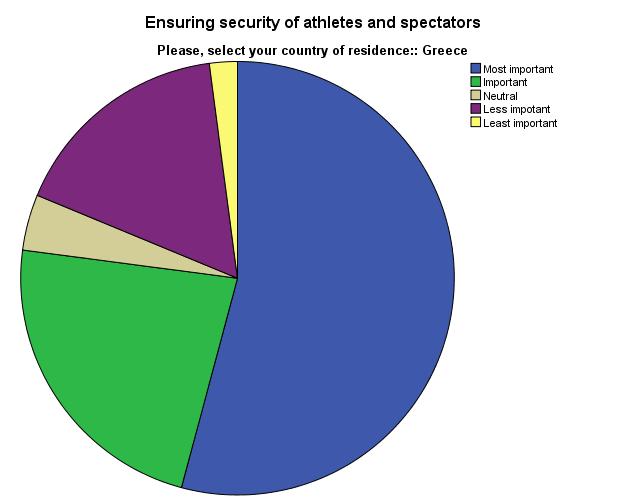
Table 20
If you are informed that there is a security risk at the event you are organizing, what would you do:
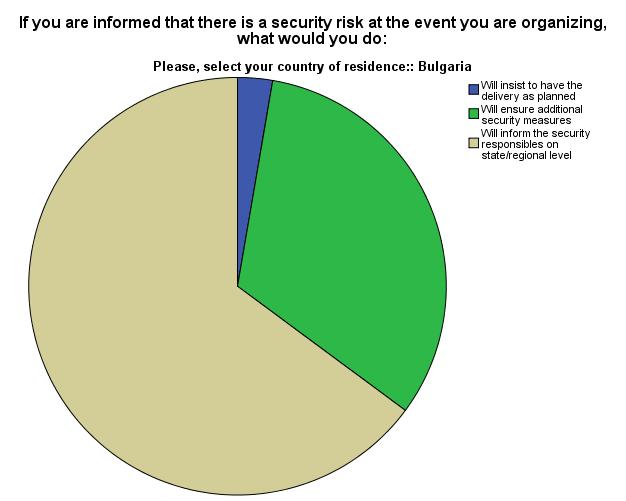

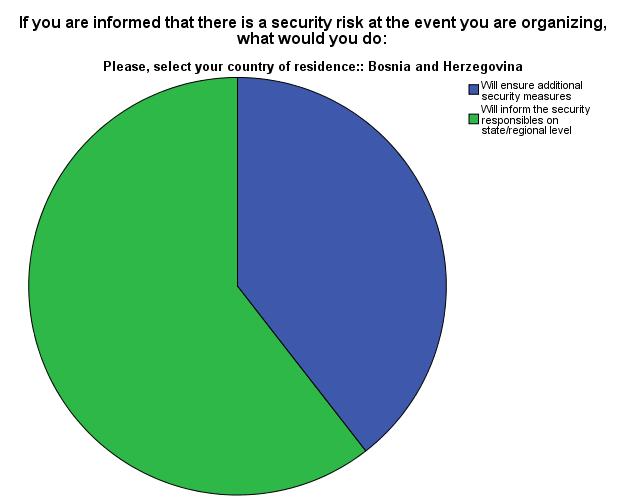


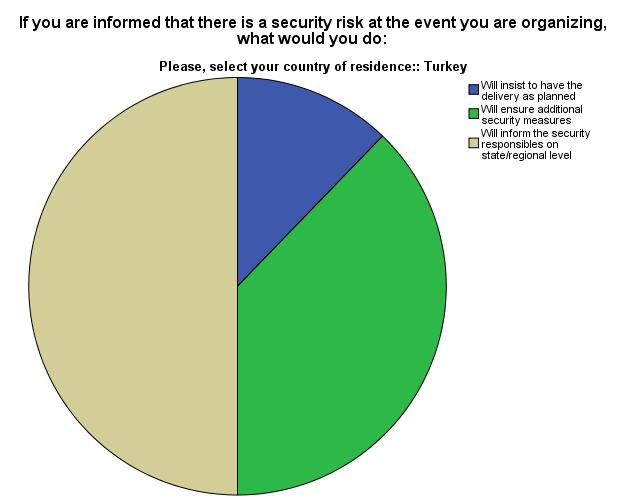
Country of residence: Responses
Bosnia and Herzegovina
Bulgaria
Greece
Turkey
Frequency Percent
Will ensure additional security measures 15 39.5 Will inform the security responsible on the state/regional level 23 60.5
Total 38 100.0
Will insist to have the delivery as planned 1 2.7 Will ensure additional security measures 12 32.4 Will inform the security responsible on the state/regional level 24 64.9
Total 37 100.0
Will insist to have the delivery as planned 1 2.1
Will ensure additional security measures 13 27.1 Will inform the security responsible on the state/regional level 34 70.8
Total 48 100.0
Will insist to have the delivery as planned 11 12.2
Will ensure additional security measures 34 37.8 Will inform the security responsible on the state/regional level 45 50.0
Total 90 100.0
Another question was ‘If you are informed that there is a security risk at the event you are organizing, what would you do’; participants who said ‘Will insist to have the delivery as planned’ were 2.7% from Bulgaria, 2.1% from Greece and 12.2% from Turkey. Participants who answered ‘will ensure additional security measures’
were 39.5% from Bosnia, 32.4% from Bulgaria, 27.1% from Greece and 37.8% from Turkey. Participants who answered ‘ will inform the security responsible on state/regional level’ were 60.5% from Bosnia, 64.9% from Bulgaria, 70.8% from Greece and 50% from Turkey.
Table 21
In your budget plans, are you counting on safety and security as an important factor?
Country of residence: Responses

Bosnia and Herzegovina
Bulgaria
Greece
Turkey
Frequency Percent
No 10 26.3 Yes 16 42.1 Don’t have the information 12 31.6
Total 38 100.0
No 6 16.2 Yes 18 48.6
Don’t have the information 13 35.1 Total 37 100.0


No 6 12.5 Yes 30 62.5
Don’t have the information 12 25.0 Total 48 100.0
No 16 17.8 Yes 58 64.4
Don’t have the information 16 17.8 Total 90 100.0
Another question was ‘In your budget plans, are you counting on safety and security as an important factor; participants who said ‘No’ were 26.3% participants from Bosnia while 16.2% from Bulgaria, 12.5% from Greece and 17.8% from Turkey. Participants who

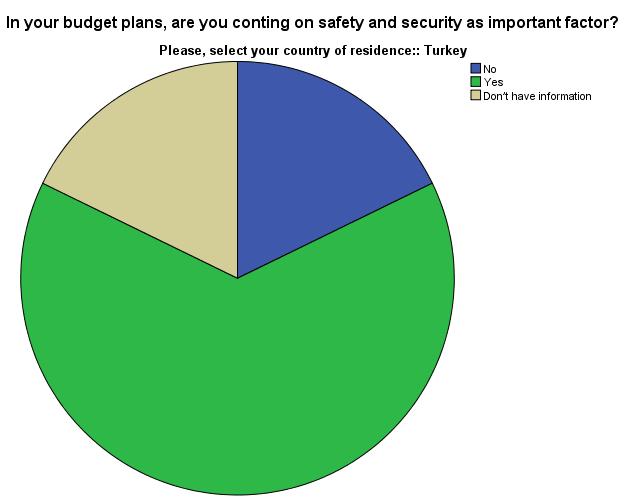
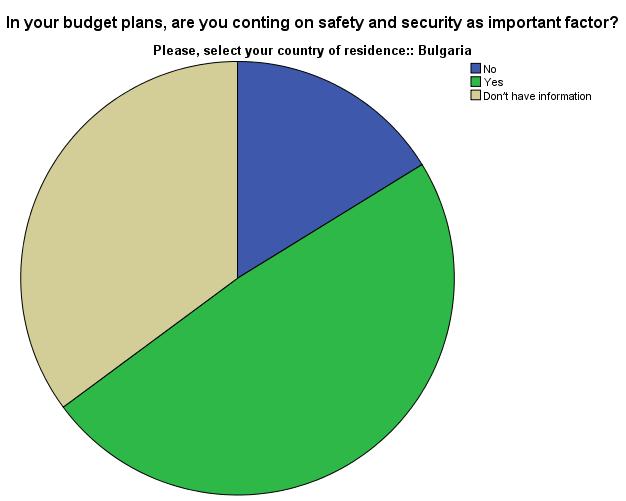
answered ‘Yes’ were 42.1% from Bosnia, 48.6% from Bulgaria, 62.5% from Greece and 64.5% from Turkey. While others said that they don’t have any information about it.
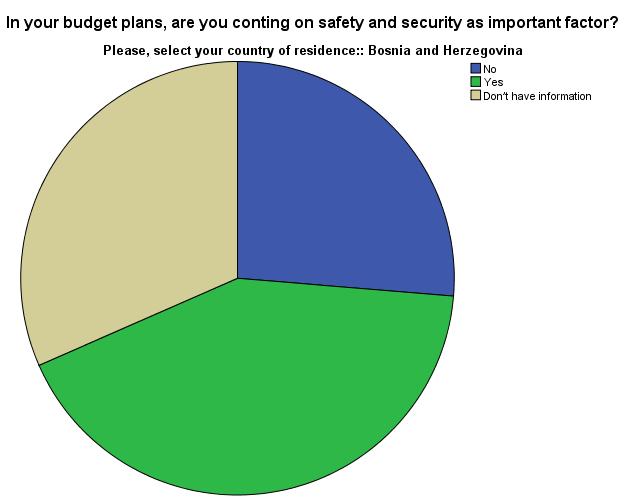
Table 22
Have you ever had a problem with security during events you organized?
Country of residence: Responses
Bosnia and Herzegovina
Frequency Percent
No 32 84.2 Yes 6 15.8
Total 38 100.0
Bulgaria No 31 83.8 Yes 6 16.2
Total 37 100.0
Greece No 43 89.6 Yes 5 10.4


Total 48 100.0
Turkey No 72 80.0 Yes 18 20.0 Total 90 100.0
Another question was ‘Have you ever had a problem with security during events you organized; participants who said ‘No’ were 84.2% participants from Bosnia, 83.8% from Bulgaria, 89.6% from Greece and 80% from

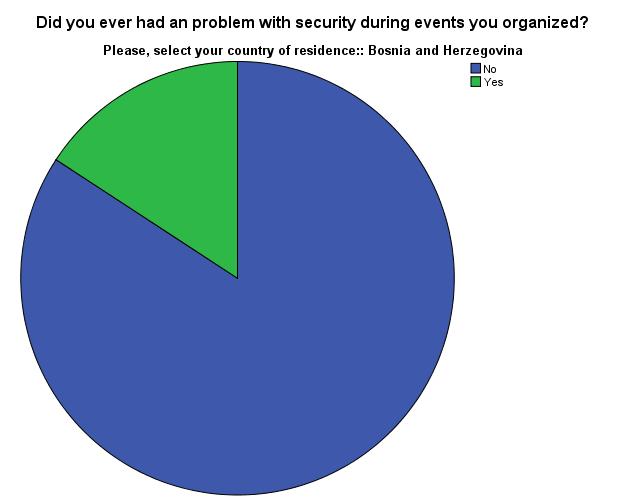
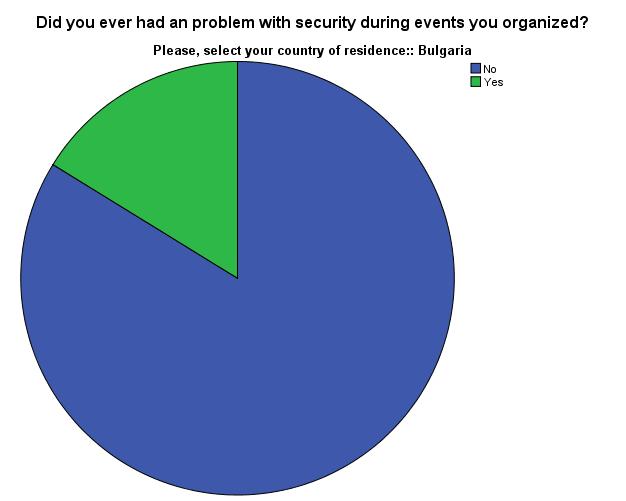
Turkey. Participants who answered ‘Yes’ were 15.8% from Bosnia, 16.2% from Bulgaria, 10.4% from Greece and 20% from Turkey.
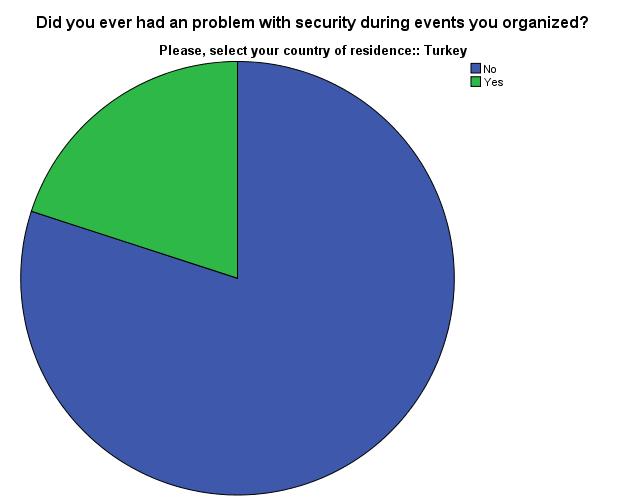
Table 23
Are you interested to take part in safety and security training opportunities regarding the organization of sports events: Country of residence: Responses Frequency Percent


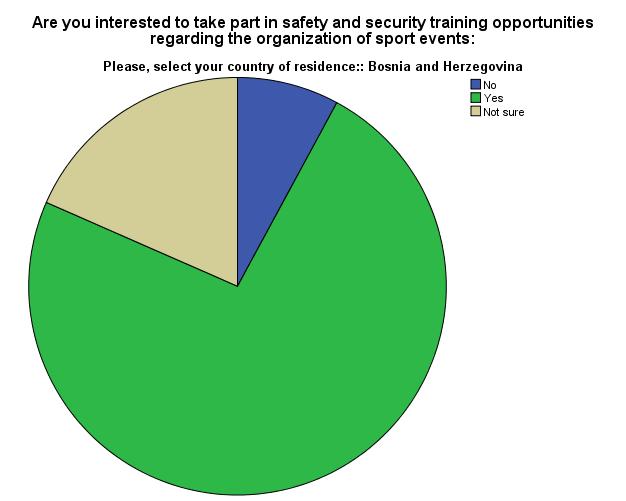
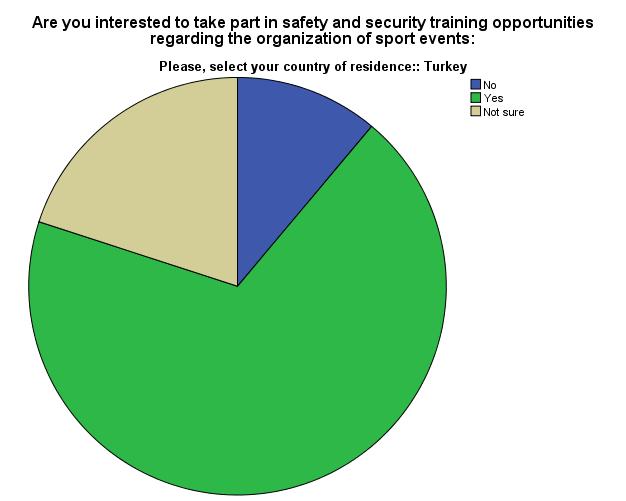


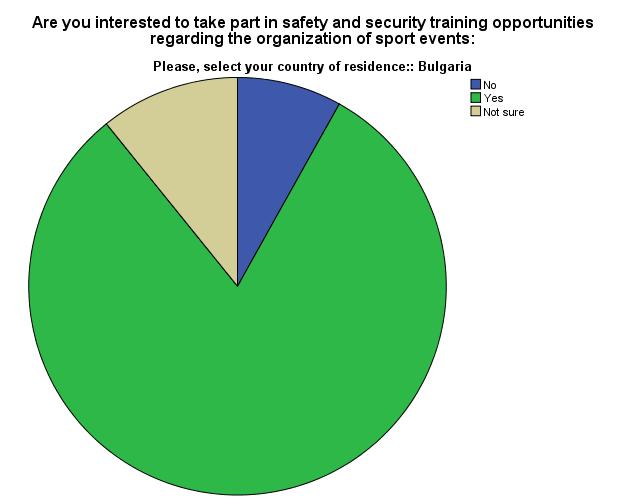
Bosnia and Herzegovina
No 3 7.9 Yes 28 73.7 Not sure 7 18.4
Total 38 100.0
Bulgaria
Greece
Turkey
No 3 8.1 Yes 30 81.1 Not sure 4 10.8
Total 37 100.0
No 4 8.3 Yes 35 72.9 Not sure 9 18.8 Total 48 100.0
No 10 11.1 Yes 62 68.9 Not sure 18 20.0
Total 90 100.0
Another question was ‘Are you interested to take part in safety and security training opportunities regarding the organization of sports events; participants who said ‘No’ were 7.9% participants from Bosnia,8.1% from Bulgaria, 8.3% from Greece and 11.1% from Turkey.
Participants who answered ‘Yes’ were 73.7% from Bosnia, 81.1% from Bulgaria, 72.9% from Greece and 68.9% from Turkey. While others answered that they are not sure about it.
Table 1
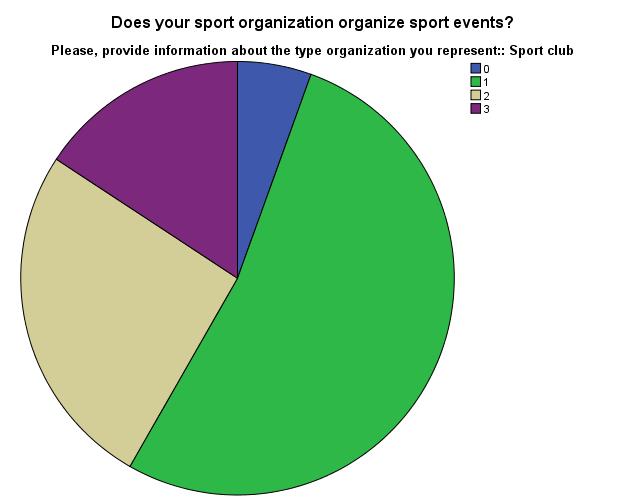
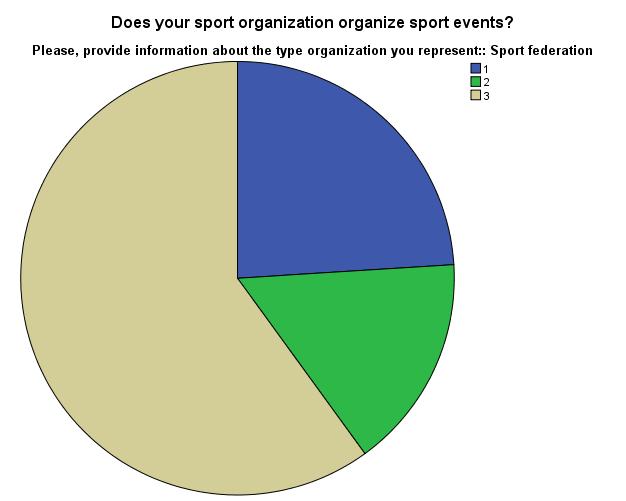
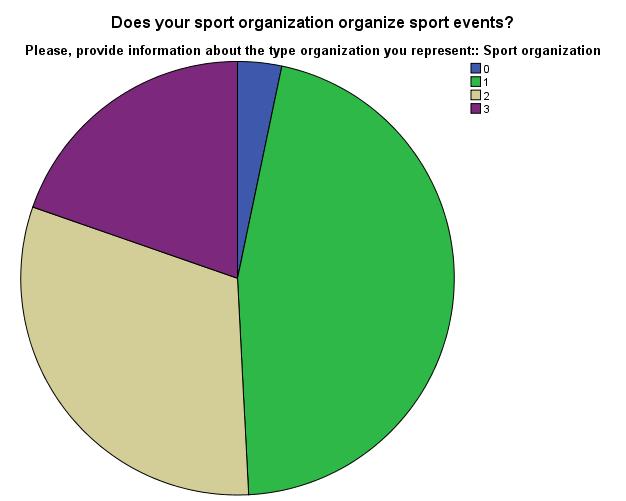
Organization Type Responses

Sport club
Sport federation
Sport organization
Frequency Percent
No 7 5.5
Yes, on local level 67 52.8 Yes, on National level 33 26.0 Yes, on International level 20 15.7
Total 127 100.0

Yes, on local level 6 24.0
Yes, on National level 4 16.0 Yes, on International level 15 60.0
Total 25 100.0
No 2 3.3
Yes, on local level 28 45.9 Yes, on National level 19 31.1 Yes, on International level 12 19.7
Total 61 100.0
Just like countries participants were segregated based on the type of organization they represent. There were three types of organizations that are; sports clubs, sport federation and sports organizations. So these tables and figures are analyzed based on differences in organi zation type. As mentioned in Table 1. The first question was about that either their sports organization organ ize sports events. 5.5% of participants of sports clubs and 3.3% of sport organization answered ‘No’ to this
question. 52.8% from sports clubs, 24% from sports fed erations and 45.9% from sport organization answered that such events are organized on the local level. While 26% from sports clubs, 16% from sports federations and 31.1% from sport organization said that such events oc cur on the National level. Similarly, those who answered that these events occur on the International level were 15.7% from sports clubs, 60% from sports federations and 19.7% from sport organization.
Table 2
Organization Type Responses
Sport club
Sport federation
Sport organization

Frequency Percent
No 27 21.3 Yes 59 46.5 Sometimes, but not for all events we are organizing 41 32.3


Total 127 100.0
No 6 24.0 Yes 4 16.0 Sometimes, but not for all events we are organizing 15 60.0 Total 25 100.0
No 8 13.1 Yes 26 42.6 Sometimes, but not for all events we are organizing 27 44.3 Total 61 100.0
As mentioned in Table 2. The second question was about that whether their sports organization imple ments a risk assessment before the delivery of each sports event. 21.3% of participants of sports clubs, 24% from sports federations and 13.1% of sport organiza tion answered ‘No’ to this question. 46.5% from sports
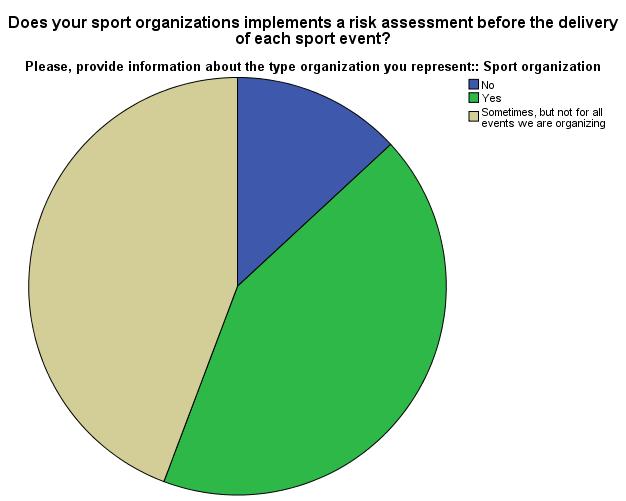

clubs, 16% from sports federations and 42.6% from sport organization answered “Yes” to this question. While 32.3% from sports clubs, 60% from sports fed erations and 44.3% from sport organization said that Sometimes, but not for all events we are organizing.
 Do your sports organizations implement a risk assessment before the delivery of each sports event?
Do your sports organizations implement a risk assessment before the delivery of each sports event?
Table 3
assessment is implemented in the following phases of the delivery of sports events:

Frequency Percent
No risk assessment is implemented 23 18.1
Risk assessment of the preparation activities of the delivery of sports event 22 17.3
Risk assessment of the delivery activities of the delivery of sports event 18 14.2
During all the stages of sports event delivery 64 50.4
Total 127 100.0
No risk assessment is implemented 7 28.0
Risk assessment of the preparation activities of the delivery of sports event 5 20.0
Risk assessment of the delivery activities of the delivery of sports event 4 16.0
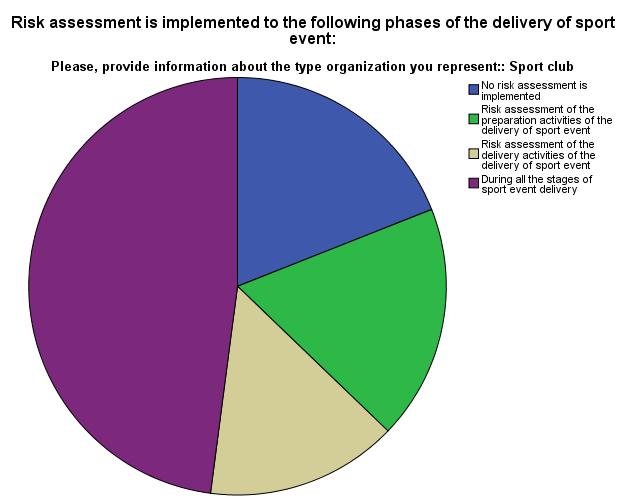
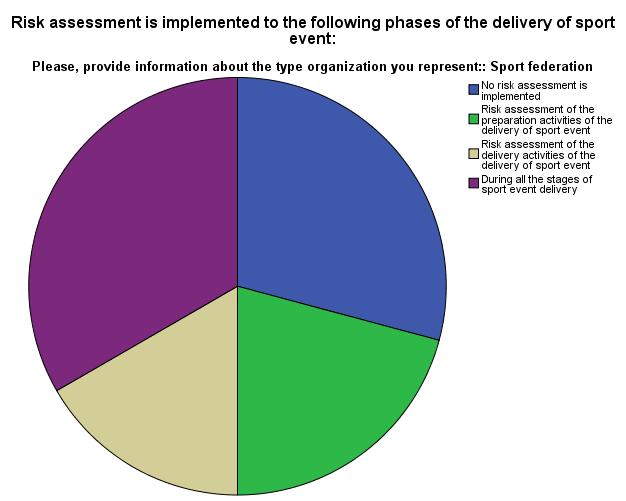
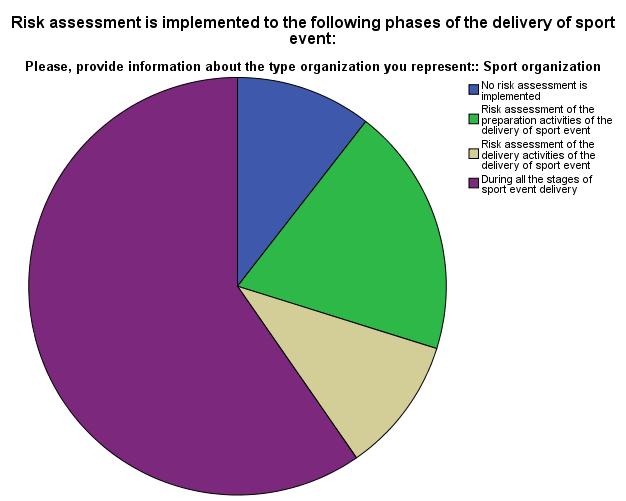
During all the stages of sports event delivery 9 36.0
Total 25 100.0

No risk assessment is implemented 6 9.8
Risk assessment of the preparation activities of the delivery of sports event 11 18.0
Risk assessment of the delivery activities of the delivery of sports event 6 9.8 During all the stages of sports event delivery 38 62.3
Total 61 100.0
As mentioned in Table 3. The third question was about whether their risk assessment is implemented to the above phases in the delivery of the sports events. 18.1% of participants of sports clubs, 28% from sports federations and 9.8% of sports organizations answered ‘No risk assessment is implemented’ to this question. 17.3% from sports clubs, 20% from sports federations and 18% from sport organization answered that ‘Risk
assessment of the preparation activities of the delivery of sports events’. While 14.2% from sports clubs, 16% from sports federations and 9.8% from sports organ izations said that ‘Risk assessment of the delivery ac tivities of the delivery of sports events’. Similarly, those who answered that During all the stages of sports event delivery were 50.4% from sports clubs, 36% from sports federations and 62.3% from sport organization.
Table 4
Organization type Responses
Sport club
Frequency Percent
No 63 49.6 Yes, we are counting on external safety and security expert 64 50.4
Total 127 100.0
Sport federation No 12 48.0 Yes, we are counting on external safety and security expert 13 52.0 Total 25 100.0
Sport organization No 18 29.5 Yes, we are counting on external safety and security expert 43 70.5



Total 61 100.0
As mentioned in Table 4. Forth question was about that either their organization can count on safety and security experts in order to ensure safe sports events. 49.6% of participants of sports clubs, 48% of partic ipants of sports federations and 29.5% from sports
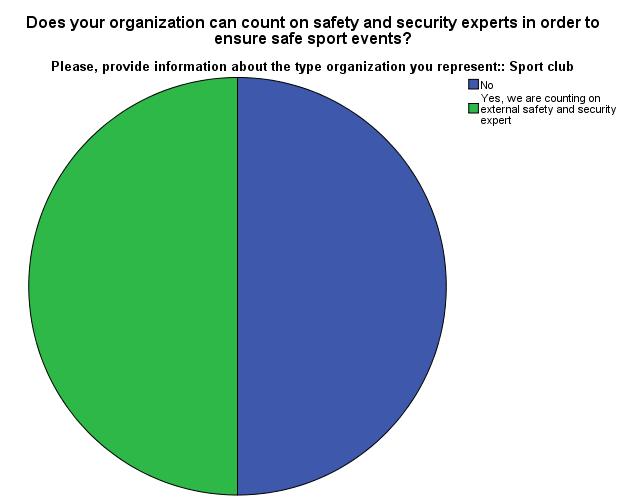
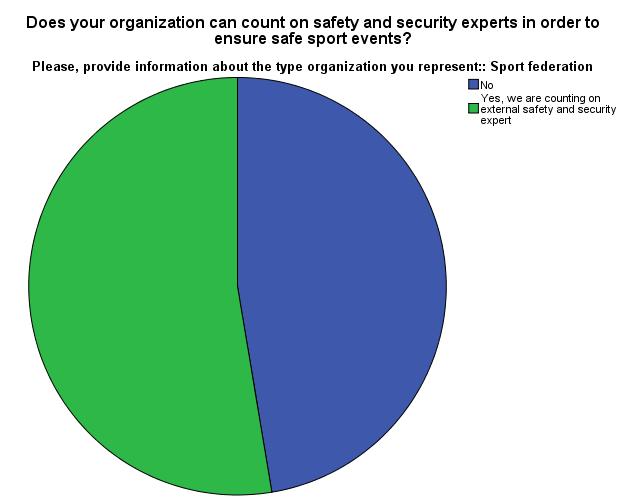
federations and 9.8% of sports organizations answered ‘No’ to this question. 50.4% from sports clubs, 52% from sports federations and 70.5% from sports organi zations answered that ‘Yes, we are counting on exter nal safety and security expert’.
 Does your organization count on safety and security experts in order to ensure safe sports events?
Does your organization count on safety and security experts in order to ensure safe sports events?
Does
Table 5
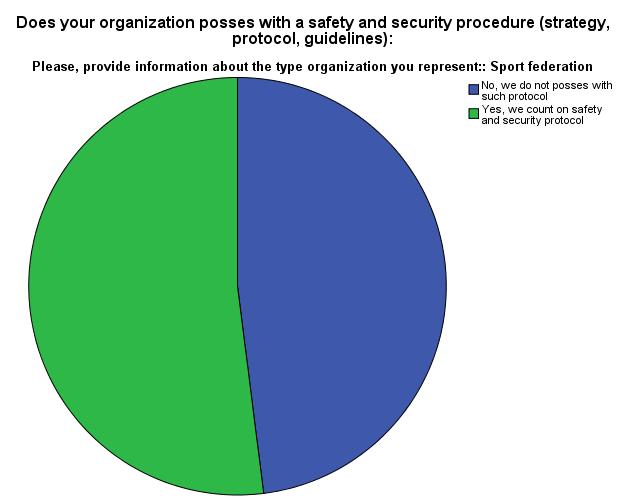
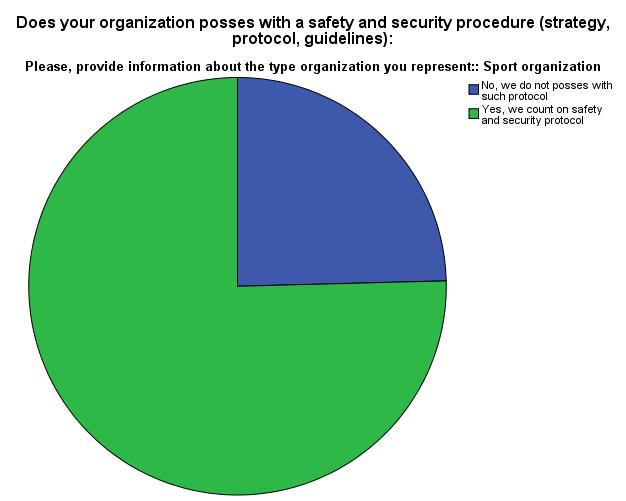
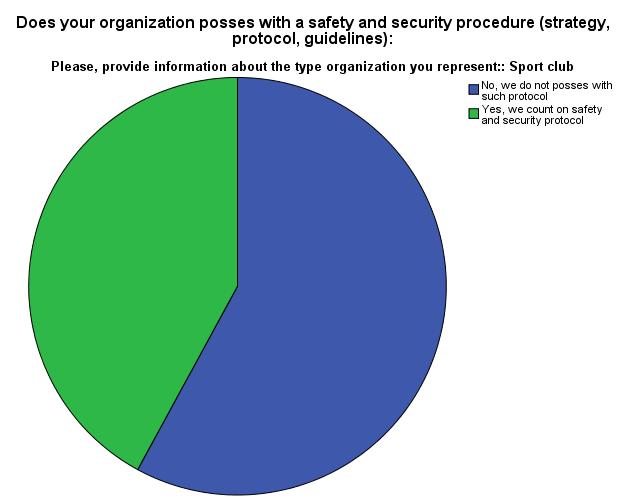
Organization type Responses

Sport club
Sport federation
Sport organization
Frequency Percent
No, we do not posses such protocol 73 57.5 Yes, we count on safety and security protocol 54 42.5

Total 127 100.0
No, we do not posses such protocol 12 48.0 Yes, we count on safety and security protocol 13 52.0 Total 25 100.0
No, we do not posses such protocol 15 24.6 Yes, we count on safety and security protocol 46 75.4
Total 61 100.0
As mentioned in Table 5. The fifth question was about whether their organization possesses a safety and security procedure (strategy, protocol and guidelines. 57.5% of participants of sports clubs, 48% from sports federations and 24.6% of sports organizations
answered ‘No, we do not possess such protocol’ to this question. 42.5% from sports clubs, 52% from sports federations and 75.4% from sports organizations answered that ‘Yes, we count on safety and security protocol’.
Sport club
Sport federation
Sport organization

Table 6
Frequency Percent
No, we do not have such practice 67 52.8 Yes, on a regular basis 19 15.0 Yes, before the delivery of the concrete sports event 41 32.3
Total 127 100.0
No, we do not have such practice 10 40.0 Yes, on a regular basis 5 20.0 Yes, before the delivery of the concrete sports event 10 40.0
Total 25 100.0
No, we do not have such practice 23 37.7 Yes, on a regular basis 13 21.3 Yes, before the delivery of the concrete sports event 25 41.0


Total 61 100.0
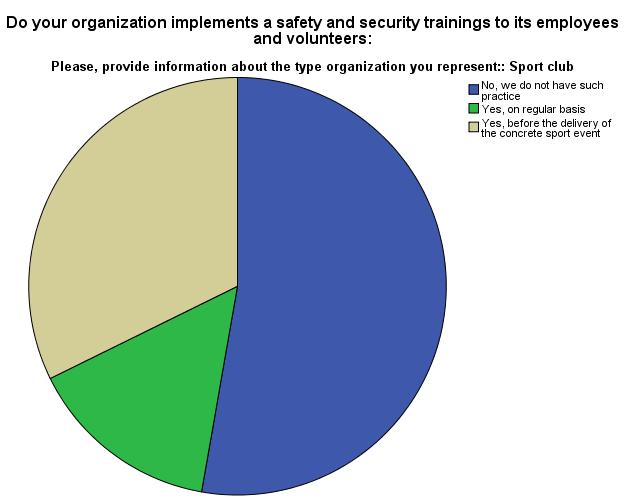
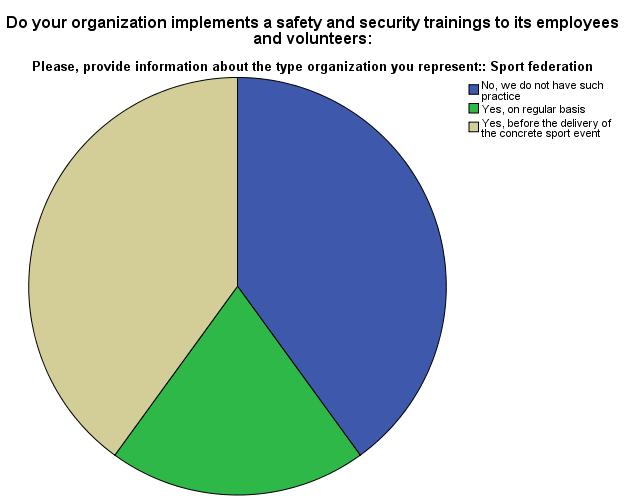
we do not have such practice’ to this question. 21.3% of sports organizations said that ‘yes, on regular basis’. 32.3% from sports clubs, 40% from sports federations and 41% from sport organization answered that ‘Yes, before the delivery of the concrete sports events’.
 Does your organization implements safety and security training for its employees and volunteers: Organization Type Responses
Does your organization implements safety and security training for its employees and volunteers: Organization Type Responses
Sport federation

Table 7
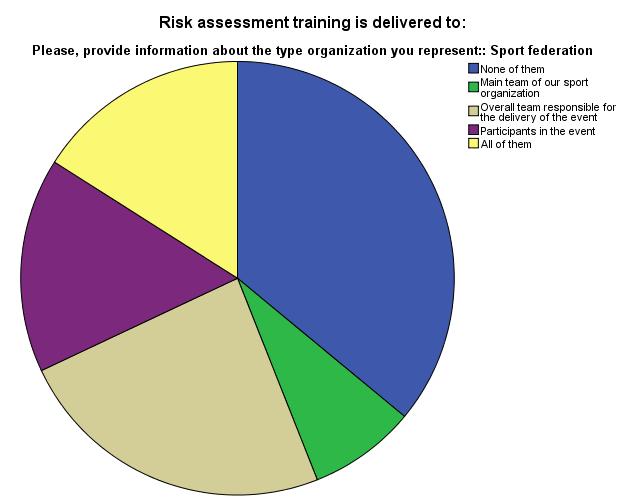

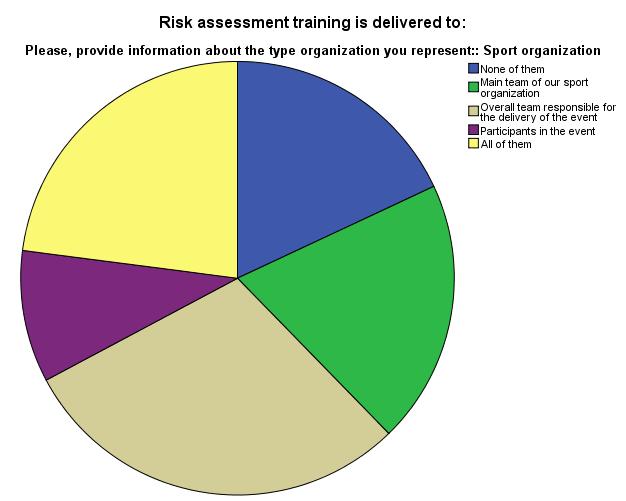
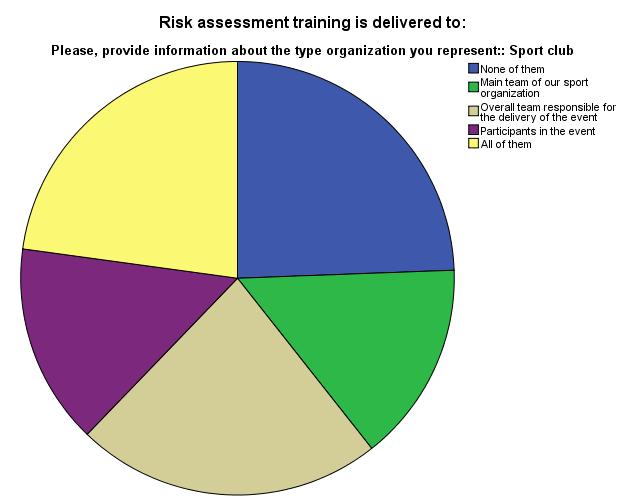
Frequency
None of them 31 24.4
The main team of our sports organization 19 15.0
The overall team responsible for the delivery of the event 29 22.8
Participants in the event 19 15.0 All of them 29 22.8
Total 127 100.0
None of them 9 36.0
The main team of our sports organization 2 8.0
The overall team responsible for the delivery of the event 6 24.0
Participants in the event 4 16.0 All of them 4 16.0
Total 25 100.0
None of them 11 18.0
The main team of our sports organization 12 19.7
The overall team responsible for the delivery of the event 18 29.5
Participants in the event 6 9.8 All of them 14 23.0
Total 61 100.0
As mentioned in Table 7. The seventh question was about whether risk assessment training is delivered. 24.4% of participants of sports clubs, 36% from sports federations and 18% of sports organizations answered ‘None of them’. 15% from sports clubs, 8% from sports federations and 19.7% from sport organization answered that ‘Main team of our sports organizations’. While 22.8% from sports clubs, 24%
from sports federations and 29.5% from sports organiza tions said that ‘Overall team responsible for the delivery of the event’. Similarly, those who answered that Participants in the event were 15% from sports clubs, 16% from sports federations and 9.8% from sports organizations. Also, 22.8% from sports clubs, 16% from sports federations and 23% from sports organizations said that ‘All of them’.
Table 8
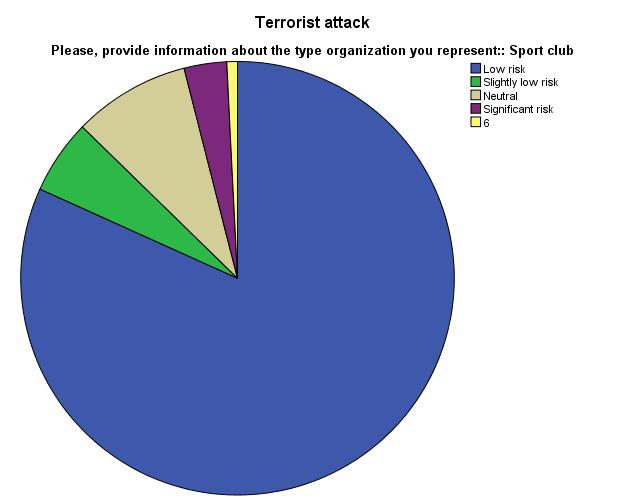
Organization Type Responses
Sport club
Sport federation

Sport organization
Frequency Percent
Low risk 103 81.1


Slightly low risk 7 5.5 Neutral 12 9.5 Significant risk 5 3.9
Total 127 100.0
Low risk 15 60.0
Slightly low risk 1 4.0 Neutral 5 20.0 High risk 1 4.0 Significant risk 3 12.0 Total 25 100.0
Low risk 35 57.4
Slightly low risk 3 4.9 Neutral 14 23.0 High risk 3 4.9 Significant risk 6 9.8 Total 61 100.0

As mentioned in Table 8. The eighth question was about a terrorist attack. 81.1% of participants of sports clubs, 60% from sports federations and 57.4% of sports organizations answered ‘Low risk’. 5.5% from sports clubs, 4% from sports federations and 4.9% from sports organizations answered that ‘Slightly low risk’. While 9.5% from sports clubs, 20% from sports
federations and 23% from sports organizations said ‘Neutral’. Similarly, those who answered that ‘High Risk’ were 4% from sports federations and 4.9% from sports organizations. Also, 3.9% from sports clubs, 12% from sports federations and 9.8% from sports organizations said that ‘Significant Risk’.
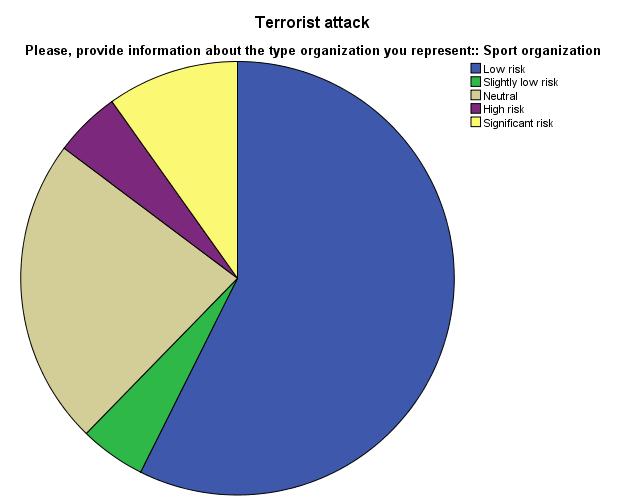
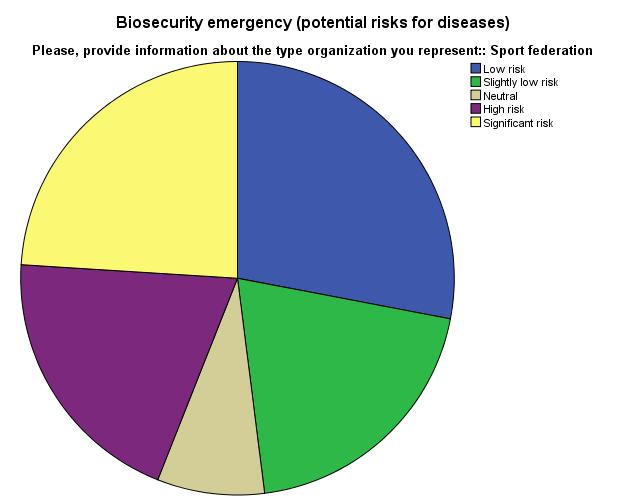
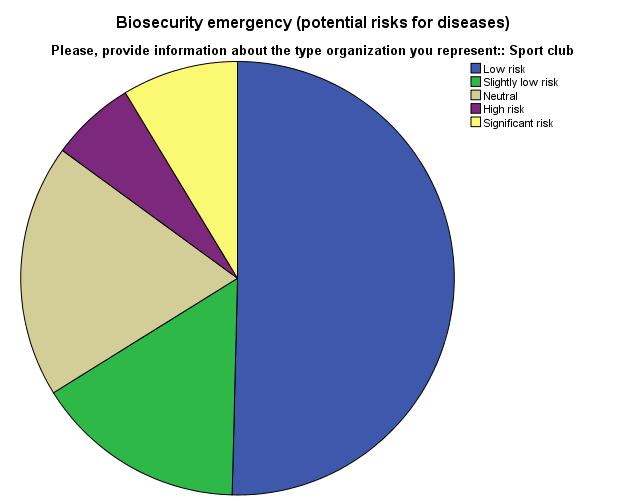
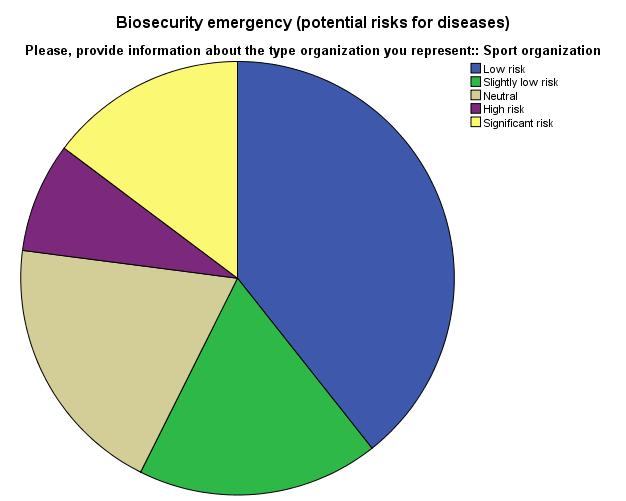

Sport federation
Sport organization

Frequency Percent
Low risk 64 50.4
Slightly low risk 20 15.7
Neutral 24 18.9
High risk 8 6.3 Significant risk 11 8.7
Total 127 100.0
Low risk 7 28.0
Slightly low risk 5 20.0
Neutral 2 8.0 High risk 5 20.0 Significant risk 6 24.0
Total 25 100.0
Low risk 24 39.3
Slightly low risk 11 18.0
Neutral 12 19.7 High risk 5 8.2 Significant risk 9 14.8
Total 61 100.0
As mentioned in Table 9. The ninth question was about Biosecurity Emergency. 50.4% of participants of sports clubs, 28% from sports federations and 39.3% of sports organizations answered ‘Low risk’. 15.7% from sports clubs, 20% from sports federations and 18% from sports organizations answered that ‘Slightly low risk’. While 18.9% from sports clubs, 8% from sports
federations and 19.7% from sports organizations said that ‘Neutral’. Similarly, those who answered that ‘High Risk’ were 6.3% from sports clubs, 20% from sports federations and 8.2% from sports organizations. Also, 8.7% from sports clubs, 24% from sports federations and 14.8% from sports organizations said that ‘Signifi cant Risk’
Sport federation
Sport organization

Table 10
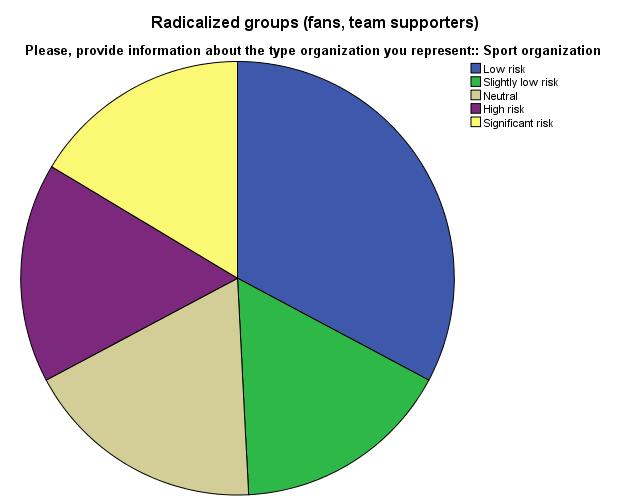
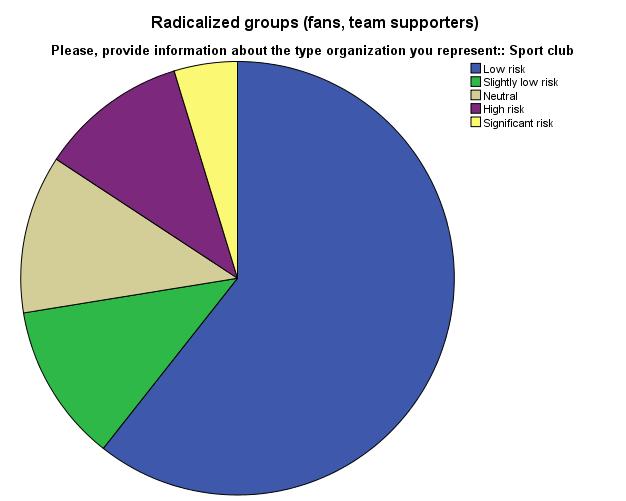
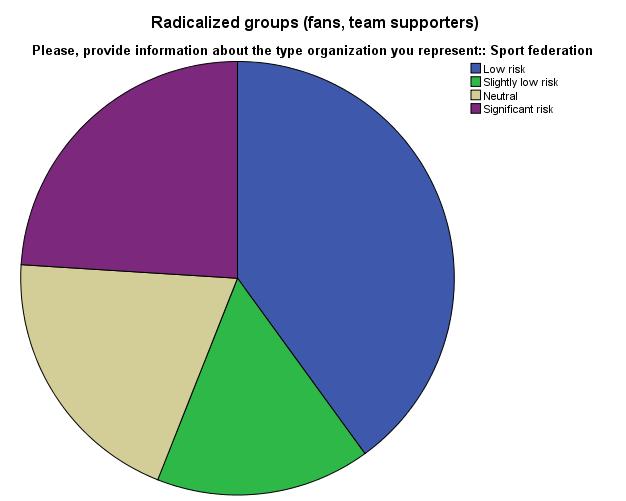
Frequency Percent
Low risk 77 60.6
Slightly low risk 15 11.8
Neutral 15 11.8
High risk 14 11.0 Significant risk 6 4.7
Total 127 100.0
Low risk 10 40.0
Slightly low risk 4 16.0
Neutral 5 20.0 Significant risk 6 24.0


Total 25 100.0
Low risk 20 32.8
Slightly low risk 10 16.4
Neutral 11 18.0
High risk 10 16.4 Significant risk 10 16.4
Total 61 100.0
As mentioned in Table 10. The tenth question was about Radicalized groups. 60.6% of participants of sports clubs, 40% from sports federations and 32.8% of sports organizations answered ‘Low risk’. 11.8% from sports clubs, 16% from sports federations and 16.4% from sports organizations answered that ‘Slight ly low risk’. While 11.8% from sports clubs, 20% from
sports federations and 18% from sports organizations said ‘Neutral’. Similarly, those who answered that ‘High Risk’ were 11% from sports clubs, and 16.4% from sport organization. Also, 4.7% from sports clubs, 24% from sports federations and 16.4% from sports organi zations said that ‘Significant Risk’.
Table 11
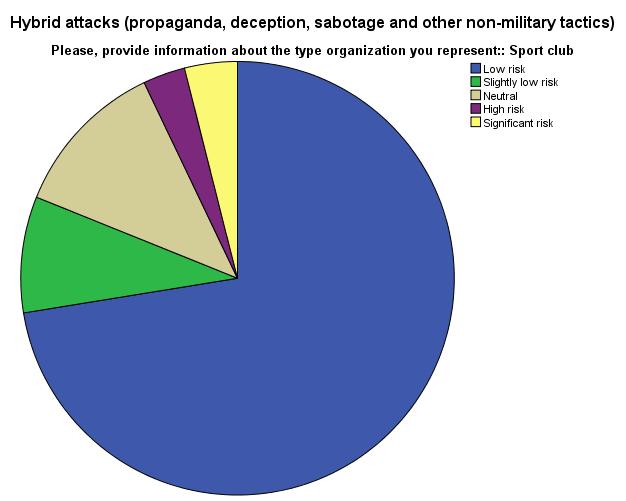



Frequency Percent
Low risk 92 72.4
Slightly low risk 11 8.7
Neutral 15 11.8
High risk 4 3.1 Significant risk 5 3.9
Total 127 100.0
Low risk 12 48.0
Slightly low risk 4 16.0
Neutral 3 12.0 High risk 1 4.0 Significant risk 5 20.0
Total 25 100.0

Low risk 30 49.2
Slightly low risk 8 13.1
Neutral 9 14.8 High risk 7 11.5 Significant risk 7 11.5
Total 61 100.0
A question included in this questionnaire was if partic ipants are at risk of hybrid attacks. Participants from all the organizations answered that are at very low
risk with a percentage of 72.4 for sports clubs, 48% for sports federations and 49.2 for sports organizations.
Sport federation
Sport organization

Table 12
Most important 11 8.7
Important 22 17.3
Neutral 41 32.3 Less important 32 25.2 Least important 21 16.5
Total 127 100.0
Most important 3 12.0
Important 6 24.0 Neutral 5 20.0 Less important 5 20.0 Least important 6 24.0 Total 25 100.0
Most important 7 11.5
Important 11 18.0
Neutral 18 29.5 Less important 18 29.5 Least important 7 11.5


Total 61 100.0
Another group of questions asked participants whether winning opportunity for national athletes is important or not. The answer to this question was a combination
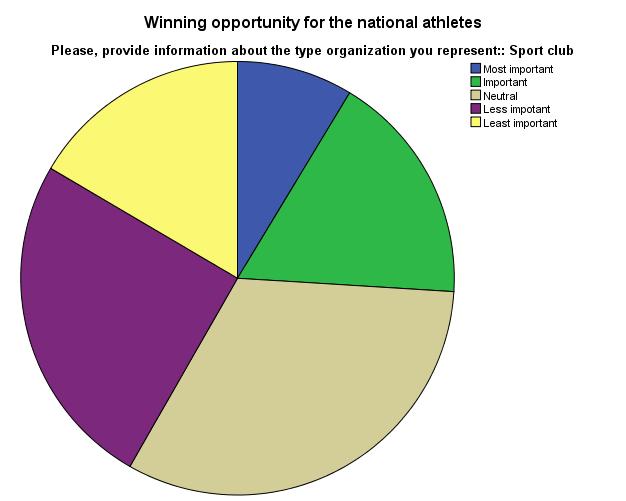
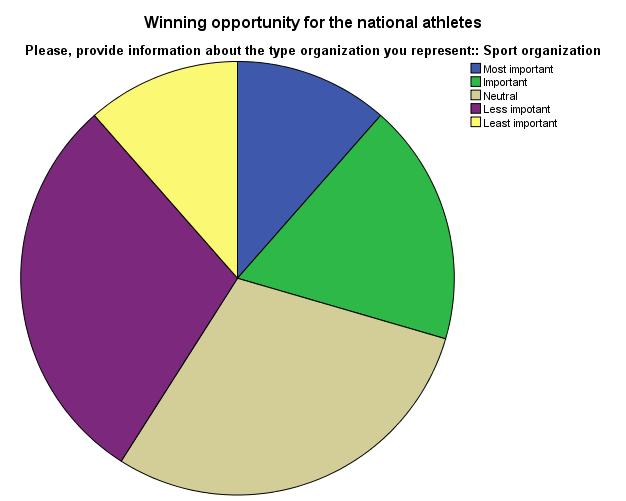
with an equal percentage falling from most important to least important. It would not be wrong to say that it was a mixture of all the responses.
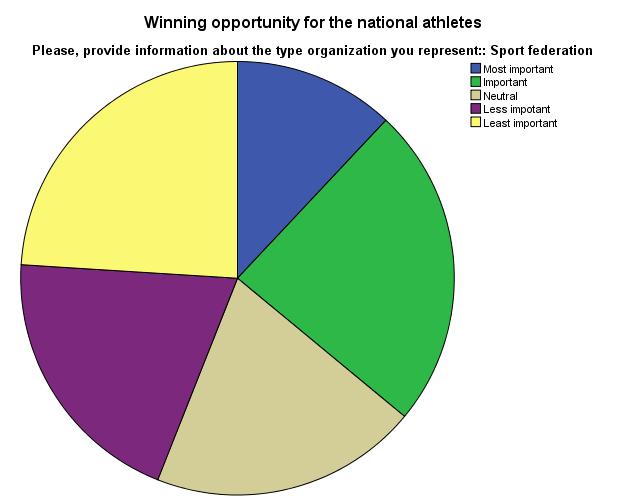
Table 13
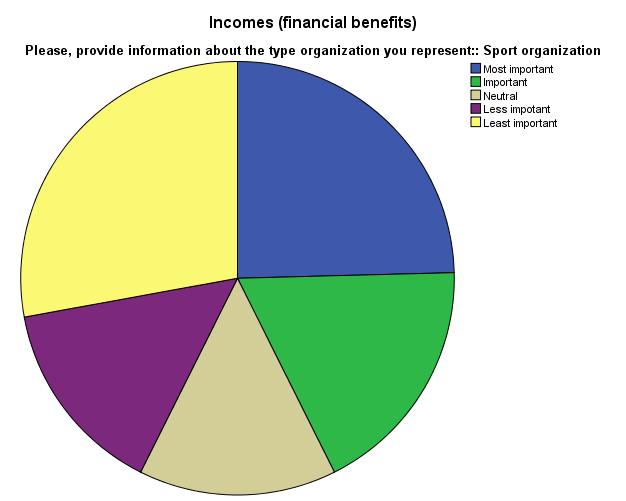

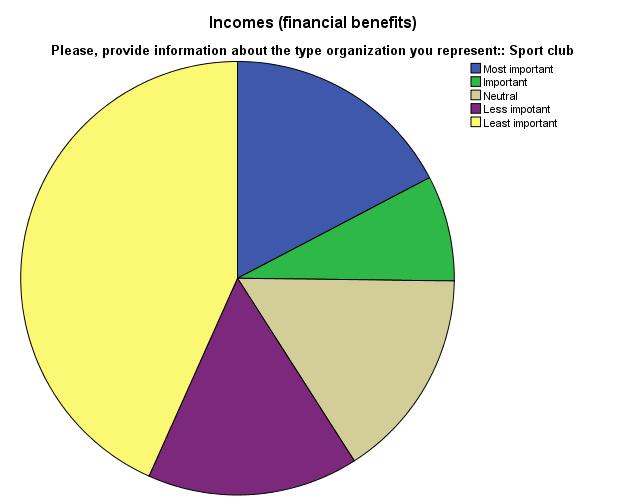

Sport club
Sport federation
Sport organization
Frequency Percent
Most important 22 17.3
Important 10 7.9 Neutral 20 15.7 Less important 20 15.7 Least important 55 43.3
Total 127 100.0
Most important 4 16.0

Important 4 16.0 Neutral 1 4.0 Less important 3 12.0 Least important 13 52.0 Total 25 100.0
Most important 15 24.6
Important 11 18.0 Neutral 9 14.8 Less important 9 14.8 Least important 17 27.9
Total 61 100.0
Another question was related to the importance of income, more ratio of sports clubs and sports feder ations participants said that it was least important to
them while the frequency of sports organizations fell in all responses with comparatively more percentage in the least important.
Organization Type Responses
Sport club
Sport federation
Sport organization

Frequency Percent
Most important 15 11.8
Important 29 22.8 Neutral 29 22.8 Less important 37 29.1 Least important 17 13.4


Total 127 100.0
Most important 4 16.0 Important 7 28.0 Neutral 6 24.0 Less important 5 20.0 Least important 3 12.0 Total 25 100.0
Most important 10 16.4
Important 8 13.1 Neutral 12 19.7 Less important 19 31.1 Least important 12 19.7 Total 61 100.0
Table 14 shows the answers related to the importance of sports results, more frequency of participants in
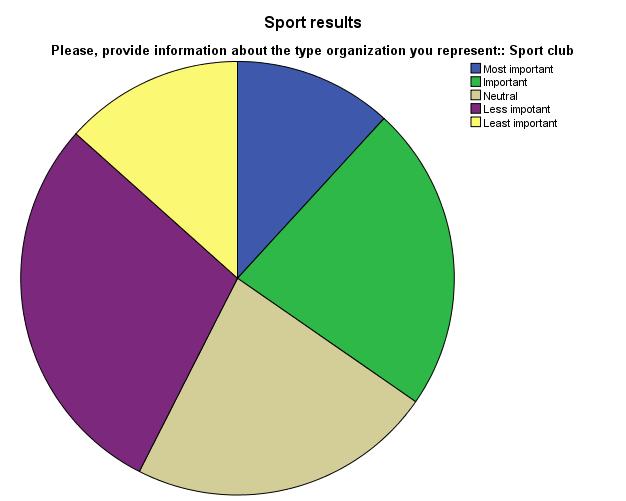
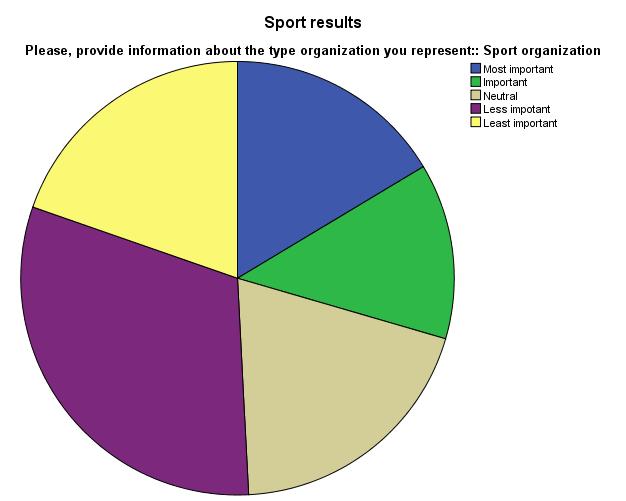
these three organizations said that it was least impor tant to them.

Sport federation
Sport organization

Table 15

Frequency Percent
Most important 40 31.5
Important 40 31.5 Neutral 20 15.7 Less important 15 11.8 Least important 12 9.4
Total 127 100.0
Most important 11 44.0
Important 4 16.0 Neutral 5 20.0 Less important 3 12.0 Least important 2 8.0 Total 25 100.0
Most important 11 18.0
Important 21 34.4 Neutral 11 18.0 Less important 12 19.7 Least important 6 9.8
Total 61 100.0
When the question was asked about the importance of proper delivery of an event, more participants answered that it was most important to them with a
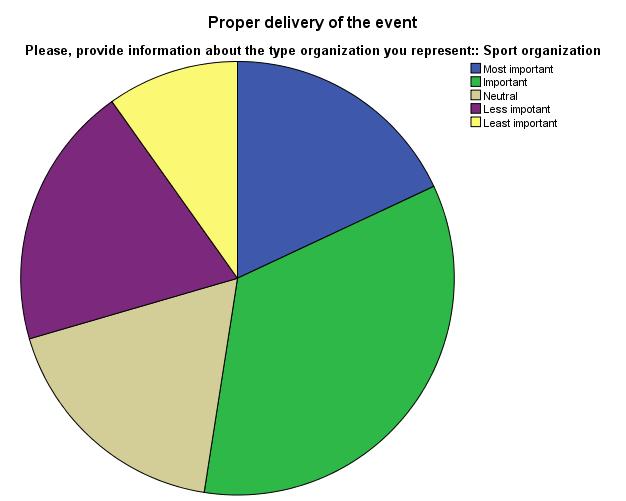
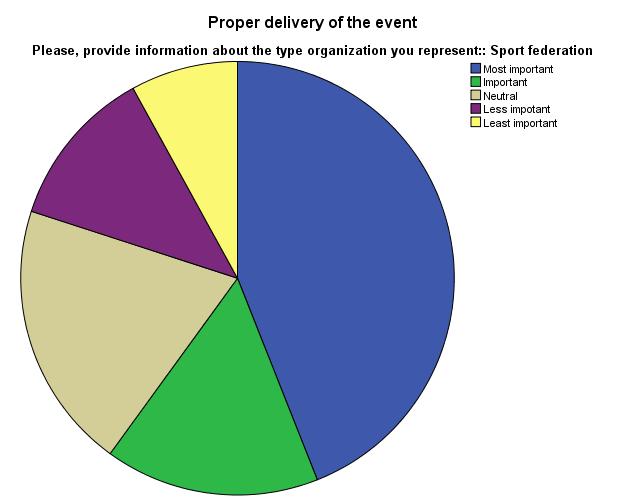
percentage of 31.5 for sports clubs, 44 for sports fed erations and 34 for sports organizations.
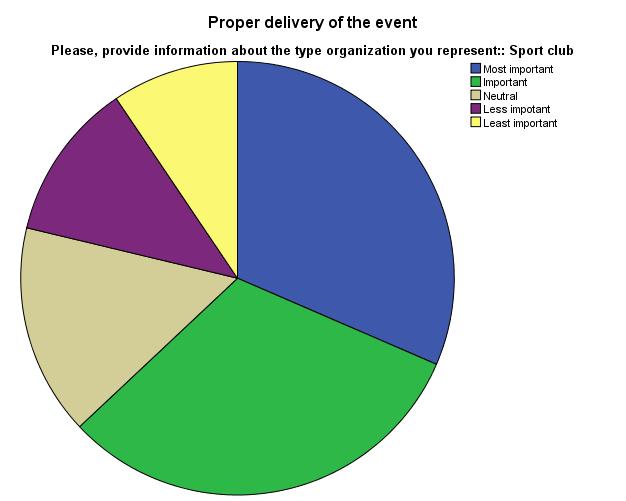
Sport federation
Sport organization

Table 16
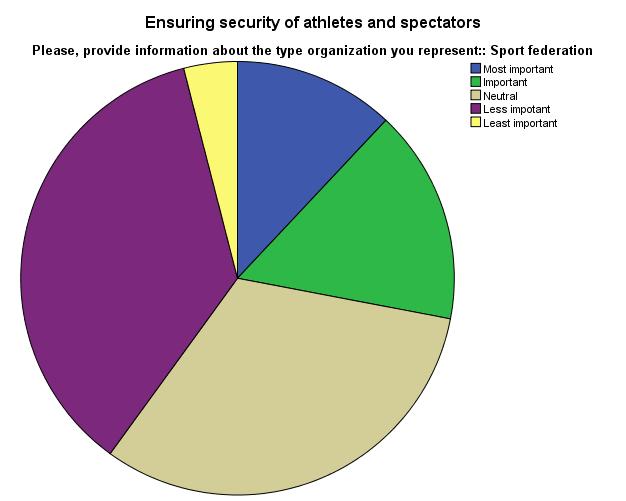


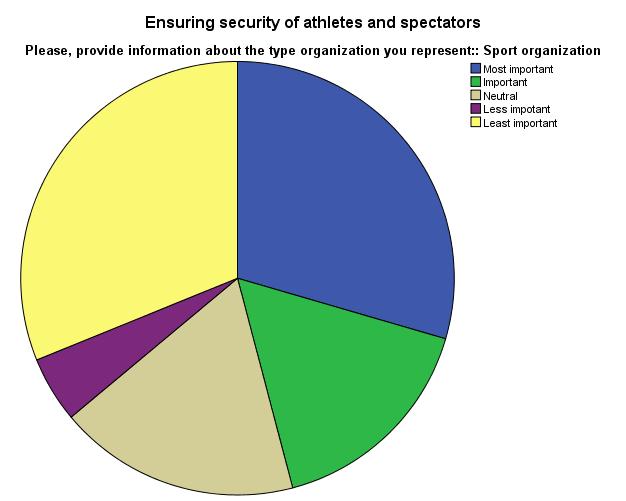
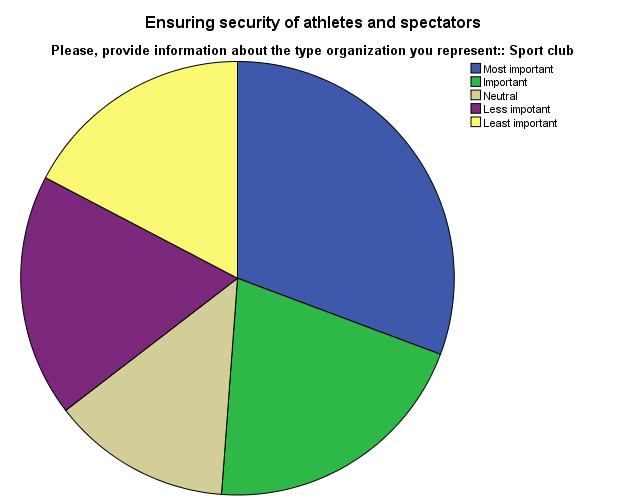
Frequency
Most important 39 30.7
Important 26 20.5
Neutral 17 13.4 Less important 23 18.1 Least important 22 17.3
Total 127 100.0
Most important 3 12.0
Important 4 16.0 Neutral 8 32.0 Less important 9 36.0 Least important 1 4.0 Total 25 100.0
Most important 18 29.5
Important 10 16.4
Neutral 11 18.0 Less important 3 4.9 Least important 19 31.1
Total 61 100.0
Participants were also asked if ensuring the security of athletes and spectators was important or not, the answers were a mixture for all three types of organiza tions. Participants of sports clubs answered that it was
most important to them, while a percentage of sports federations and sports organizations said that it was least important to them.
Table 17
If you are informed that there is a security risk at the event you are organizing, what would you do:
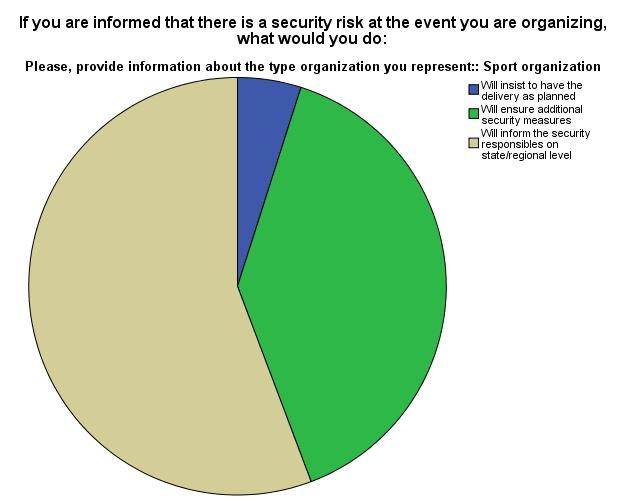
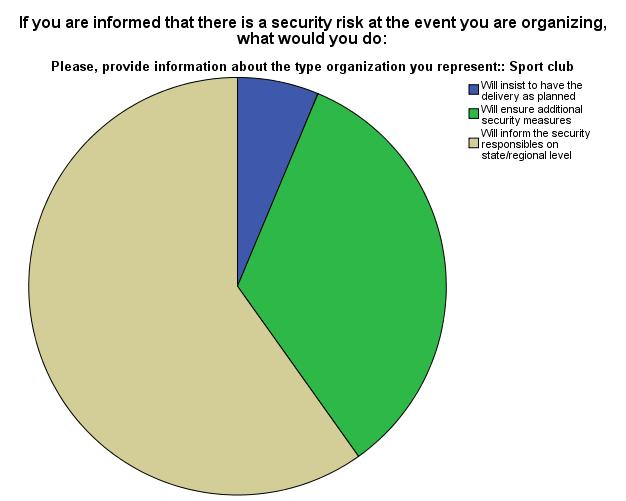
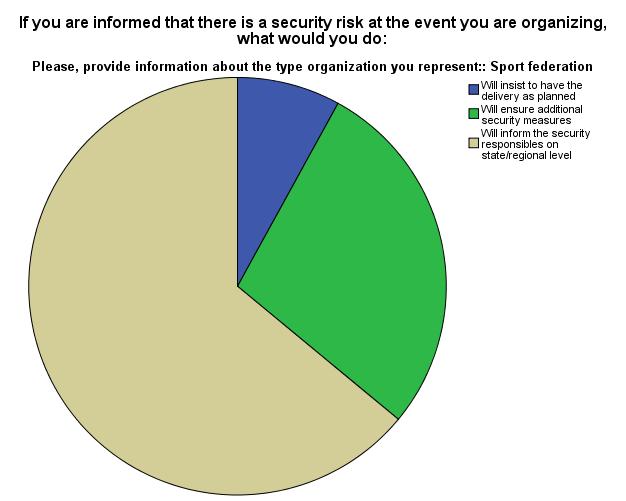
Organization Type Responses

Sport club
Sport federation

Sport organization
Frequency Percent
Will insist to have the delivery as planned 8 6.3 Will ensure additional security measures 43 33.9 Will inform the security responsible on the state/regional level 76 59.8
Total 127 100.0
Will insist to have the delivery as planned 2 8.0 Will ensure additional security measures 7 28.0 Will inform the security responsible on the state/regional level 16 64.0
Total 25 100.0
Will insist to have the delivery as planned 3 4.9 Will ensure additional security measures 24 39.3 Will inform the security responsible on the state/regional level 34 55.7
Another question was ‘If you are informed that there is a security risk at the event you are organizing, what would you do’; participants who said ‘Will insist to have the delivery as planned’ were 6.3% from sports clubs, 8% from sports federations and 4.9% from sport organization. Participants who answered ‘will ensure
additional security measures’ were in average ratio with a percentage of 33.9% from sports clubs, 28% from sports federations and 39.3% from sport organi zation. While more than 50% of the remaining percent age said they will inform security responsible in such a situation.
Table 18
In your budget plans, are you counting on safety and security as important factors?
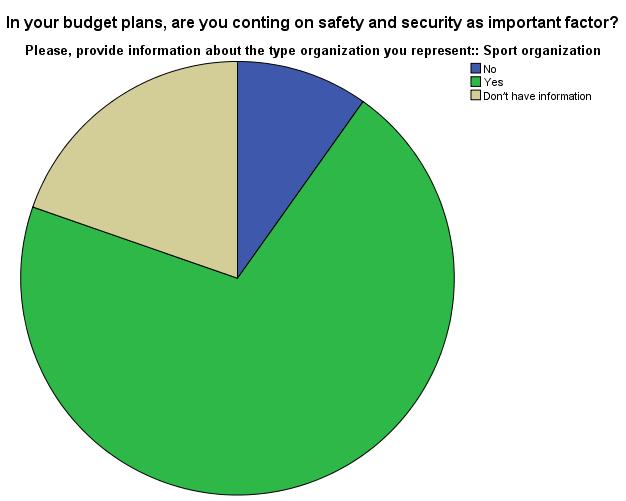

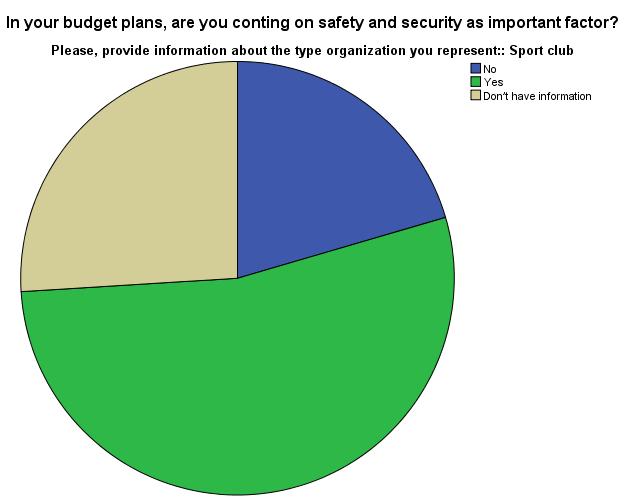
Organization Type Responses

Sport club
Sport federation


Sport organization
Frequency Percent
No 26 20.5 Yes 68 53.5 Don’t have the information 33 26.0
Total 127 100.0
No 6 24.0 Yes 11 44.0 Don’t have information 8 32.0
Total 25 100.0
No 6 9.8 Yes 43 70.5 Don’t have information 12 19.7 Total 61 100.0
Another question was ‘In your budget plans, are you counting on safety and security as an important factor; 20.5% of participants of sports clubs and 24% of sports federations and 9.8% of sports organizations answered that they don’t count on such security purposes. While
most of them said that they do count on security safety purposes with a percentage of 53.5% from sports clubs, 44% from sports federations and 70.5% from sports organizations. While a low proportion did not have any information about it.
Table 19
Have you ever had a problem with security during events you organized?
Organization Type Responses
Sport club
Frequency Percent
No 111 87.4 Yes 16 12.6
Total 127 100.0
Sport federation No 18 72.0 Yes 7 28.0
Total 25 100.0
Sport organization No 49 80.3 Yes 12 19.7


Total 61 100.0
Another question was ‘Have you ever had a problem with security during events you organized; 87.4% of participants from sports clubs, 72% from sports
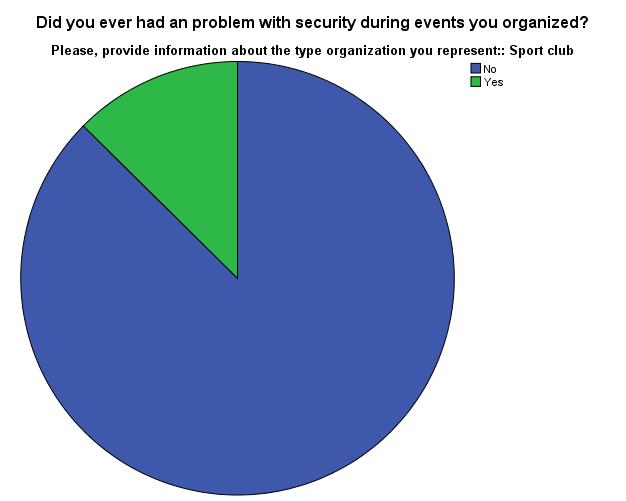
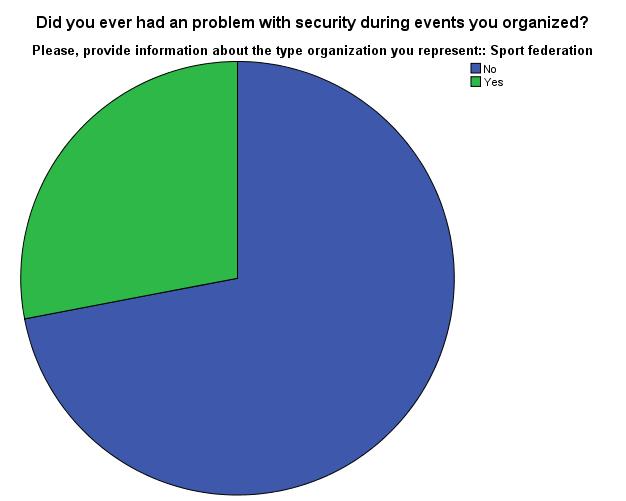
federations and 80.3% of sport organization answered that they don’t have such a problem. While less ration of participants answered this question in Yes.
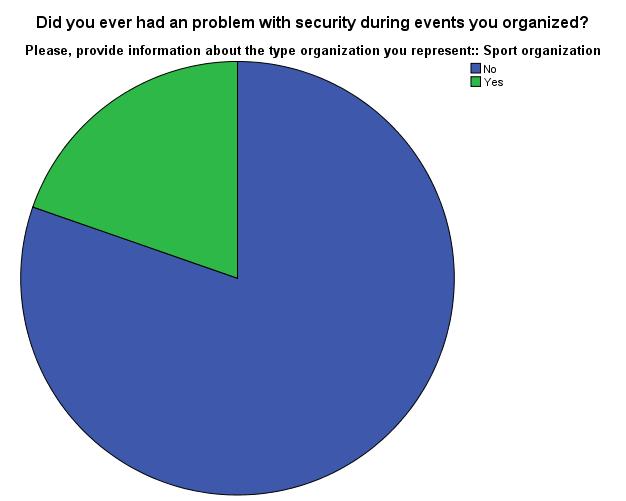
Table 20
Are you interested in taking part in safety and security training opportunities regarding the organization of sports events:
Organization Type Responses
Frequency Percent
Sport club No 14 11.0
Yes 90 70.9 Not sure 23 18.1
Total 127 100.0
Sport federation No 2 8.0
Yes 18 72.0 Not sure 5 20.0
Total 25 100.0
Sport organization No 4 6.6 Yes 47 77.0 Not sure 10 16.4



Total 61 100.0
The last question was asked if participants were inter ested in taking part in safety and security training op portunities regarding the organization of sports events; 11% of participants of sports clubs and 8% of sports federations and 6.6% of sports organizations answered
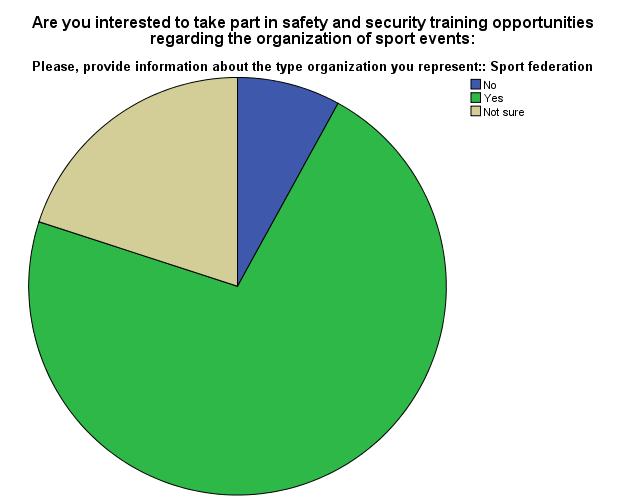
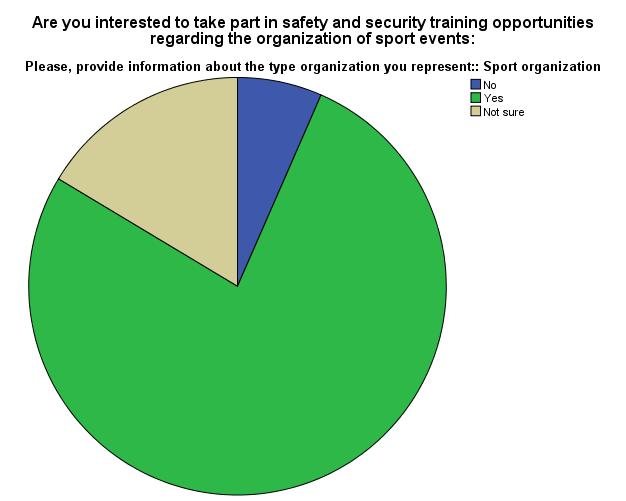
that they are not interested in it. 70.9% from sports clubs, 72% from sports federations and 77% from sport organization answered that they are interested in such events. While others were not sure about it.
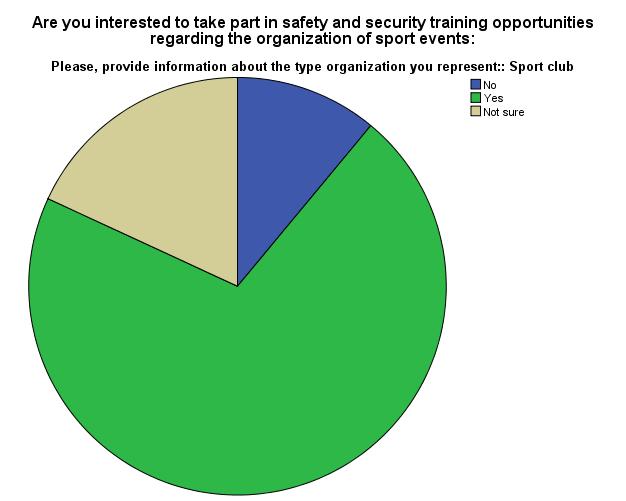

The main purpose of this SafeSPORTevent was to protect young athletes and players from health and safety hazards and to find out the factors which are not implemented to the extent they should. The reason behind this project was also to find out what safety measures are taken on the European population and to what level. In our research, we found out that most participants from sports clubs participated in this research. Moreover, sports events mostly occur at the National level so we can interpret that these respons es are given keeping in view the National level events. Proper risk assessment is taken during all stages of sports events and the organization also has a proper security system for employees.
These data suggest several important points on which to rely to stimulate the right safety and security purposes to ensure a safer environment and to create awareness:
• Risk assessment training should be provided to all the team members and participants of the organization
• New socio-economic rules that stimulate more participation of participants.
• Good practices toolkit edition Safe Sport Event including practical brochures (protocols) for Safe Sport Event that sports organizations can use as a guide during the organization of local/national/
international sports events and innovative Educa tion Through Sport activities with a focus on safety and security (non-formal educational activities);
• Empowered sport managers, administrators and volunteers in 2 European Union, 1 Programme country and 1 Western Balkans country to work fo cused on the empowerment of safety and security in sport, especially during sports events;

• Delivered international training Complex security environment and Sport and implemented local training courses as replication of the international TC in order to ensure snowfall effect.
• By the way, given that without spending large amounts of money, a new tax concession could allow sports centres to reduce the costs of the subscription with women/family discounts and/or make all the expenses related to physical activity deductible.
• Participants are well-motivated to take part in activities or training concerning security purposes; so such opportunities should be provided.
• Employees count on the provided security purpos es so such security concerns should be provided up to mark for the safety of players as well as other management.
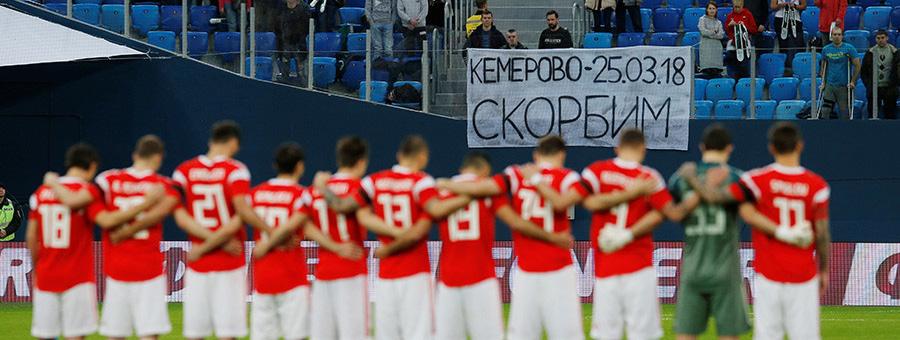
The project aims to protect athletes, especially the youngest, from health and safety hazards by improv ing training and competition conditions and especially during force Majeure security threads that need to be handled by specific security protocols that at this point of development do not exist in the sports sector. That is why, because of the main priority of the project, each partner has properly identified experts in the field of security during sports events and in-debt interviews have been conducted. The experience and knowledge shared by the experts will shed light on the matter and we will learn what can be improved in this field.

Experience in the field of safety and security in sports and short background information:
Extensive background as an athlete. Mr. Goran has been doing karate for 30 years. He is a former world champion and vice European champion at the under U 21 level, and winner of the best youth athlete in Bosnia and Herzegovina for the year 2005. He is also the own er of the karate club “Olimp”. This club has existed for 15 years now and Mr. Goran is also a member of the board of the karate federation of Bosnia and Herzego vina, and the canton of Sarajevo. Obviously, with this resume, he also has experience in organizing events in the sports field and knowledge of the laws and juris dictions when it comes to security in sports.
When it comes to his opinion on the security situation, and the protocols that are implemented to create a secure environment for the athletes and the fans, Mr. Goran states that there are certain laws govern ing huge gatherings in the country. When planning an event, you must notify the authorities and hire a specific number of security personnel. Depending on the magnitude of the event, you may be required to organize a team of doctors, and you may also require an ambulance. All of these protocols, in his opinion,
have nothing to do with athletics, but rather with event planning. According to Mr. Goran, these protocols are perfectly acceptable and are generally followed and executed, at least, as far as he is aware. As a result, when he is in the position to organize a tournament, Mr. Goran is aware that these rules and requirements must be followed and completed.


In his experience, when it comes to arranging interna tional events such as European and World Champion ships, all of these protocols are widely acknowledged, and the athletes’ and spectators’ safety is generally high. For the sport of karate, Goran believes that the degree of security in Bosnia and Herzegovina is sig nificantly higher than, for example, in other western Balkan countries.
Goran was also asked to make a comparison be tween the security level in Bosnia and other European countries. When it comes to more popular sports like football or basketball, he believes that most sports federations’ statutes should be in line with any Europe an or international federation’s statutes, such as UEFA. Given this, if you want to compete at a high level, safety criteria must be met, which, Mr. Goran believes, they are most of the time. A small concern would be that in Bosnia there are not as many cameras and other secu rity technology in our highest divisions, say in basket ball, as the English top division or Germany.
The question of government investments was also covered during the interview and Mr. Goran stated that unfortunately, Bosnia and Herzegovina don’t have leg islation that regulates sports and sporting activity. Ef forts have been made to draft a few cantonal statutes. There is a half-completed bill draft. When it comes to athletics, there are some concerns. Other laws, such as the one that covers public gatherings, impose obliga tions on event organizers to ensure the security and safety of their events. Mr. Goran believes that the law governing sports would include provisions for security and safety, which would help to ensure the protection of both athletes and spectators.
Overall, according to Mr. Goran, the situation in Bosnia related to sports security is not bad but he, as a former high-level athlete and a current coach, would change some things. Following disciplinary processes is one
option that could be done. In Bosnia, there are not many physical fights, but there are a lot of verbal ones. This, in his opinion, is not good for sports. Every athlete who engages in a verbal altercation should be appro priately penalized. As far as Mr. Goran is aware, no dis ciplinary action is currently being taken, however, the disciplinary rulebooks state that such activity should be punished. So, given the resources, he believes that this is one method to raise sporting standards. Another step forward would be the sports law and its execution.


Position: Professor at the National Sports AcademyBachelor’s and Master’s degree programme – Sport and Security, Lieutenant Colonel National Security
Experience in the field of safety and security in sports and short background information:
More than 50 years of experience in the field of sports and security, a longtime employee in the Ministry of Defense, Ministry of Interior and Counterintelligence with a portfolio in the fight against organized crime. Creator of the first curriculum for training students from NSA in the speciality “Sports Stewards”. Longtime coach and trainer of personal defence, hand-to-hand combat and taekwondo. Instructor in specialized police tactics. He has 1st Shotokan Karate Dan and 5th Dan in Taekwondo, World Taekwondo Champion for Veterans2006. World Taekwondo Champion (ITF).
According to Prof. Yordanov, because of their size and widespread media coverage, sporting events provide opportunities for encroachment. Cyber-attacks are also a threat in this regard. As a result, the State Agency for National Security (SANS), the Ministry of Interior, the National Security Service (NSS), the Ministry of De fense, and the Military Police Service have specific ob ligations under the National Plan, which do not exclude all types of threats.
The security risk before and during sports events vary, but, according to him and reliable data, the most serious include possible fires, terrorist attacks,
possible damage to neighbouring structures, security equipment damage, crowding of too many people in light of the existing COVID -19 measures, and accidents between spectators/fans, among others. Because of all these threats, organizers have to be prepared and Prof. Yordanov claims that they have a high degree of prepa ration, because athletic events and sports facilities are under the watchful eye of the Ministry of Interior and private security/surveillance firms whose major activ ities fall under the authority of the proper authorities. When a crisis arises, such as a fire or a terrorist attack, there are a variety of stated and sanctioned steps and activities that can be taken. The organizers also employ trained sports stewards to ensure that everything runs well. According to the data, the cooperation is excellent. There is a national centre in the Ministry of Interior that gives assistance to all athletic event organizers.
When it comes to particular training programs in the field of sports security in Bulgaria, Prof. Yordanov is not entirely sure at the moment, but when it comes to training specific representatives of companies in the field of security and surveillance of sporting events in accordance with specific normative acts, all of the legal bodies mentioned above must receive the nec essary documentation from these companies in order to approve them. In this instance, the companies are responsible for the training. He is also not sure wheth er there is a national strategy for ensuring safety and security during sports events however, there are numerous normative acts and jurisdictions.
He also claims that there is a methodology for risk assessment of sports events because the security/ surveillance firm submits a cover letter, a contract, and other documents to the police. One of them is the risk assessment document, in which they must eval uate the level of danger (or absence thereof). Overall, according to Prof. Yordanov and other surveillance experts, it is always necessary to improve constantly the legislation in the field of safety when it comes to sporting events.


 Name: Dimitris Akritidis
Name: Dimitris Akritidis
Position: Vice President, Public Sports Venues Thes saloniki (which includes 12 arenas, 45 stadiums and 3 swimming pools)
Experience in the field of safety and security in sports and short background information:
Mr. Akritidis has long professional experience in management positions in public sports venues in Thessaloniki.
According to Mr. Akritidis, the assessment of risk before and during a sporting event, refers to the likelihood that anything will go wrong. Unfortunately, it cannot be completely removed, but it may be handled with some careful planning. Prior to sporting events, as well as during them, risk assessments are carried out. As a result, attempts are made to avoid the probability of something going wrong by evaluating the likelihood of it occurring and the resulting consequences. As a result, risk assessment focuses on assessing securi ty-related risks, such as threats to the sports site and assets, as well as threats to the workforce. For exam ple, by doing thorough and routine maintenance, we can reduce the likelihood of a system failure. Nobody wants to have to cancel any sporting events because the lighting system isn’t working properly due to a lack of maintenance. In general, the purpose of the secu rity risk assessment is to supply the organizers and higher authorities with crucial information that will allow them to make educated judgments regarding the sporting events that will be held in the facilities.
When it comes to the main risks when organizing a sports event, Mr. Akritidis stated that the main security risks include logistical (systems) failure, hooliganism, crowd disruption and/or vandalism, and severe weath er. He referred to the possibility of losing electricity or a system’s breakdown as a logistical failure. Further more, the presence of hooligans in the sports venue must be considered based on the sporting event, the animosity between competing teams, and the signifi cance of the game. Hooligans can do a lot of damage
(vandalism) to the sports arena if they are not regu lated, and crowd unrest can lead to individual injuries. Also, if severe weather is not properly analyzed, it can derail sporting events, particularly if they are held outside. In essence, the venue manager has to decide what among the above risks are possible to happen and therefore determine how vulnerable the sports venue is to any occurrence of the above. For the record, although terrorist attacks may be high on the list of risks in other countries, this threat is not considered as high in Greece at this point. Mr. Akritidis is thankful that fortunately, thus far, Greece has not dealt with any terrorist attack in sports events.
Organizers of sporting events and owners of sporting venues are usually prepared to some extent to ensure and address foreseeable dangers, but budget cuts have definitely harmed their preparedness. There is never enough money spent on CCTV or other secu rity equipment, nor is there enough money spent on paid employee training and retraining, especially for public sports venues. Furthermore, the funding for permanent security employees is limited, and as a result, the level of preparedness is undermined while understaffed.
When it comes to the coordination between the or ganizers of sports events and the owners of sports facilities and the state bodies is good especially when it comes to major sporting events, such as hosting international ones. The duty of providing safe and secure games is vital for every sport venue administra tor or event organizer, but Mr. Akritidis recognizes that additional assistance from other agencies is required. As a result, there is always a multi-agency partnership (Police, Hellenic Fire Service, emergency response staff, municipal officials) that assures successful preparation, reaction, and recovery activities, especially when we hold significant sporting events.
Whether there are training programs in the field of sports security, Mr. Akritidis claims that although var ious training programs (first aid seminars and work shops) are in place, they are never enough in terms of sports security because they are continually under staffed and have less funding than needed.
A crucial question is whether there is a national strategy for ensuring safety and security during sports events. A national policy has been developed before the 2004 Olympic Games in Athens to ensure the safety and security of sporting events, and this strategy is currently in force. As a result, there was a lot of train ing on how to deal with enormous crowds. A dedicated squad was developed for the Athens Olympics to cope with terrorism threats. All of these factors contributed to the games’ success. Training should be undertaken constantly for smaller size events, however, with a decreased budget dedicated to athletic events, this is not always achievable. Beyond basic training, annual security training for all individuals responsible for se curity is provided, although this is not always sufficient. More money is needed to sponsor more security-relat ed readiness exercises.
According to the risk assessment technique, first, po tential hazards must be identified, dangers, or weak nesses in the athletic venues. As a result, identifying what does not operate effectively is the first stage, followed by addressing these issues by developing appropriate policies, processes, and security meas ures. It is critical to develop or update existing sports venue safety and security policies, which may include policies regarding fan interaction. As a result, emer gency response plans have been created for game day operations, complete with annexes. Evacuation proto cols, incident response and planning for the next day after the sporting event are frequently included in this plan. There are distinct methods that must be applied during the day of the sporting event than those that must be implemented before and after the day of the sporting event.
According to Mr. Akritidis, whether it is necessary to improve the legislation in the field of security during sports events, he firmly believes that it’s not so much an issue of enhancing security legislation as it is of increasing the budget set out for that purpose. The budget for sports, in general, was lowered during the global financial crisis of 2008, and it has never recov ered to pre-crisis levels of public investment.
#SafeSPORTevent experts’ point of view Greece
Name: Dr Panagiota Balaska

Position: Head of Sports Facilities Department, Sports & Culture Directorate, Municipality of Kordelio – Evosmos
Management of sports facilities and organization of sports events (European Men’s Volleyball Champion ship, National Rhythmic Gymnastics Championship etc.).

According to Mr. Panagiota, the type of event and the number of spectators have a direct impact on the risk assessment of a sporting event. When there is little interest and few viewers at a tennis tournament, for example, the risk assessment is low both before and during the tournament. In the men’s final or qualifying match of handball, on the other hand, where a signifi cant number of spectators and fans are expected, the danger is carefully monitored before, during, and after the game. Minor delinquent actions to extreme aggres sive behaviours are all potential threats to the safety of the sporting event. As a result, we have: violent attacks and riots, anti-social behaviour, the posting of protest banners, the writing of slogans - protests on spectators’ T-shirts, not visible at the entrance, with the goal of communicating in the spectators’ places to make public - power outages, damages to the facility’s infrastructure, illegal intrusion, medical accidents, fires in the permanent and temporary infrastructure of the sports facility, and other hazards such as organized and common crime. Mr. Panagiota believes that the potential dangers are thoroughly investigated in order to adequately prepare and inform the employees. Cop ing techniques are defined in order to foresee future dangers or manage them in a timely manner without exacerbating them.
When it comes to the coordination between the or ganizers of sports events and the owners of sports facilities and the state bodies, Mr. Panagiota states that there is operational planning, especially in high-risk
sporting events, and all public, private, and sports associations involved participate, cooperate, and are responsible for the items given to them in terms of safety. There are training programs for first aid and firefighting with portable fire extinguishers, as well as other skills such as crowd management, which are normally trained and informed by the person in charge of the sports facility (if he/she has the knowledge).
According to Mr. Panagiota, there is a national strategy and it is the relevant legislation that clearly defines the bodies responsible for safety at sports events and the management of the safety of sports facilities.
Whether there is a methodology for risk assessment of sports events, Mr. Panagiota claims that risk iden tification is a continual activity aimed at determining the frequency with which they occur and estimating the potential for damage. The selection is made for a sports event based on these basic factors, which can include:
• Steer clear of it. If the facility’s administration be lieves that conditions will be created that threaten participants or cause substantial harm, it might consider refusing to host the program or event (financial, or others);
• Change of address. The next alternative availa ble to the facility’s administration is to delegate responsibility for potential damage restoration to someone with the will and ability to do so, such as an insurance company. Insurance can be pur chased to cover anyone harmed inside the facility as well as damage to the facility and/or equipment;
• Acceptance is the third step. The administration can allow only those programs and events to be held that have a low risk of endangering partici pants or causing damage. Risks can be reduced even further if particular operating processes for dealing with potentially hazardous circumstances are defined.
Overall, according to Mr. Panagiota, legislation should be aligned with and changed in response to societal demands and evolution. The current one lays out all of the procedures and covers a wide range of topics, but
there is always an opportunity for increased speciali zation and coverage of more potential dangers in the execution of sporting events.
#SafeSPORTevent experts’ point of view



Turkey
Name: Özgür Aygün
Position: Departmental Manager in Sakarya Provincial Directorate of Youth and Sport
Experience in the field of safety and security in sports and short background information:
A professional football referee for 17 years in total. He has been the President of the Football Association of Football Referees for 5 years. The President of the Sakarya Football Branch Provincial Referee Board for 3 years. A physical education teacher for 6 years, Sports District Manager for 4 years and he has been deputiz ing for the Sports Services Directorate for 2 years.
According to Mr. Aygün, although the essential se curity measures before and during the competition vary depending on the branches and sports fields, law enforcement officers take the necessary safeguards. Spectator activities, as well as entries and exits to halls and stadiums, pose the greatest security risk. Safe ty is primarily the responsibility of facility owners or operators.
The state has established laws that all private sports facility owners must follow in order to obtain the required qualification certificate to build a facility. They cannot open until these requirements are met, for example, they cannot open without a fire escape or exit.
Law enforcement or private security organizations use previous experience and events in sports security to conduct the necessary training within their own ranks.
When it comes to a national strategy and a method ology used for safety during sports events, Mr. Aygün claims that every province has a sports safety board, which has prepared measures for a variety of compe titions. There is a methodology for occurrences that are tied to previous experiences. Law No. 6222 shall
be followed, especially in regard to spectator events, sports violence, and fair play.
Name:
 Kemal ATAÇ
Kemal ATAÇ
Position: District Directorate of Youth and Sport

Experience in the field of safety and security in sports and short background information:
Karasu District Directorate of Youth and Sport for sev eral years and was in charge of organizing all sports events in the town.
According to Mr. ATAÇ, when it comes to risk assess ment and preparation, the District Sports Security Board meets prior to the competition. The District Gov ernor, Mayor, District Gendarme Commander, District Police Chief, District Health Director, District Youth and Sports Director, and Club representatives are in charge of the meeting. During the event, the risk may include spectators descending on the field, attacking the rival team players, attacking the officials, and in some situa tions, the use of brutal force against the referee by the players on the field against one other.
The organizers of the event aim to be well-prepared by assigning security staff to vulnerable areas, assuming that spectators will rush onto the field and accidents may be prevented and there is a guarantee that secu rity personnel can intervene swiftly in the event of an emergency.
When it comes to coordination between the organizers of sports events and the owners of sports facilities and the state bodies, Kemal mentioned that there is no con fusion of authority. While taking security measures, the police and the district sports directorate are working in coordination. The police personnel is the one taking the necessary training. Violence and Disorder in Sports Law on Prevention is the national strategy for ensuring safety and security during sports events.
It is important to be analyzed the information about major cases in each individual country about security incidents during sports events or special measures taken to guarantee security.
A case study in the field of safety and security in sport
Event during which has been recorded a security incident: Training of the “FK Sarajevo” team prior to the final round of the Premiere League of Bosnia and Herzegovina.
Period of implementation of the event: Premiere League of Bosnia and Herzegovina, May 2021
Responsible organization for the delivery of the event: Football Club “FK Sarajevo”
Scope of the event: National
Security threat situation: The violence was commit ted by a group of supporters of “FK Sarajevo” during the training of the “FK Sarajevo” team that was prepar ing for the final round of the Premiere League.
The group of supporters, also known as “Horde zla” was exasperated by the previous performance of the team and the fact that the team lost the possible advantage of 13 points for the coming match with “FK Borac”.
They expressed their anger and disappointment by in vading the field by the time when the training had been holding and attacking the players.
Mostly they attacked the players whose performance they found the worst and the reason for losing some preceding matches.
One of the targets was Dušan Hodžić who was at tacked verbally and physically and got physical injuries.
With the reaction of other people present and the po lice, the attacks on the players were stopped.
After the situation was solved, reactions came from the Club Management that condemned the proceedings. Besides, the reaction of Dušan Hodžić, who ended up at the hospital because of the injuries, was to leave the Club the following week.
Another outcome was that the rest of the team was about to give up on the final match, however, at the end that did not happen and they played.
When does the security threat happen: During the training of the ”FK Sarajevo” team.
Would it be possible to be prevented: It could have been prevented if the club have had a better security system for the field and buildings that are property of the club and where the training takes place.
Have any measures been applied after the occur rence to prevent further security threats (national legislation, adoption of practices from either state or sports organizations, etc…): Unfortunately not. None of the attackers was prosecuted even though the police have conducted investigations.
A case study in the field of safety and security in sport

Event during which has been recorded a security incident: National Stadium Vasil Levski, Sofia • LevskiCSKA 1:1 • Match from PFL Championship


Period of implementation of the event: September 11, 2005
Responsible organization for the delivery of the event: Bulgarian Football Union
Scope of the event: National
Security threat situation: Six policemen received injuries and were announced for emergency aid at the „Pirogov“ National Hospital (Sofia) and a Military Med icanian Academy (Sofia) and 77 fans were detained by
the laws of the order after the match between Levski and CSKA.
This happened after a fight between Levski (Sofia) fans and the uniformed law enforcement officers guarding the match. The policemen received injuries and con tusions caused by sticks, rocks and stones, and piec es of seats - 6 of the policemen were hospitalized in Pirogov Hospital. The brawls began after the first half when Levski supporters began to fight the stands and attacked the police officers.
After the end of the match, the police took the most heated football fans and held 75 of them. From the detainees, 69 are fans of Levski and eight - are CSKA fans, according to police data.
When does the security threat happen: Football fans are different from all other sports fans. Foot ball competitions also vary, no matter where in the world. The other sports competitions are held mainly in sports halls, which makes the security access and regime stricter. Football hooliganism is directly de pendent on public respect for security and law and order in general. Security threat exists in every football match between Levski and CSKA, especially if it is underestimated by the security authorities in Bulgaria. The overwhelming majority of football fans just want to enjoy the game. Unfortunately, some of the most “portion” of them see the games as an opportunity for crime, disturbance and hooliganism - violent criminals hiding behind the colours of their football team. Even though criminals like these are a small minority, they still account for incidents that affect football games. The governments, the local authorities, and the police must be at the forefront of the prevention.
Would it be possible for it to be prevented? If yes – how: Football vandalism and hooliganism can be greatly reduced if modern technologies and a system for prevention and analysis are used before, during and after the end of sports matches.
Some ways to limit the problems created by some football fans are:
• Persons wearing head masks should not be al lowed to participate in sports competitions;
• Technical support, video surveillance and ac cess regime must be committed, provided and improved;
• Scanners and detectors at stadium entry points;
• Individuals who purchase tickets should do so with the identity document - so that in a situation that occurs, it will be clear who is responsible for it (the place of the person sitting).
Have any measures been applied after the occur rence to prevent further security threats (national legislation, adoption of practices from either state or sports organizations, etc…): As a result of the fre quent cases of football hooliganism and vandalism, the Bulgarian government and local authorities are taking the following legal measures to limit it:
• Ordinance for construction, maintenance and pro tection of the green system of Sofia municipality adopted by decision No 950 under protocol No 120 of 11.10.2007;20
• Ordinance for management and disposal of munic ipal sports properties and facilities on the territory of the Sofia municipality adopted by decision No 898 under protocol No 119 of 28.09.2007 of the Sofia municipal council;21
• Amendments to Law for protection of public order in the conduct of sports events - State gazette issue 105 of December 29, 2005.22
A case study in the field of safety and security in sport

Event during which has been recorded a security incident: „The Bloody finale“ • National Stadium Vasil Levski, Sofia • CSKA - Levski 2:1 • The Cup of Bulgaria - 1985.
Period of implementation of the event: June 19, 1985
Responsible organization for the delivery of the event: Bulgarian Football Union
Security threat situation: The most famous, the black est, the most scandalous match between Levski and CSKA is the final between the two teams for the 1985 Bulgarian Cup.
The politicization of Bulgarian football and the toler ance (Bulgarian Communist Party, Ministry of Interior and Ministry of Defense, state and local government, sports sector, etc.) of two of the most successful Bulgarian football players is a prerequisite for the “Bloody Final” for the Cup of the Republic of Bulgaria. Both teams are tolerated by the authorities and this is obvious to everyone, the players are stars of Bulgarian football and the discipline is low. This is especially no ticeable with the players of Levski (departmental team at the Ministry of Interior and Secret Services), who are experienced athletes and know that almost everything they do inside and outside the field will be forgiven. To a large extent, this also applies to CSKA players, but their generation is changing and most of them are young and inexperienced (the stars of Bulgarian football playing for CSKA like Hristo Stoichkov and Emil Kostadinov are 19 and 18 years old, respectively).
No one expects the young and inexperienced team of CSKA to resist or beat the experienced team of Levski, but in the middle of the second half CSKA leads 2-0 in front of 30,000 spectators at the National Stadium “Vasil Levski”. The referee gives a controversial pen alty for Levski, which further aggravates the situation on the field. The two teams started a fight, which was barely calmed down by the referee and the officials. The football match was interrupted for a few minutes in front of the officials (something unattainable and unthinkable until then). After the match, the players of both teams fight, and the fight continues both on the field and in the tunnel to the locker rooms of both teams.
When does the security threat happen: Due to the tolerance of both teams by the local government, the discipline is so low, the respect for the opponent, spectators, and state power is very low and the players

20
https://sofia.obshtini.bg/doc/275207 21 https://sofia.obshtini.bg/doc/273638 22
https://www.lex.bg/laws/ldoc/2135494582
themselves allow behaviours that are unacceptable in football.
Most players are stars both in their teams (respective ly CSKA and Levski), but also in the National Team of Bulgaria, which qualified for the 1986 World Cup, which further spoils their discipline and behaviour.
Would it be possible for it to be prevented? If yes –how: The bloody final could have been prevented, with higher security measures, and more respect for the referee and the officials in the football match. Dur ing these years, it was unthinkable for security/police officers to enter the football field.
Have any measures been applied after the occurrence to prevent further security threats (national legislation, adoption of practices from either state or sports organizations, etc…): The final of the Bul garian Cup in 1985 started a process called “Reform of Bulgarian football”
A decision of the Central Committee of the Bulgarian Communist Party followed, with which both teams were disbanded. From the players of CSKA, Hristo Stoichkov, who was removed from the sport forev er, and Kostadin Yanchev, who was punished for 3 months, received severe punishment. Borislav Mihailov (currently chairman of the Bulgarian Football Union), Plamen Nikolov, Emil Spasov, and Emil Velev have been expelled from Levski’s team forever. The manage ment and coaches of both teams were punished. The decision has great support from supporters of other teams, as well as from many other athletes. Subse quently, new ones were created in place of the old ones: CSKA “Septemvriysko zname” became “Sredets” and “Levski-Spartak” became “Vitosha”. A year later, all penalties were revoked and the penalized players were allowed to continue their sports careers.
The scandal also affected the national team, as coach Ivan Vutsov could not count on a few key players for the 1986 World Cup in Mexico. Half a year later, how ever, the Bulgarian Communist Party softened and the penalties began to fall one by one. Mihailov and Sirakov were rehabilitated, and then the others.
Other basic changes:
• Amateur football teams should be restructured into professional clubs separate from other sports clubs;
• Transfer sums have been placed on Bulgarian foot ball players and their transfer abroad is allowed;
• The BFF is closed and the BFU is created.
A case study in the field of safety and security in sport

Event during which has been recorded a security incident: 2004 Summer Olympics Athens
Period of implementation of the event: 13-29 August 2004
Responsible organization for the delivery of the event: Athens Organizing Committee for the Olympic Games (ATHOC)


Scope of the event: International
Security threat situation: It’s of utmost importance to be mentioned that Greece was the second small est country to ever host the Olympics after Finland in 1952, and prior to awarding the event to this country, there were many questions regarding its ability to provide adequate security for teams, local spectators and tourists. Although threats of terrorist attacks were not new to IOC, especially after the massacre at Munich Olympics in 1972, when Palestinian terrorists managed to kidnap and murder Israeli athletes, and the bombing incident during the Summer Olympics in 1996 in Atlanta, there was always the threat that terrorists would attempt another attack at Olympics events. The Athens Olympics was the first Olympic event that occurred after the 9/11 terrorist attacks in 2001 in the United States. In addition to that, alleged Al Qaeda fighters were linked to the Istanbul bombings in November 2003 and the Madrid commuter train explosion on March 11, 2004. All these events prompt ed the Greek government’s efforts to remain vigilant regarding a prospective terrorist attack at the Summer Olympics in Athens.
When does the security threat happen: According to some analysts, the terrorist group Al Qaeda was interested in attacking the particular games to convey its message on a global scale, by succeeding in an attack against Western democracy and simultane ously attacking Western individuals and interests. The United States, Great Britain and Spain were among the countries whose citizens were regarded to be in high danger during the Olympics, as were Israel and Saudi Arabia. Furthermore, in previous months, attacks by Al Qaeda terrorists were reported against tourists in Indonesia, Morocco, Tunisia, and Saudi Arabia, and some Al Qaeda fighters attempted to strike Israeli tour ists in Kenya. In addition to existing threats towards other nations, there were many concerns regarding Greece’s vulnerability to foreign terrorist groups which stem largely from the country’s numerous illegal entry points as well as its apparently ineffective border and passport procedures. For example, in the Aegean, Ioni an, and Mediterranean Seas, Greece comprises hun dreds of islands and is in proximity to Middle Eastern and Balkan hotspots. For the above reasons, Greek au thorities made efforts to enlist the help of their neigh bours in their northern borders, particularly Albania, in assisting in the security of the borders during the Summer Olympics. Furthermore, the European Union (EU) allowed Greece to impose stricter immigration controls regarding the free movement of EU citizens, despite the existence of the Schengen Agreement.
Would it be possible for it to be prevented? If yes – how: No major or minor incidents were reported during the 2004 Summer Olympics in Athens.
Have any measures been applied after the occurrence to prevent further security threats (national legislation, adoption of practices from either state or sports organizations, etc…): Although no incidents occurred regarding the security of the 2004 Summer Olympics in Athens, many measures were taken to prevent any security threats. For example, the Greek government understood the responsibility for the safety of hundreds of thousands of spectators and thus deployed more than 40,000 police officers and 10,000 troops, a small number of whom were trained to address a number of threats like nuclear, chemical, and biological ones at a total cost of $1.2 billion. To ef fectively coordinate security efforts, Greece developed
a Coordinating Council for Olympic Security, which consisted of 10 different ministries and was presided over by the Minister of Public Order. At a cost of over $250 million, the Greek government signed a contract with the Science Applications International Corpora tion (SAIC) which was based in the United States to assist with the security infrastructure for the games. In addition to the above, the Greek government formed the Olympic Advisory Group in 2000 which consisted of representatives from the United States, the Unit ed Kingdom, Germany, Israel, Australia, France, and Spain and who were based in Athens and assisted in the training of Greek Olympic security personnel, with an emphasis on the threat of transnational terrorism. Furthermore, the Greek government conducted many security exercises that aimed to identify areas for mandatory improvements or modifications to existing security plans. 4 with the help of foreign forces that included 400 U.S. special operations agents that joined their Greek counterparts in developing many terrorism scenarios that ranged from suicide bombings, chem ical and biological attacks, to plane hijackings. The Greek government accepted assistance from countries that were not members of the Advisory Group, includ ing Russia. The latter provided mobile laboratories to assist in the event of a nuclear, biological, or chemical attack, as well as deployed special forces to deal with a possible Chechen threat against its athletes. Simi larly, the US State Department’s Bureau of Diplomatic Security deployed a security force of 100-110 agents, analysts, and administrators to the US Olympic team, as did other nations like Spain and Great Britain that deployed their agents to their Olympic Teams.
A case study in the field of safety and security in sport

Event during which has been recorded a security incident: July 15 Martyrs’ Commemoration National Cycling 4th Road Competition

Period of implementation of the event: For a day
Responsible organization for the delivery of the event: Turkish Cycling Federation and Kahramankazan Municipality
Scope of the event: National
Security threat situation: Adults, youth and stars cat egories started the race at the same time. (About 280 athletes) As a result of this crowd, chaos broke out. In addition, some cyclists left the track as a result of the traffic police’s misdirection. When the road was opened to traffic at the same time as the race, the athletes competed with the trucks (!)and the race was finally cancelled.
During the race, national cyclist Kübra BEKTAŞ had an accident. However, the ambulance arrived 1.5 hours late to the scene. And also in the accidents, instead of intervening, the referees shouted at the accident victims.
Erol Küçükbakırcı, President of the Turkish Cycling Federation, said that an investigation was launched regarding the July 15 Martyrs’ Commemoration Road Bike Race, in which the athletes’ lives were in danger due to organizational disorder. Küçükbakırcı said, “We dismissed all the referees and other personnel as signed to the races in Kahramankazan.”
When does the security threat happen: Due to organ izational disorders, it was a race full of security threats from start to finish.
Would it be possible for it to be prevented? If yes – how: It was one of the main mistakes to start the racers in all categories at the same time.
Opening the road to traffic at the same time as the race was in no way acceptable.
A much safer racing experience could have been offered by taking strict safety measures with experts in the field.
Have any measures been applied after the occur rence to prevent further security threats (national legislation, adoption of practices from either state or sports organizations, etc…): The referees in charge of the organization were dismissed. Any measures to prevent further security threats have not yet been announced.


A case study in the field of safety and security in sport

Event during which has been recorded a security incident: Besiktas Bursaspor Football Match (Sunday, December 05, 2010). Bursaspor and Beşiktaş faced off at Vodafone Arena in the 15th week of Spor Toto Super League. Some fans were in danger of death due to the fight.
Responsible organization for the delivery of the event: Turkish Football Federation, Bursaspor, Beşiktaş JK Sports Clubs
Security threat situation: Beşiktaş fans attacked Bursaspor supporters before the match. There was almost a pitched battle between the Beşiktaş fans and Bursaspor fans, who were trying to fight back.
The incident started after Bursaspor fans were taken to the outside of the old open tribune, when some of the Beşiktaş fans coming from Beşiktaş direction broke through the barricades and moved towards the section where Bursaspor fans were located.
There was also a knife attack in the events that result ed from the confrontation of about 1200 Bursaspor fans and thousands of Beşiktaş fans, who came to Is tanbul with about 20 buses. There were also fans who got into a fight with the police. The police used pepper spray in the violent fight in which stones and sticks were flying in the air. Those who lost blood due to knife injuries received medical attention in front of the stadium. Bursaspor’s fans were kept in the stands for a while after the match for security reasons. It was ob served that some of the Bursaspor fans, who were kept in the old open stands for 1 hour and 10 minutes after the end of the match, burned down the stands. The fans who removed many seats in the section reserved for them set some of them on fire. Istanbul police ap plied strict measures after the match as well as before the match. During the evacuation of Bursaspor fans, the road in front of Dolmabahçe Palace was closed to traffic. The 1,600 Bursaspor fans were escorted under extraordinary security measures without incident.
When does the security threat happen: At the begin ning of the match, as the Bursaspor fans entered the stadium
Would it be possible for it to be prevented? If yes –how: In this regard, it is necessary to show the effects of violence on football, especially through campaigns aimed at fans, and to show with examples that the real losers are their own clubs.
Rules should be clearly underlined. Standard sanctions should be developed for the person or persons who cause an incident in the stadiums. Decisions that cover everyone equally should be implemented.
The relations between the supporters and fan com munities within the clubs should be strengthened, and the ways for these groups to participate more actively in the clubs should be opened. At this stage, necessary legal and bureaucratic steps should be taken to im plement projects and practices aimed at training fans, consisting of Clubs-Federation-Fans and State officials, which will be put into practice in the long term.
Have any measures been applied after the occur rence to prevent further security threats (national legislation, adoption of practices from either state or sports organizations, etc…) The next 3 or 4 matches were played without spectators.

National legislation in the field of sports security Bosnia and Herzegovina (BiH)
The Strategy for the Development of Sports in Bosnia and Herzegovina is a document that provides strategic guidelines and an action plan for the development of sports in BiH for the period 2010-2014, with the aim of prosperous development of sports, sports activities and sports infrastructure in BiH in accordance with the White Paper on Sports in the European Union and other documents governing the field of sports. This strategy was adopted by the Ministry of Civic Affairs of Bosnia and Herzegovina, on 13.07.2010.
The main aims/goals of this document, are as stated:
• Harmonization of laws with the Law on Sports in BiH;
• Establish the highest legal standards in sports based on international law and EU law;
• Raising the level of legal security of athletes and sports organizations;

• Strengthening international cooperation.
The text of this strategy, when it comes to security, mostly refers to the financial security of investments in this area.
From 17 to 18 November 2014 in Sarajevo, a workshop entitled “Comprehensive and professional analysis of the current security situation in the field of sports competitions” was held.
The aim of the workshop was to define concrete meas ures that would contribute to the reduction and control of riots (violence) in sports competitions (stadiums and halls), raise awareness of violence prevention, empha sise the integrative potential of sports, and exchange information between institutions dealing with violence on sports terrains.
The conclusions of this workshop were:
• Improve and develop further cooperation between the responsible institutions, prosecutor’s offices and courts in order to fight as efficiently as possi ble in the field of preventing riots at sports com petitions. In this sense, it is necessary to continue activities by holding regional workshops, seminars, study visits and developing regional cooperation between responsible institutions;
• Given that all countries in the region aim to join the European Union, as a good practice, we propose to all workshop participants to initiate the adoption of procedures in accordance with European regula tions, which will enable faster and more efficient data exchange and cooperation in solving specific problems;
•


It is recommended to harmonize the legislation related to the prevention of violence at sports competitions in accordance with the existing opportunities of national legislation and European regulations and practice;

• Continue cooperation with the courts and pros ecutor’s offices and work to support their activi ties regarding the prosecution of perpetrators of misdemeanours and criminal offences at sports competitions;
• Continue activities on educating young people, through teaching activities and forums for the safety of citizens.
Until today it is still unclear how many and up to what degree conclusions of this workshop were developed and implemented.
Article 6, item h, of the Law on Sports of BiH, refers to ensuring the health care of athletes and preventing the use of illicit stimulants.
In this regard, the Law on Sports of the Republic of Srpska best regulates this area. Article 19, paragraph 1, stipulates that “A sports organization is obliged to conclude a contract on the insurance of its athlete and a person who performs professional activities in sports from the consequences of an accident during the per formance of sports activities.”
Paragraph 2, prescribes that “The insured amount for which compulsory insurance must be contracted for one athlete referred to in paragraph 1 of this Article may not be lower than 3,000 BAM (approximately 1500 €) in case of death of the athlete and 6,000 KM (ap proximately 3000 €) in case of permanent loss of the general working ability of the athlete, activities.”
Paragraph 3, prescribes that “In the case that the sports organization has not concluded the contract referred to in paragraph 1 of this Article, it shall com pensate the damage suffered by the uninsured athlete and the uninsured person who performs professional activities in sports.”
Articles 31 and 33 of this Law also prescribe the right to health care and safety of amateur athletes. The organizer is obliged to ensure the smooth and safe holding of a sports competition or sports event, as prescribed by Article 138 of the RS Law on Sports. This Act also prescribes penal provisions for violating its provisions in Article 163, which relate to the safety of athletes and safety on sports grounds.
From what we can find in current legislation in Bosnia and Herzegovina, in Law on Sports of Central Bosnia Canton whole responsibility for security measures is on sports organization that owns or manages sports terrain or hall. This was prescribed in article 16 and article 47 of the above-mentioned Law.
According to the same Law, article 50, prescribes that organizers of sports competitions and sporting events must ensure the safety of all participants and specta tors, in accordance with the Law on Public Security and the necessary medical care, in accordance with this law and other regulations. Further, in article 72, this Law prescribes financial penal provisions for violations of safety provisions. Prescribed provisions are from 1000 BAM to 5000 BAM (which is approximately equiv alent to 500 € to 2500 €).
Prevention, as a form of counteracting the spread of the influence and effects of a harmful social phenom enon, is a very important element in the fight against violence in sports fields in Bosnia and Herzegovina. Compliance with and consistent enforcement of legal provisions is certainly the first step in preventing these harmful and illegal forms of behaviour. This primarily refers to the Law on Prevention of Violence and Mis conduct on Sports Fields, which was passed in 2007 in the Sarajevo Canton.
Enhanced security measures, before and during highrisk matches, are common measures that security authorities regularly take and act in accordance with previously made plans for such situations.
As a particularly effective tool in the effort to prevent and prevent all forms of misconduct on sports fields, it has proven to completely cover the stands and the space in front of and around the stadium with a quality video surveillance system.
According to the Laws of BiH, the penalties provided for disturbing the order on sports fields and sports competitions are:
1. Punishment for a criminal offence lasting from three months to five years in prison;
2. Fine for natural persons, for a misdemeanour in the range from 500 KM to 1,500 KM;
3. Fine for a misdemeanour of a sports organization or other legal entity in the range of 1000 to 10,000 KM;
4. Protective measure - ban on attending certain sports events for a period of three months to one year.
The Law On Prevention Of Violence And Improper Behavior At Sports Events was adopted in RS in 2003, after which it was amended several times in order to improve it. Violent behaviour at a sports event was once prescribed as a criminal offence by this law, but with the amendments to the law, this provision ceased to be valid. A fine for a misdemeanour is provided by this law for a sports federation, sports association or sports organization if it acts contrary to the provisions of the law.


The Operational Manual on Police-Community Part nership was adopted by the Working Team of the Council of Ministers of Bosnia and Herzegovina for the Implementation of the Community Policing Strategy. The strategy has a significant role in the development of police services in BiH and is based on the principles of partnership, cooperation, identification and prob lem solving, accountability, prevention, transparency, improvement and guidance of services and projects, with the ultimate goal of improving quality of life in the local community. The above-mentioned Manual and Strategy, also treat the issue of safety on sports fields and sports competitions, where the importance of both police institutions and the role of the community in the prevention of these socio-pathological phenomena is emphasized.
Bulgarian legislation describes in detail the organiza tion of sports in Bulgaria, the activities of the sports organizations, the financing, the implementation of sports activities for high sportsmanship and school, etc. The issues of security in sports are generally regu lated and the main principle laid down in the laws and regulations is that the security of sports events is the responsibility of their organizer.
According to the legal provisions, the organizer must take appropriate security and safety measures during sports events.
The owners or users of the facilities where the sporting events take place must appoint a security officer for the relevant site, who is responsible for all security-re lated events. This person in charge shall take all neces sary safety-related actions before, during and after the sporting events. An important part of his responsi bilities is to do a risk analysis, for which he is going to cooperate with states and municipal authorities.
The laws also regulate the activity of state bodies during sports events, mostly related to the protection of public order.
The organizers of the event and security officials have to interact with state authorities.
In connection with the safety of sports facilities, regula tions related to technical requirements for sports facili ties, as well as regulations for fire safety are applied.
There is a special regulation that deals with coun ter-terrorism, with specialized state bodies having spe cific powers in the event of a terrorist threat or activity.
From the above, it can be concluded that the main responsibility for sports facilities and activities is as signed by the legislator to the owners of sports facili ties and organizers of sports events. They have to carry out all of the necessary activities in order to ensure the safety and security of athletes, spectators and facilities. Coordination between security officials and state or municipal authorities is needed.
Art. 4. (Amend., SG 75/02) The state shall encourage the development of physical education and sport by:
- 8. (Amend., SG 87/2012) undertaking measures for observing the norms of the obligatory medical control in the fight against using doping, for the safety of the sports sites, as well as measures against the violence and bad behaviour of spectators before, during and after sports events organised in stadiums and sports halls;
Art. 47b (new- SG 50/2010) (1) The engineering and technical requirements for the safety of the sports sites and installations during sports events, organized in stadiums and sports halls shall be determined by an ordinance, adopted by the Council of Ministers;
(2) The municipalities shall establish municipal com missions for checkups and control the observation of the engineering and technical requirements of the sports sites in relation to their safety;
(3) (Amend., SG 68/2013) The municipal commission under Para. 2 shall consist of employees of the munic ipal administration, assigned by the Mayor, employees of the regional directorates of the Ministry of Interior or the regional departments and units under them, a rep resentative of the Ministry of Physical Education and Sport and a representative of the regional directorate for national construction control.
Since 30.11.2004
Art. 2a. (New, SG 65/2018) (1) Sports events are all public events that are held in a public place and have a sports-competitive nature.
(2) Security and safety measures during sports events are the responsibility of their organizers.
(3) Sports events can be:

1. organized at municipal, regional, national and inter national levels;
2. with a high or low risk of disturbing the public order.
(4) The risk level of disturbing the public order during a sporting event is determined by the organizer of the event and the sports federation that is administering the competition, together with the bodies of the Minis try of Interior.
Art. 39. (1) In the zone of the anti-terrorist operation the bodies of the Ministry of Interior, the servicemen of the armed forces and the ones determined under art. 37, para. 1, item 4 bodies, within their competence, shall have the right to apply the following measures and temporary restrictions:
19. cessation of rallies, assemblies or demonstrations, celebrations, cultural and sporting events, rituals or religious rites.


ON THE SECURITY OF SPORTS VEN UES AND MEASURES AGAINST VIOLENCE AND BAD BEHAVIOR OF SPECTATORS BEFORE, DURING AND AFTER SPORTING EVENTS ORGANIZED IN STADIUMS AND SPORTS HALLS SINCE THE YEAR 2000
Adopted by Council of Ministers No173 dated 31.08.2000
Art. 2. The ordinance applies to all sports events or ganized in sports venues.
Art. 3. The organizers of sports events are obliged to take all necessary and sufficient measures to ensure safety during sports events. The organizers are re sponsible for the behaviour of all persons entrusted with the organization of the sporting events.
Art. 13. (1) In sports venues, emergency rescue exits should be provided with doors opening to the playing field, with remote and manual or only with manual control.
(2) (Amend., SG 101/02) Rescue emergency exits must be at least 2m wide, equipped with a signal installation and the doors must be single-leaf or double-leaf and must be coloured along their contour in signal yellow.
(3) Emergency exits should be built in direct connection with the stairs and walkways of the spectator sectors. The evacuation route to the playground should not be blocked with billboards or other equipment. The billboards should be constructed so that they do not represent an obstacle to the security of the site.
Art. 18. (1) The spectator area or the blocks should be clearly marked and shaped so that the spectators and especially security authorities can navigate them at all times.
(2) The sectors or blocks for the supporters of the rival teams should be far from each other and should be separated from the sector or the block for specta tors with a stable barrier. The sector or block for the supporters of the guest team should have a separate entrance if possible.
Art. 22. (1) Telephone connections should be built in the sports venues. The control centre and the com mand posts for the security authorities should be equipped with official telephone posts.
Art. 24. The owners and users of sports venues, where sports events are being held, are obliged to take all necessary measures to protect the public order and safety of the spectators in the sports area.
Art. 26. (1) The owners or users of the sports ven ues are obligated to appoint a security officer for the relevant site, who is responsible for all security-related events.
(2) The security officer:
1. takes all necessary actions related to security be fore, during and after sports events, including providing security at the sports venue;
2. has free access to all areas of the sports area.
(3) The security officer should work in cooperation with the competent state and municipal authorities.
(4) The protection is carried out by law enforcement authorities on a contractual basis.
Art. 28. (1) The owners or the users of sports venues are obliged to appoint a manager of the sports event.
(2) The manager of the sporting event is obliged to follow the instructions of the security officer and to maintain constant contact with him.
(3) The manager of the sports event is obliged to ensure the constant presence of persons with qualifi cations for the maintenance of technical and construc tion facilities, who, if necessary, immediately take the necessary measures to ensure the safety and security of the sports facility.
(4) (New, SG 101/02) The manager of the sports event, after a preliminary request and coordination, provides work and safety conditions for the media representatives.

Art. 45. (Amend., SG 101/02) (1) Municipal commis sions are established in the municipalities for inspec tion and control of the observance of the engineering and technical requirements of the sports sites with regard to their safety.
(3) The municipal commission checks the implementa tion of the requirements of the ordinance on the terri tory of the respective municipality. The commission is obliged, at least 30 days before the start of the sports season or in the presence of circumstances threaten ing the security of the site, to assess the security of the sports facilities together with the owners, the users or their authorized representatives.
ORDINANCE No 24 SINCE 05.11.2019
on the terms and conditions for organizing and con ducting training and competition activities for children and students outside the curriculum
Issued by the Minister of Education and Science and the Minister of Youth and Sports

Art. 17. (1) To participate in competitions and sporting events, students undergo a mandatory medical exam ination in accordance with current regulations. (2) The medical care and the measures for the protection of the order and the security of the sports competitions/ events for children and students are obligatory and are provided by the organizer of the competition or the event.
The municipalities have their own rules for sports facilities.

It is of utmost importance that managers of sports facilities are prepared for any sort of emergency that might disrupt routine operations, thus a thorough understanding of risk management is needed. Thank fully, the Greek Government via a ministerial deci sion (38404/2009 - Government Gazette 1780 / B ‘/ 26.8.2009


http://www.dsanet.gr/Epikairothta/Nomothesia/ ya38404_09.htm)
has provided a very thorough “unified safety regula tions for sports events”, which takes guessing out of the equation. Therefore, managers of sports facilities have an approved plan of how to develop an effective risk management plan to reduce risks and mitigate the consequences of incidents in the sports events that they host in their facilities. The effort by the Greek Government brought together the ministers of Interi or – Health and Social Solidarity and Culture, who took into consideration the following provisions:
• Of article of law 397/1968 (Government Gazette 110 A) “On the re-establishment of the General Secretariat of Sports and its responsibilities”;
• Of the presidential decree. 63/2005 (Government Gazette 98 A) “Codification of the legislation for the Government and the Governmental Bodies”;
• Of the presidential decree 77/1985 (Government Gazette 28 A) “Organization of the General Secre tariat of Sports”, as in force;
• Of paragraph 5 of article 41 of law 2725/1999 (Government Gazette 239 A), as it was added with article 18 paragraph 14 of law 3708/2008 (Govern ment Gazette 210 A);
• Decision No. Y6940 / 2009 (Government Gazette 112 B) of the Prime Minister and the Minister of Culture on the assignment of responsibilities to the Deputy Minister of Culture;
• The decision of Prime Minister No. Y 357/2009 (Government Gazette 3B) “Abolition of the position of Deputy Minister and establishment of the posi tion of Deputy Minister of Interior”;
• and the fact that this decision does not cause any expenditure to the detriment of the State Budget and decided to approve the Unified Regulation for the Safety of Sports Events which includes the following articles.
See below: Article 1
This regulation refers to issues of organization of secu rity during the holding of Sports Events and its purpose is to define the duties and obligations, cooperation and coordination of all involved Bodies (hereafter Stake holders) namely: the Security Authorities (Hellenic Police, Coast Guard ), the Fire Brigade, the organizing authority, professional or amateur associations or na tional or other representative teams, before, during and after a sporting event, to ensure the protection of any person attending or participating in any capacity and in any way at a sporting event, the smooth running of the sporting event and the security of the infrastructure and operations of the sports facility. The guidelines and procedures set out in this Regulation are subject to the principles and institutional framework of the legislation in force, which is strictly applicable in each case.
Article 2
The basic principles that govern the Unified Regulation of Safety of Sports Events are:
• The observance of the laws and the rules of the sportsman spirit by anyone who attends or partici pates in any way in a sporting event;
• Ensuring public order and security for the protec tion of human life, physical integrity and property;
• The safe conduct of the sporting event;
• The prevention, deterrence, and suppression of acts of violence in sporting events and the imple mentation of all prescribed procedures for the imposition of criminal, disciplinary and administra tive sanctions;
• The acceptance of the term security in the sense of safety and security;
• The harmonization of this Regulation with Euro pean and international Regulations, in particular, when applying it to international competitions or events.
Article 3
Terms - Concepts - Acronyms
SA: Anonymous Sport Companies

Α.Ε.Α: Hellenic Police Headquarters
Α.Μ.Ε.Λ. SA: Attiko Metro Operating Company SA
GGA: General Secretariat of Sports
GGPP: General Secretariat for Civil Protection
D.Ε.Α.Β: Standing Committee for Combating Violence
ETHEL: Thermal Bus Company
Ε.Κ.Α.Β: National Center for First Aid
EL.AS: Hellenic Police
EOK: Hellenic Basketball Federation

EEP B and C ‘National category: Professional Foot ball Association B’ and C ‘National category
EPO: Hellenic Football Federation
Ε.S.Α.Κ.Ε: Hellenic Association of Basketball Anony mous Companies
ESAP: Association of Paid Volleyball Players
HLPAP: Electric Buses Athens - Piraeus
ISAP: Athens - Piraeus Electric Railways
I.E.P.Y.A: Private Security Services Company
LS: Coast Guard
MMM: Public Transport
OASA: Athens Urban Transport Organization
PS: Fire Brigade
PSAP: Panhellenic Association of Paid Footballers
PSAK: Panhellenic Association of Paid Basketball Players
TAA: Paid Athletes Associations
U.P.A: Civil Aviation Authority
SUPER LEAGUE: Professional Football Association A ‘National Division
Emergencies: It is any sudden situation caused by natural or other technological or military events that result in the creation or threat of extensive losses, damage and destruction to the soul or lifeless potential of the country or its obstruction and disruption. The
economic and social life of the country. (Article 16 of Law 2936/2001, Government Gazette 166 / A ‘).
Athletic event: Mainly sporting events or other sport ing events related to the performance of games, cham pionships or events.

Sports facility: It means all the building facilities and infrastructure (playground, stands, locker rooms, auxiliary areas, etc.), as well as their surrounding area, which is delimited according to the spatial distribution of the area.
Security Plan: It is the set of classified and hierarchical actions, measures and actions, with organizational, operational, preventive and repressive character and which are undertaken by the Public Security Authori ties, in cooperation with the other Stakeholders, in or der to deal with a timely, correct and effective manner with any risk that threatens the Games.
SAFETY & SECURITY: Foreign language terms found in the international literature and articles to indicate the security situation from the risk refers to the first term (safety), whereas security refers to the set of meas ures to protect a person, property or place. Both terms characterize and define personalized security in order to protect the life, health of people and property of the sports facility, but differ in that the term “security” refers to fraudulent man-made actions from external hazards, while “safety” refers to the safety and hygiene of staff from hazards generated during their work.
The following are required for the smooth conduct of sporting events at sports facilities:
conditions for the athletes, agents, referees, spectators, and other participants of the sporting event.
The permit is granted to the administration of the sports facility or the Body to which it belongs, by the General Secretary of the relevant Region with an especially justified decision, provided that the terms and conditions provided by the current institutional framework are met. For the Olympic Facilities, the operating license is issued in favour of the user of each Olympic complex or part of it, after his request to the advisory committee, with a joint decision of the Ministers of PE.HO.DE. and Culture (Law 3342/2005). No sporting event takes place in a sports facility that is not licensed. The license is valid for one year from its issuance.
For the safe conduct of sporting events in any sports facility, fire protection studies must be approved by the Fire Brigade. The latter must issue fire protection certificates in accordance with the applicable law. If the sports facility has permanent fire protection equipment (permanent water supply network) that covers all areas, the staff of the sports facility is trained in the use of firefighting equipment and its training is certified by the Fire Brigade.


4.1
The operation of any sports or sports venue of all national, regional, municipal, community or club gyms, all sports centres or sports facilities and sports facili ties in general, except private gyms - private schools, requires the assistance of the necessary safety
The responsibility for maintaining order during sport ing events, inside and outside the competition venues belongs to the Hellenic Police or the Coast Guard, provided that the sporting event is held in an area of its jurisdiction. The organizing authorities of sporting events, the respective competing sports clubs, the Paid Athletes’ Associations (TAA), the Anonymous Sports Companies (AAE), the clubs of the friends of the sports clubs and in general all the sports Institutions are obliged to cooperate with the competent police author ity and to comply with its instructions and decisions. Those measures aim at the safe performance of a sporting event and in general at the preservation of public order. The Hellenic Police and the Coast Guard have at their discretion, in the area of their jurisdiction, the necessary and capable personnel to maintain order
in sporting events. The Fire Brigade and EKAB respond to the requests of assistance of the above authorities, according to their mission, in sporting events with a degree of risk that requires “intense police measures”.
The Football Anonymous Companies who play in the national professional championships of A and B nation al football category and the Basketball Anonymous Companies of the A1 national basketball category are obliged to hire the necessary and competent staff for the safety of the games and for the implementation of measures of order in the courts, which must be provided with the work permit provided by the current institutional framework and any additional certification elements in accordance with the regulations of the respective sport Federation (sport governing body).

In the sports facilities that are intended either for the conduct of the games of the national championships, as well as of the Greek Cups, where Anonymous Sports Companies and Paid Athletes’ Associations play, or for the conduct of international games of any event of the sports of football, basketball and volleyball, as well as of these National teams, electronic monitoring systems are installed and are in operation in the premises. The use and operation of the above electronic surveillance systems, as well as the responsibility for the pro cessing and storage of the data they produce, belong exclusively to the Greek Police.
The stakeholders and organizations that may on a case-by-case basis be involved in the application of the provisions hereof are the following:
• General Secretariat of Sports (G.G.A.);
• Hellenic Football Federation (EPO);
• Standing Committee on Violence (D.E.A.B.);
• Professional Football Association A ‘National Divi sion (SUPER LEAGUE);
• Professional Football Association B ‘& C’ National Division;
• Hellenic Basketball Federation (EOK);

• Ε.Σ.Α.Κ.Ε;
• Hellenic Volleyball Federation (Hellenic Volleyball Federation);
• Athletic Prosecutor;
• Hellenic Police (EL.AS.);
• Coast Guard (LS);
• Fire Brigade (PS);
• National Emergency Center (EKAV);
• General Secretariats of the Regions of the country;
• General Secretariat for Civil Protection (G.G.P.P.);
• Arbitration, Arbitration Observers;
• Athens-Piraeus Electric Railways (ISAP);
• Attiko Metro Operating Company SA (Α.Μ.Ε.L SA);
• ΟASA;
• ETHEL;
• ILPAP;
• TRAM;
• Civil Aviation Service (U.P.A.);
• OLYMPIC REAL ESTATE SA.
Of these by virtue of their competence, the stakehold ers below have the following duties:
DEAB is responsible for the care, monitoring and coor dination between the G.G. Sports and co-authorities in accordance with the law, for the implementation of the measures adopted and decided under this regulation. In addition, it exercises all the responsibilities provided in article 41 A of law 2725/1999 to the extent that they are necessary for the planning, implementation and enforcement of the measures and actions provided in this regulation and law 2725/1999, as amended and supplemented with Law 3708/2008.

The organizer of the sporting event ensures that the provisions of this regulation will be implemented and cooperates fully:
• With the co-responsible stakeholders, in order to strictly observe what has been agreed and decided in the meetings which were held prior to a sporting event.
• With the public authorities and the Security Au thorities (especially the Greek Police or the Coast Guard), in order to have an effective exchange of information on security issues and implementation of security planning.
• The appointed Chief Officers of the Hellenic Po lice or Coast Guard are responsible for taking measures of order, safety and traffic at the sports facilities.
Also, using appropriate means, it informs - reminds the spectators that they should not bring forbidden ob jects or illegal items to the sports facility and that they should behave in a fanatical spirit.
Before the start of the season and for its entire du ration, the organizing authorities of sports events in cooperation with the sports clubs, T.A.A and the A.A.E appoint a person in charge of match safety with his deputy in charge of dealing with violence on the occa sion of sporting events. Furthermore, they communi cate to the organizing authorities of sports events, the D.E.A.B. and the police headquarters who the appointed Security Officer is.
The Security Officer of the host club or the sports body responsible for the specific event controls and coordi nates the Security Staff of the Stadium (I.E.P.Y.A.) and cooperates with the leading officers of the Hellenic Police, which are responsible for taking measures for protecting the order, safety and traffic in the sports facilities. Furthermore, the Security Officer is present at the Police Control Center of the sports facility.
In the Public Prosecutor’s Offices of Athens, Piraeus and Thessaloniki, a Prosecutor in charge of sports is appointed by their head. The Athletic Prosecutor carries out the criminal prosecution for criminal offences committed on the occasion of sports events and during them, as well as for offences committed by participants in the administration of sports bodies in the exercise of their responsibilities or duties and supervises the execution of the main and ancillary penalties imposed in accordance with applicable law. The Prosecutor in charge of sports directs the work of the police authorities to deal with the occurrence of vi olence on the occasion of sporting events and ensures the implementation of the provisions of the current sports legislation.


If requested, the Fire Brigade and EKAB support the Greek Police when dealing with emergencies before - during and after the organization of sporting events, which are related to their mission. In particular, the Fire Brigade’s mission according to law 3511/2006 and presidential decree 210/1992 is among others the safety and protection of the life and property of the
citizens and the State from the risks of fires, natural disasters and other disasters, in addition to the respon sibility and the operational planning of the suppression of all kinds of fires and the provision of any possible assistance for the rescue of persons and property threatened by them. Furthermore, it is responsible for dealing with the consequences of natural, technolog ical and other disasters, as well as for rescuing - pro viding all possible assistance to persons whose lives and physical integrity are threatened or put at any risk by all kinds of accidents.

• Before the start of each sporting event, a meeting on security issues is held within the sports facility, convened by the match observer of the Organizing Authority and an informal Security Coordination Team of the event is formed, consisting of rep resentatives of all involved stakeholders (Chief of Police, Health Services Representative, Team Leader). This meeting does not replace in any way the meeting of article 41D par. 2 of law 2725/1999, as in force.
• For this purpose, the organizer of the sporting event shall designate an appropriate meeting place within the sports facility, where the Safety Coordi nation Team will meet before the start of the event, for an overall assessment of the development of the competence measures of each and for the definition of roles, and actions of each at the level of operational tactics, in case of serious risk.
• The organizer of the event must ensure that throughout this period, there will be direct commu nication between members, by phone or VHF radio so that everyone can intervene to deal with mat ters within their responsibility for the immediate resolution of the problems that arise before these deteriorate.
• Members of the cooperation team must identify a short, coded, audible signal to be transmitted by
the public announcement system in order for them to gather at the agreed venue.
• In matters of coordination, control, and administra tion as well as for decision making, the provisions of this Regulation apply.
The stakeholders involved in security management perform their institutional duties vertically and hori zontally. When there is a need for interoperability and coordination between the stakeholders, then everyone is included under the instructions of the person re sponsible for dealing with a specific issue, as defined in the current legislation, which on a case-by-case basis is:
• For issues of safety and prevention of disturbances - the Hellenic Police;
• In order to maintain order - travel, avoid crowding, control the entrance of spectators - the private security staff, and if necessary, the police staff;
• For issues of a sporting nature - the Organizing Authority and the match observer of the sporting event;

• For matters of rescue, firefighting and dealing with natural or technological disasters - the Fire Bri gade and the GGPP. If there are natural or techno logical disasters that affect the area in general and not only the sports facility, they will implement all the envisaged plans for civil protection, in accord ance with Law 3013/2002;
• The Hellenic Police for issues of the compulsory - violent evacuation of a stadium for reasons of public order and security;
• For other evacuation issues due to destruction, sabotage, etc - the owner or user of the stadium according to an evacuation plan, which is prepared
under his responsibility based on the relevant reg ulations and particularities of the sport and certi fied by the relevant organizing authority;
• For the immediate provision of first aid and trans port of injured – EKAB.
Two parallel [horizontal] levels of administration are identified, namely Operations Management & Security Management. The person in charge of the Operations Administration is the respective organizer of the sports event, while the person in charge of the Security Ad ministration is the person in charge of the security of the sports event of the Greek Police or the Coast Guard, as the case may be.
The most critical decisions that have to do with issues of safety, evacuation, temporary suspension or suspen sion of the sporting event obey the axiom which refers to two main priorities: a) The protection of life and physical integrity of the participants and b) the obser vance of the program of the sporting event. In particu lar, the responsibility for decision-making on safety issues, whether or not the responsible organizer of the sporting event agrees, lies with the security man ager of the sporting event of the Greek Police or the Coast Guard, as the case may be, and who evaluates and makes the relevant decision reasonably. When the security authorities require the temporary suspension of the sporting event, then the responsible organizer is obliged to stop the sporting event. The responsibil ity for making decisions on other issues, which have to do with the temporary or complete suspension of the sporting event lies with the responsible organizer, whether security guarantees are provided or not. In this case, the decision of the organizer of the sporting event prevails.
Depending on the prevailing conditions, the separation of the fans/spectators should start as far as possible from the sports facility, in order to prevent the mixing of the fans of the two (2) teams at the entrances of the stadium or in the turnstiles. Car parking spaces and bus parking spaces should be provided on different sides of the stadium and as close as possible to the respective seating areas.
In sporting events where spectators are separated, a separation strategy should be designed by the organiz er of the sporting event in collaboration with the Chief Officer of the Greek Police or the Coast Guard. If nec essary, this strategy will include a parking strategy for each team’s fans. The crowd dispersal strategy after the end of the sports event must be considered and implemented if necessary, according to the conditions and particularities of each sporting event.
• The staff of I.E.P.Y.A. ensure that all public passag es, corridors, stairs, doors, and emergency exits are free of obstacles that may impede the free movement of spectators. The entrance-exit doors of the sports facilities must remain open during the sporting event and under no circumstances should any of these doors or gates be locked.
• The evacuation plan of article 7 par. 1 must des ignate the appropriate places of promotion - a gathering of the public, the placement of safety lights and the special duties of the IEPYA staff in the chance of an immediate evacuation – or rescue operation according to international standards.


For each sporting event, the planning and imple mentation of corresponding operational procedures and safety measures are prepared according to the

particularities and the risk of each sporting event. The plan is not a pure police plan, but a business plan that refers to all involved. The responsibility for the deploy ment of the plan lies with the local Police Department which is responsible for the sports facility that will host the sports event and in cooperation with the person in charge of the event safety and the other involved stakeholders. Depending on the risk of each match, the following are determined:
• The roles and responsibilities of each stakeholder involved in the sporting event.
• The areas - positions of the personnel of the Hel lenic Police or the Coast Guard, inside the sports facility. They are also responsible for the points of arrival and departure of fans that use public trans portation means and all on their way to the facility and the entrance gates.
The available forces are determined each time by the Greek Police or the Coast Guard or the Fire Brigade, depending on the importance of the sports event. Each Police Officer, Port Officer or Firefighter is fully in formed about his duties in the specific position, as well as his or her reaction to any event (disturbances, illegal actions, terrorist or natural disasters and his role in police intervention, evacuation or rescue procedures). Furthermore, security personnel, first aid respond ents, medical service and firefighters must be in place before the stadium gates open to the public.
Compliance with this is mandatory for all involved and any violation of these can be punished as follows:
• Sports clubs, TAA, AAE, friend teams’ clubs, organ izing authorities and any legal or natural person who in any capacity participates in the organiza tion and performance of sporting events must comply with the measures and regulations taken under this regulation within article 41 par. 1 of law 2725/1999.

• The measures, regulations, instructions and any other legal action taken within the framework of this Regulation and which are compulsorily ap plied by natural and legal persons of the previous paragraph constitute policing measures within the meaning of article 41 D par. 1 of law 2725 / 1999.
The organization, implementation and evaluation of security plans for the hosting of sports events in sports facilities is carried out by the competent Police or Port Authority in three (3) phases, as follows:
PHASE 1: Preparation, design and organization;
PHASE 2: Implementation of the planning during the pre-during-post even;
PHASE 3: Reflection and evaluation of the process.
For the implementation of the above operational phases, a standard security plan is followed, which is analyzed in the following articles.

This phase consists of a series of different activities of the Police or Port Authority related to the activities of the organizing authority and the other stakeholders involved.
• If there are serious reasons for maintaining public order, the police or port authority suggests to the Minister of Culture, after taking into consideration the recommendation of the D.E.A.B. and the organ izing authority of the sporting event, the prohibition of selling tickets for the event to the host sports club, T.A.A. or A.A.E. and their fans, as well as their friend teams’ clubs and members.
• Similarly, if there is a serious reason for maintain ing public order after taking into consideration the recommendation of the D.E.A.B., the relevant police or port authority suggests to the Minister of Culture the postponement of the sporting event.
• The respective Police Department or Service of the Coast Guard suggests, if there is a serious reason for maintaining public order, to the Secretary Gen eral of the Region the postponement of the holding of a local sporting event.


In addition, the Police or Port Authority contributes:
• In determining the degree of risk of Sports Events with a corresponding rating of safety measures, in collaboration with DEAB;
• The convergence of a meeting of all stakeholders, which is followed by the issuance of a relevant De cision for the sporting event. The above meeting is also convened by the competent sports prosecutor;

• In the regulation of ticket distribution issues and cooperation of all involved stakeholders;
• The collection of information and its utilization during the design of security measures.
The degree of risk in each sporting event is determined by DEAB in the context of its responsibilities of article 41a paragraph, section d-f of law 2725/1999 in addi tion to the classification of the respective police meas ures formed on the basis of specific criteria each time. The criteria for grading the risk of the sports event and the respective police measures consist of the score importance of the match, the circumstances formed in this time phase, the prevailing situation and the intensity of the rivalry between the fans of the teams. Other criteria consist of the history of illegal actions in respective matches in the past, the available informa tion, as well as any other element or information that depending on the circumstances could be evaluated by
DEAB, as important for the smooth performance of the sports event.
From the point of view of the Police, the degree of risk of the sports event can be classified according to the possibility of taking police measures for the specific event, taking into account the other police obligations and circumstances of the given time. In any case, DEAB must inform the police authority in a timely manner about the degree of risk of the sports event. In addition, the Police are responsible for informing the DEAB of any information pertinent to the effective policing of the match. The development of the Police measure is proportional to the degree of risk of each sports event, and it is graded as normal, increased and intense.
• In the usual police measures, the required police force is available and the minimum number of I.E.P.Y.A. is determined – it is displayed in yellow;
• In the increased police measures, an increased police force is available according to the escalation and the minimum number of I.E.P.Y.A. is deter mined – it is displayed in orange;
• In the intense police measures, the maximum po lice force is available and the minimum number of I.E.P.Y.A. is determined – it is shown in red.
The minimum number of I.E.P.Y.A. is determined per level as follows: NORMAL: 1 staff per 200 Spectators, INCREASED: 1 staff per 100 Spectators, INTENSIVE: 1 staff per 80 Spectators
Police forces are deployed by the level of risk. The usual police measures are taken in every sports event. Intense measures are scaled up and taken following a relevant decision. All international events require the development and deployment of increased police measures. Sports events that are described as “impor tant” require the development of heavy police meas ures in advance.
This phase consists of a series of different operation al activities which are related to the activities of all stakeholders involved (Security Management, Organ izing Authority, Federation, Sports Clubs, etc.), before, during and after the sporting event, in accordance with this operational plan. The operational plan functions as a model for a dynamic approach to safety manage ment for each sports facility and for each stakeholder involved and it has a corresponding application in all categories of sporting events, provided that all the pre requisites of the respective sporting category are taken into account.
The following are the most important risks for a sport ing event in a sports facility:
• Violent attacks;
• Riots;
• Antisocial behaviour;
• Protest banner posts;

• Partial writing of slogans - protests on T-shirts which are not visible during their entrance to the sports venue. The protestors aim to communicate their message and make it public;
• Natural disasters;
• Logistical failure - power outage;
• Vandalism to the infrastructure of the sports venue;
• Illegal entrance;
• Medical incidents;
• Fires in the permanent and temporary infrastruc ture of the sports facility;
• In addition, other risks consist of organized and common crime, which may affect the safe hosting of sporting events in a sports facility.
The risks for each specific sports facility are analyzed with a special vulnerability report. The Vulnerability Report is a complex process and requires the partici pation of the architect of the sports facility, the repre sentatives of the security authorities, the organizer of the sports event and the manager of the sports facility and it is initiated by the Police or Port Authority/Coast Guard.
1. The elaboration of each Security Plan of any sports Facility (“open” or “closed” type) presupposes its Vulnerability Report. If the vulnerability check of the sports facility reveals serious vulnerabilities, increased security measures are required, and the forces and means are adapted accordingly. The vulnerability report aims at the identification, location and recording of the points or areas of a sports facility which show weaknesses in relation to its protection/safety and through them, the possibility is provided to the facility to be damaged by intentional or unintentional human activities, with adverse events and effects. These weak nesses, depending on the mode of action of the human or physical factor are the key elements in identifying the risks and threats that may occur. Furthermore, the vulnerability report seeks to link the above-identified risks or threats with their probability of occurrence and the consequences they may have.

2. The vulnerability report includes:
• Data and facts regarding the sports facility and the surrounding area (information - data);
• The identification, locating and recording of the points or areas of the sports facility which exhibit weaknesses in relation to its protection or security;
• The identified risks, the grading of the threats, the possible scenarios of occurrence, as well as the consequences or consequences that will have;
• The recommended proposals for the control or elimination of the threats that have already been recorded;
3. The following are required for the preparation of the vulnerability report:
• Location of the sports facility (with topographicgeographical - economic-technical data);
• A complete and clear description of the sports facility (structure – mission statement);
• Construction plans of the sports facility (architec tural - mechanical - electrical - electronic - the technical infrastructure of all kinds - individual functions).;
• Determination of sports facility zones, regarding their locations in the specific geographical area. A detailed description of these zones, as well as identification of hazards or threats/risks per zone;
• Identification of the individual levels/sectors of the sports facility, as well as identification of threats/ risks per level/sector;
• Scenarios of possible threats/risks, by zone and level/sector of the sport, facilities as well as recommended proposals for their prevention or response;

• Identification of the critical points per zone is locat ed and recorded, from which it is easy to attack the sports facility.
4. d) The Zones of the sports facility that is created for the best identification - recording and analysis of its vulnerable points, are:
• Zone in the proximity of the sports facility (urban, semi-urban, rural area);
• Zone Near Settlement Area (urban, semi-urban, rural area);
• Sports facility access zone (access gates - public areas - parking lots);
• Zone of functional installation infrastructures (functional infrastructures, positions of officialsspectators - Media);
• Competition area (Field of Play - athletes’ accom modation/locker rooms).
During games time, the competent Services and stake holders involved are responsible for guaranteeing a safe sporting event with:
• The prevention of incidents;
• The rapid response to any event that arises, with the allocation of appropriate resources;
• Proper management of the effects of events.


Prevention starts with the accumulation of pertinent information and data. During the critical period before and during the events, the competent Information Ser vices will make an effort to identify any threat related to the events. The information that will be collected will be supplemented with specific risk assessments for the sports facility and the areas affected by the event. The Police personnel used, and the deployment and control measures for access to event venues will be based on these assessments.
Police personnel will be deployed to key locations in facilities and urban areas that are affected by visitors to sporting events. The police personnel will have the appropriate equipment and will be provided with the necessary support to carry out the task assigned to
them. The response will be coordinated through the current event management system.
14.2.3. Impact Management Strategy: Existing Struc tures and Process.
The effects of events will be managed according to existing structures and procedures.
The competent Services during the development - the evolution of the operational plan ensure:
• Safe and protected sports facilities;
• Safe routes for the arrival of sports teams, ath letes, and spectators;
• Traffic monitoring and control on the main roads in the surrounding area of the sports facility and in the urban area, in order to ensure the efficient flow of the traffic of the vehicles of the sports’ teamsathletes and spectators;
• The requirement that all those entering the sports facilities be checked, in order to ensure that pro hibited and unauthorized objects are not smuggled into it;
• Increased security measures in the sensitive areas of the sports facilities;
• Increased state of readiness of the competent Security Services for the management of the organized fans/hooligans during their planned and unplanned movements;
• Ensuring cooperation with sports event safety managers;

• The formation of a security coordination team for the sporting event, consisting of representatives of all stakeholders of the event.

The key dates for security companies are:
• Date and time of the 1st meeting for security issues;
• Date and time of the 2nd meeting for security issues;
• Date and time of arrival of the host team;
• Date and time of arrival of the referees and assis tant referees of the sporting event;
• Date and time of thorough investigation of the sports facility for safety issues;
• Date and time of “locking/lockdown” of the sports facility;
• Date and time of commencement of safeguarding of the sports facility;
• Date and time of opening of the doors of the sports facility;
• Date and time of the start of the sporting event;
• Time of release of the security forces (with the departure of all spectators - agents).
The operational schedule shall be supplemented on a case-by-case basis with the necessary additions of the information required or communicated.
In this phase, a series of different operational activities are carried out which are related to the activities of all the Services and stakeholders involved (Security Management, Organizing Authority, Federation, etc.) as follows:
• A thorough search of the premises of the sports facility and its “locking/lockdown” with a scalable implementation of its operational security plan;
• Full implementation of the operational security plan of the sports facility. Deployment of security resources (personnel, technological equipment and means);

• After the end of the sporting event, the security operations conclude. Release of security resources.
The purpose of the Security Operations is to prevent, detect and respond to any possible criminal activity in the designated areas of sporting events and in the are as affected by this event. The implementation of threat management measures (prevention and response) in the identified areas and in the wider urban area, is con sidered critical in terms of operational success. Threat management measures are described in the individual operational security plans.
The Security Operations of sports events are divided into four (4) sub-plans of special actions, which per form different operations and security functions. The individual business security plans are as follows:
• Protection Plan - escort of sports teams which is prepared by the respective police authority of the sports facility where the sporting event will take place;
• Traffic Management Plan, which is prepared by the respective Traffic Service;
• An organized fan management plan, which is prepared by the respective police authority of the sports facility where the sporting event will take place;
• A sports facility plan is prepared by the police authority for the sports facility where the sporting event will take place.
In particular, with regard to the elaboration of the Op erational Plan for the Security of a Sports Facility, the following are taken into account. Depending on the cat egorization of the measures into usual, increased and intense, restraint-control zones are created outside the sports facility as follows:
First Stop Zone (1st control point)
In this zone, a visual inspection of the incoming spec tators is carried out in order to verify the possession of a ticket for the sporting event (electronic ticket). The stopping points are determined according to the flow of spectators who arrive at the sports facility on foot or by using Public Transport. These points are identified physically or technically using the “BAR GATE” (mobile fencing) or through a human chain.


Stop
control
In this zone, an electronic ticket and a spectator are identified. These points are identified near the sports facility and near the imaginary or physical fencing.
In this zone, a physical search of the spectators is carried out and a “check in” ticket verification is carried out, through the validation of the ticket. These points are identified in front of the entrance doors of the sports facility. The entry points of the athletes and the parking spaces of the spectators’ vehicles are also identified. Depending on the categorization of the measures into usual, increased and intense, as well as the peculiarities of the sports facility and the sports event, the police force and the staff of I.E.P.Y.A. are available in predefined locations (sectors and subsec tors) according to the responsibilities of each.

In sports event security, actions should be taken to support the following modules:
• Management of information about football or bas ketball or volleyball sports events;
• Communication Security Policy;
• Crowd management / facility evacuation / Fire Safety Study;
• Addressing health emergencies.
The designated police forces of security operations at sporting events are supported, where applicable by the applicable legal framework, by Private Security Services Personnel, in accordance with their roles, responsibilities and specific tasks. 1.6.2 Security Support Forces The security operations at the sporting events will be supported by the departments for the prevention of organized sports violence, sports police associations and other Security Bodies, such as the PS, as well as the E.K.A.B. 14.6.3 Reserve Security Forces. In any case, reserve forces should be provided to deal with unforeseen and emergency security situations that may arise at sporting events and in the wider area before, during and after the sporting event, and in par ticular during arrivals and unscheduled arrivals and departures. movements of organized fans.
The specific operational security requirements are:
• Administration and coordination of all designated security personnel of the sporting event;
• Supervision and control of the execution of the duties of general policing and security in the sports facilities and in their surrounding area;
• Effective management of the crowd (spectators) during the attendance - stay at the premises of the sports facilities and during fans’ departure;
• Detect, prevent and deal with all incidents related to safety issues, with the least possible impact on the smooth running of the sporting event;
• Guarantee that all personnel who will participate in the implementation of operational plans will re ceive the appropriate information about their roles and responsibilities, in relation to the service they will perform at the specific sporting event;

• Ensuring the full operational readiness of the staff from the previous day of the sporting event;
• A thorough investigation of the sports facilities “locking/lockdown” and guarding them, according to the more specific instructions.
The following are taken into account during the design:
• Regulation of traffic around the sports facility;
• Issuance of decisions on temporary traffic regula tions, if required;
• Identification of itineraries, main and alterna tive, and movement of officials and emergency vehicles.;
• Identification - recording and guarding (guarding or surveillance) of the vulnerable points of the sports facility;
• Identification of parking spaces for vehicles of officials and other vehicles etc;
• Provision for the availability of escort vehicles;
• Forecast of a crane vehicle;
• Identification of access points for officials and the disabled;
• Identification of access points, pre-check points and control points for spectators;
• Provision of a special area or special vehicle (VAN) at the spectator checkpoints for a thorough physi cal examination, when necessary;
• Formation of a group responsible for the arrests, if necessary;
• Establishment of an emergency response team(es);
• Provision of vehicles for the safe transport of ar rested individuals;
• Formation of a team responsible for the document ing of a case against the arrested;
• Establishment of a team responsible for the detainees/arrested;
• Identification of perimeter where security person nel will be situated, inside and outside the fence;
• Determination of observer positions at current points, for surveillance and immediate information;
• Development of pedestrian and on-board patrols around the sports facilities;
• Detection - recording and guarding - surveillance of vulnerable points (penetration) in the premises of sports facilities;
• Visible and invisible, enhanced, police presence in the areas of movement and stay of spectators;


• A thorough search of sports facilities, “locking” them and guarding them;
• Documentation of job positions (sectors, subsec tors, service execution points);
• Identification of the required resources (human resources - materials and means);
• Provision of reserve forces;
• Threat/Risk Management Measures;
• Determination of service uniform, public items and working hours;
• Nomination of department heads, deputy de partment heads and other staff, as well as timely recognition of their areas of responsibility;
• The control, for security reasons, of the spectators approaching the sports facility in view of a sports event is done by a physical search by a member of the Private security staff of the same sex as the spectator. Mandatory physical examination is carried out by the Hellenic Police, whose personnel are present at the entrance doors of the sports fa cility or are specially called for this purpose. In the event that an incoming spectator refuses physical control, the police authority or the Private security staff, if it has been previously refused by the police authority on a case-by-case basis, is entitled to prohibit him from entering the sports facility.
• The availability of at least one woman (police force) in each spectator entry control area is considered particularly important for the physical inspection of women;
• Staffing of the Operational Center with experienced staff and a Senior Officer;
• Documentation of the representatives of the in volved stakeholders, Services and a representative of the Prosecution Authority, in order to staff the Operational Center of the sports facility;
• Protection/supervision of referees, assistant refer ees and observer referees of the sporting event;

• Cooperation with the representative Office of the Fire Brigade;
• Cooperation with the head of operations of the sports facility;
• Protection/supervision of the locker rooms of the teams, with special emphasis on that of the host team;
• Surveillance of the parking lots of vehicles of refer ees, teams, spectators, etc.

Each safety plan is accompanied by the necessary cartographic data, which includes a display of critical infrastructure, checkpoints, enclosed roads, public transportation points, parking lots, athletes’ entrances, etc., where the sporting event will take place as well as the cartographic representation of the layout of the required forces and means according to the risk assessment of each sporting event.
1. This phase consists of a series of procedures and actions, by which the actions of the two previous operational phases are either tested before imple mentation or evaluated after it through:
• readiness exercises (on paper and real-life ex ercises), after prior cooperation of the involved stakeholders, setting a relevant implementation schedule;
• test events. The organizing authority has the ability to hold test sports events, in order to test in its entirety the design, the technical systems, the organization and the human resources, in order to identify weaknesses, mistakes and omissions;
• evaluation of sporting events. After each serious or very serious or critical safety incident during the performance of a sporting event, it is possi ble to establish a valuation process for security companies.

2. The above procedures assess:
• The operational planning and the procedures implemented;
• The reliability, adequacy and operational capacity of staff and resources;
• The inter-service cooperation, the coordination and the cooperation of the involved stakeholders;
• The success of the individual actions and the iden tification of the need for any improvements.
• Management and critical decision making;
• The readiness and ability of human resources to react;
• Any errors and omissions or malfunctions in the response.
It is not persons who are evaluated, but procedures. If there is a need for better coordination between two or more stakeholders, a relevant memorandum of coop eration may be signed.
The services or stakeholders are called to draw up security plans under this Regulation and shall act by applying the action model by (a) displaying exclusion and control zones and (b) drafting a vulnerability report of the sports facility.
When this Regulation was published in the Govern ment Gazette, it came into effect.
Sports services and activities in Turkey are carried out under the law numbered 3289, today. According to the provisions of the Decree-Law Numbered 356, which makes some amendments to this law, it is carried out under the Government House. The General Directo rate of Youth and Sports is the institution responsible for carrying out sports services and activities under the supervision of the State Ministry on behalf of the President. The mission of this institution is to carry out
sports activities in Turkey and to take necessary meas ures in this regard.
The three mottos at the heart of the policies to be im plemented in the development of sports in Turkey have been defined as;
• Peace; • Participation;
• and Development.
In Turkey, Law No. 6222 on the Prevention of Violence and Disorder in Sports was adopted on March 31, 2011, and entered into force by being published in the Official Gazette with the number 27905 on April 14, 2011. The purpose of this law is to prevent violence and disorder before, during or after the competition, in and around the sports fields, in the places where the fans are in groups permanently or temporarily, or on the routes to and from the place where the competition will be held, and the measures to be taken for this are clearly and unequivocally stated.



In addition to players in sports, there are clubs, club managers, coaches, referees, sponsor companies, se curity forces, fans, public parties as well as institutions (General Directorate of Security, Central Sports Secu rity Unit, Provincial and District Police Departments and Provincial and District Gendarmerie Commands, Observer Police, Sports Security Unit, Competition Security Supervisor, Provincial and District Sports Se curity Board, Municipalities, Youth Services and Sports Provincial and District Directorates. Private Security Guards, Sports Clubs, Federations). All these parties have great responsibilities in preventing violence and aggression in sports organizations. Law No. 6222 and the relevant regulation are for this purpose and removed in accordance with the scope. In the first part of this study, the field of violence and security in sports conceptual framework is explained. In the second part, given to the parties of the sport, duties, authorities and responsibilities are mentioned; in the third part, the safety strategies in sportive organizations are emphasized.
Regarding the security measures to be taken in sports competitions, before, during or after the competition, sports fields and their necessary security measures are taken by the Provincial and District Sports Safety Boards in the vicinity, where the fans are in groups permanently or temporarily, or on the routes to and from the place where the competition will be held, and where the teams camp. (6222)Regulation on the Imple mentation of the Law on the Prevention of Violence and Irregularity in Sports No. (LPVIS), article 5/4). Here, on the one hand, while taking preventive measures, it is also aimed to reduce these risks as much as possible by preparing effective interventions for inevitable or unforeseen accidents.
Measures regarding the security and order of the competition and viewing areas
ARTICLE 5 – (1) Host sports clubs;
a) Health and safety in the competition and cruising areas, (1)
b) Allocating an independent section for the visiting team spectators at the place where the competition will be held, and relevant sports federations and inter national sports organizations to ensure that there is no contact between fans, host sports clubs are obliged to take the measures determined by the federations.
(2) Sports clubs, in order to ensure the safety of the competition, provincial or district sports security are responsible for fulfilling the decisions taken by the boards regarding them.
(3) In particular, in order to fulfil the obligations under the first and second paragraphs;
a) Competition and navigation areas, in a way that does not hinder the course and to which the federation is affiliated. In accordance with the instructions of the international federation, wire, walls, barriers and similar physical barriers can be placed. (1)
b) Physical barriers, by taking the opinion of the rele vant sports security unit, may be removed at the discretion of the board.
c) In the viewing areas, suitable for their situation so that children and disabled people can watch the competitions.
places are allocated. (1) ç) (Amendment: 4/7/2019-7182/3 art.) The seating plac es of the spectators are numbered in the viewing areas.
Ticket sales are made by associating with the seat number. So that the audience can watch standing it is also possible to sell tickets by associating them with the regulated numbered area. This application is related
The decision is taken by the Ministry by taking the opinion of the federation and the Ministry of Interior. Overcapacity spectators or without tickets spectators are allowed on board.

ARTICLE 7 – (1) Persons who are the competition security chief or his assistant shall be responsible for the security to be taken regarding the security of the competition in sports competitions. All persons in the implementation and supervision of the measures are responsible for ensuring the necessary coordination with the institutions.
ARTICLE 10 – (1) In sports competitions, provincial or district sports security boards ensure that the


necessary precautions are taken to prevent the match es from being watched in places around the competi tion area, which may pose a danger to human life.
In order to prevent violent incidents in sports compe titions, a special regulation was made with Law No. 5149 dated 28.04. 2004. This regulation, which is called the Law on Prevention of Violence and Irregularity in Sports Competitions, could not serve the expected purpose according to the legislator and despite this law, violence and irregularities continued in sports events. Law No. 5149 was replaced by Law No. 6222, which was adopted on 31.03. 2011. Law No. 6222 also be asked to be replaced by Law No. 6250, but was sent back to the turkey Grand National Assembly to once again change the text negotiated by the President. Law No. 6222, which is still in force, has been amended in some respects with Law No. 6259. The subject of the article is” the entry of prohibited substances into sports places and the prevention of competitions”. In the sec ond, third and fourth paragraphs of the thirteenth arti cle of the said law; and also entered into force on 15.12. 2011; The second paragraph of the Law of 6259 was examined. The second paragraph, which is the subject of the study; was amended again by the seventh article of Law no. 7182 which came into force on 12.07. 2019. In this article, within the scope of Article 13 of Law No. 6222; some criticisms and problems are mentioned. In addition, solution suggestions are explained and the current version is explained.


In Chapter 1, we identified and described 6 groups of potential risks for sports events. Each of them could lead to different negative consequences. It is therefore important to take preemptive measures to prevent accidents or minimize their consequences.
The security environment is becoming increasingly complex, with old risks being combined with new ones. In many cases, we will have situations in which not one or two risks will occur at the same time. Many different risks, as well as different factors, can multiply these threats. These are the realities of the modern world, which fully apply to sports and sports events. That is why serious attention should be paid to security issues - the security of athletes, the security of spectators, the security of infrastructure, etc.
Given the complex security environment and the many risks that, under certain conditions, can become a threat and endanger the health and lives of people or affect the infrastructure, security activities should be considered an essential element of the organization of sports competitions or sporting events, especially when there is a great public interest or the gathering of many people.
One of the main issues is whose responsibility it is for taking measures to ensure the safety of sports events or sports facilities. The answer to this question is pro vided by the national legislation of each country. From the analysis that was made, it can be concluded that in Bulgaria, Bosnia and Herzegovina, Greece and Turkey, the organizer of the sports event or the owner of the sports facilities is responsible for ensuring security. It is these persons who are legally assigned to take all necessary preliminary measures, as well as to ensure security during the entire event. At the same time, the organizer or the owner may not have special knowl edge or experience in the field of security. It should also be beard in mind that the activities of the organizers are associated with many commitments, including organizing the competition activities themselves, providing necessary conditions for the athletes, media coverage, welcoming guests and many, many others.


As we described, security is an important yet dynamic element of any event. This requires constant moni toring, analyses and taking adequate measures all the time. The final decision on who will manage the security aspects, as well as who will bear the sole re sponsibility for what happens before, during and after an event has to be taken by the organizer of the event or the owner/tenant of the facilities.
From the above, it can be concluded that the organizer of the event or the owner or tenant of the sports facility shall (preferably) appoint a special person in charge of security or security manager. Our recommendation is to appoint a security expert or a person who has completed a course and is certified in security man agement as a security officer.
In most cases, the risk assessment and risk man agement shall be done by the organizers themselves. Although the security of the sports events is the main responsibility of the organizers and the management of the event, it is necessary to assume that they may not be security experts with relevant training to pos sess the technical knowledge and skills required to assess the risk. In some instances, the security risk assessment and risk management may be performed by security experts or security companies or in some instances, by state authorities.
This chapter is designed to help the persons respon sible for providing safety and security at sports events assess the security risks. It is highly recommendable for the organizers to cooperate with the state and local authorities who have relevant training and experi ence. The police, firefighters, medics, etc. possess the necessary expertise to advise management on how to implement their responsibilities in order to reach the necessary level of security. This does not, however, exempt the management from the responsibility for the safety of the event.
The person in charge of safety and security shall care fully examine what could go wrong and cause harm to the members, fans, property or equipment during the activities. Even though many hazards are unavoidable,
it is important to take satisfactory precautions that reduce the negative effects.
The security of a sporting event is a complex activity that requires the assessment of many factors and the undertaking of necessary activities so as to adequately protect athletes, spectators and the relevant infrastruc ture. Security is not only determined by risk assess ment but requires taking the necessary measures. It is very possible that the situation is dynamic and changes both before and during the event. Therefore, it is necessary to constantly analyze all relevant factors and make adequate decisions.
Implementing security activities requires clear rules, clear accountability and a clear system for deci sion-making and implementation. (Chain of command).
In general, the necessary activities to ensure the secu rity of the sporting event covers the following groups of issues:
• Implementation of legal requirements and imple mentation of instructions and rules of state bod ies, such as fire regulations, facility construction requirements, etc. This presupposes knowledge of the current legislation and norms by the organiz ers or by the security manager or the hired con sultant / specialized company;


• Assessment of possible risk factors that may en danger athletes, spectators, infrastructure or other public interests;
• Planning of activities, including those for ensuring security and preparation of contingency plans;
• Providing the necessary technical staff, including security staff and its training and familiarization with the action plans;
• Constant monitoring of the situation and dynamic assessment of the factors that may endanger the security of the spot event;
• Information and media. Communication with ath letes and spectators in understandable language. (for the personnel and the spectators).

Regardless of whether the event organizer or the own er of the sports facility will perform the functions of a security manager or a special security manager will be appointed for this function, the security management activities are divided into three groups:
1. Activities before organizing the event;
2. Activity during the sports event;
3. Activities after the end of the sports event.
In the sections below we will look at what should be done in each group in order to ensure the security of the sporting event.
These activities are mainly related to the analysis of the nature of the event and the risk assessment. This will result in making decisions on how to organize the security activities and what assets and organization are needed.
1. Analysis of the general conditions in the country where the event takes place and analysis of the event from the point of view of security. It consists in deter mining all the factors in the country of the event that may have a direct or indirect impact on the event.
Such factors may be the (in)stability of the political situation, the degree of risk of terrorist and other attacks, the risks of strikes, blockades and others. This information can be obtained from the media or official bodies. When the event is organized in another country, information can be obtained from relevant embassies or other sources.
To assess the degree of risk of the above factors, the organizers/security managers may request additional assistance from specialized bodies in the respective country.
The analysis of these risks should lead to the conclu sion as to what extent such a risk is likely to occur and affect the event and what security measures should be taken.
2. The next group of issues is related to such factors as weather conditions or the likelihood of natural disas ters and others, independent of human activity. Most of these risks are difficult to predict. However, countries with high seismicity, for example, must have and com ply with appropriate construction rules, etc.
Nowadays it is possible to get very precise informa tion about the weather conditions and so on. All these factors shall be assessed.

In order to take proper security measures, it is neces sary to make a preliminary analysis of the event.
The main elements of the analysis should be:
Where the event takes place - in a sports hall or facility, outside in the city or in nature. Depending on the venue, different factors should be analyzed.
In the case of outdoor events, various factors should be taken into account, such as traffic, security of critical infrastructure, whether there are risks for the compet itors from certain moments of crisis, etc. For example, in 2021, 21 ultramarathon athletes died in China due to a sharp change in the weather conditions during the race.
In the case of indoor activities, several steps should be taken into account. The most important one is the examination of the facility where the competition will take place.
The construction of the facilities is a task of special ized and licensed companies and individuals. These facilities must be initially built in compliance with certain requirements and must meet different norms and standards. However, equipment is depreciated, and some elements wear out or are compromised for certain reasons.
That is why the preliminary inspection and expert assessment of the condition of the facilities is extreme ly important. If the facility is not built specifically for sports events, but will be used for such, it is necessary to make an additional technical assessment.
The inspection and assessment of the installation should answer the question of whether all require ments of such a facility regarding fire safety or other safety measures are met.
It is very important to assess the situation regarding the possibility of admitting the maximum number of people – those sitting, the ones standing, people with special needs, minors, etc. In view of this analysis, peo ple up to a certain maximum will be admitted.
Special attention should be paid to the opportunities for spectators and athletes to enter the facility, as well as for the exiting and emergency evacuation of people in crisis situations. This means that all access facilities are in good condition, accessible and under the con stant control of the organizers.
Analysis of the technical means that will be used for conducting the competition, or to provide elements of it. These technical means can be of various kinds, and some of them can be potentially dangerous. For example, building trestles, using electric generators, etc. Their technical condition, passing the inspection, distance from spectators and competitors, observance of fire safety measures, etc., must be established.
5. Who are the athletes who will participate in the event?
Are there any among the athletes who are threatened, can be attacked and others.

The manager has to know how many viewers are ex pected and what the profile of the viewers is. Can they create different security situations, etc.?
This analysis is made on the basis of the experience from the previous events, as well as in communication with the relevant state authorities. It is important to
establish constant control over the viewers in terms of preventing deviant behaviour. One of the methods is access control and pre-determination of the number of attendees. In any case, the number of visitors/specta tors shall be compliant with the characteristics of the facility.
Tickets. An important element of the preparation of the event is to limit the number of visitors to the maximum possible. This means issuing a certain number of tick ets, including their control and preventing tickets from being falsified in order to get more people inside the sports facility.
7. Will the media be present at the event and will it be broadcasted in the media.
When performing this preliminary analysis, especial ly in events of great character or interest, as well as with the presence of many spectators, it is advisable to establish contact with state authorities for security, medical care, etc.
Based on the analysis, an action plan and estimates are made for the necessary forces and means to ensure security. As a result of identified potential risks, the security manager must have a contingency plan.
During the preparation of the event, security guards, stewards, etc. are recruited, who must be familiarized with the rules on the action, and action plans and have training.
Based on the analysis, the security manager alone or together with the organizer decides on additional security investments. It is possible to propose a post ponement or cancellation of the event based on the risk analysis and assessment, or to consider additional safety and security measures.
This is the main activity, which is characterized by dynamism, unpredictability, accumulation of many factors, etc. The security officer must be constantly involved in monitoring and analyzing the situation and be able to make various decisions in a quick manner. The main activities during the event are:


• access control;
• constant analysis of the situation;
• control of the behaviour of the participants;
• video surveillance;
• taking out spectators and competitors through the designated exit areas;
• possibility to activate the emergency plan;
The event manager must be prepared to take/propose decisions to stop or cancel the event in the case of a large-scale incident.
The security manager should make sure that all sports activities, activities of athletes, spectators, service per sonnel, etc. are terminated.
It is obligatory to inspect for the establishment of for gotten/abandoned objects, for performing unregulated activities on the facilities, and for the presence of activi ties that may cause fires or other disasters.
After the end of the event, the manager prepares an analysis and report on the condition of the facilities, for incidents (if any) and other extraordinary events. S/he must ensure the security of video recordings, especial ly if there have been incidents.
The training of security managers, as well as the teams and specialists to ensure the security of the event is an important element of sports activities.

The training includes two main sections:
• Theoretical training;
• Practical classes.
Theoretical training gives an idea of security, what are the risks and threats, how to perform analysis and
evaluation, and how to prepare action plans in different situations.
Practical training includes actions to work out certain situations.
Based on the event analysis and in accordance with the risk analysis, the manager must prepare a contingency plan. This plan should have a section on those risks that are most likely to occur.
It is obligatory to coordinate with medical units for the eventual transportation of victims of various accidents.
The plan contains contacts to liaise with relevant state and local services and structures specializing in emer gency response.
The security manager must have a permanent connec tion with security guards and stewards, as well as the ability to communicate with athletes and spectatorsvisual, audio, audio-visual, etc.
5. Brainstorming ideas of the participants in the #SafeSPORTevent international training course
• Whistleblowing apps to report destructive behav iour during sports events;
• Ensure special force/department for each specific sport;
• Checking the people that join the team - staff, volunteers;
• EU database for banned fans;

• Capacity building of fans structures / Communica tion with leaders of those groups;
• Education of youth (in schools) about safety and security;
• Identification of individuals (by name and contact registration), participants in sports events both as athletes, organizers and public;
• Medical and fire security protocols, as well as VIP security and protocols;
• Shared responsibility of security and sports authorities;
• Raising awareness on the importance of the topic;
• Sports infrastructure assessment;
• Capacity building of sports organisations in the field of safety and security;

• Closed application between sports and security au thorities in which sports organisations are setting information about the event they are organizing, timing, and expectations (people, treats) that can be easily accessed by security and emergency departments. It might include a Speed dial option inside the app that calls for security support and the police will be able to see immediately what, where, and who is the event and react quickly;
• Shared responsibility is not working - concrete re sponsibility and assigned persons + control on the implementation of the legislation in terms of safety and security;
• Control system to be applied;
• Obligatory defibrillators and professionals to use them;
6. Education through sport concept and ETS activities to educate sport-related staff to react during force major situations
Education through sport
#SafeSPORTevent Educational activities
The main topic addressed Risk factors analysis
Group size 15-25 people
Target group
Sport managers, administrators and volunteers, are involved in sports entities that organize sports events at different levels

Time Preparation 10 minutes
Implementation 90 minutes Debriefing 20 minutes Total 120 minutes
The described activity represents a non-formal education activity that aims to find and analyze the risks and threats which might occur during the organization of sports events.
To find and analyze the most common challenges, risks and threats, faced by sports organizations during the organiza tion of sports events;


Seminar room, projector for a presentation, PC/other mobile devices, flipcharts, pens, sticky notes, papers, markers
Prepare the activity location and materials. Prepare facilitation and debriefing.
The security environment is becoming increasingly complex, with well knows risks being combined with newly arising ones. In many cases, we will have situations in which more than one risk might occur at the same time. Many different risks, as well as different factors, can multiply those threats. These are the realities of the modern World, and they are as well fully applicable to sports and sports events. That is why serious attention should be paid to the security challenges of
all actors in a sports event: athletes, spectators, infrastruc ture, etc.
• A brief explanation of the purpose of the session – 10 minutes;
• Group work (including preparation and delivery of group presentations) - 90 minutes;
Divide the participants into 4 equal groups randomly and assign them the following tasks (60 minutes):
• Group 1 - Find at least 10 risks faced by sports organiza tions while organizing sports events in terms of safety and security of infrastructure;
• Group 2 - Find at least 10 risks faced by sports organiza tions while organizing sports events in terms of safety and security of people (fans, spectators, citizens, etc.);
• Group 3 - Find at least 10 risks faced by sports organiza tions while organizing sports events in terms of safety and security of fire hazards;
• Group 4 - Find at least 10 risks faced by sports organiza tions while organizing sports events in terms of the safety and security of biosecurity.
• Group presentations – 20 minutes;
• Questions and Answers session – 10 minutes.
Debriefing
Debriefing - 20 minutes;
• How do you feel during the activity?
• What did you learn from this session?
• Was it useful to you?
• Do you think that risk assessment is necessary for the proper development/functioning of a sports organization/ club?
• Does your organization follow risk assessment protocols/ tools?
• What would you do to ensure the more successful functioning of your organization in the field of safety and security?
Comments, any other relevant information
Take into account the experience level and the size of the group in the session. Give opportunity to each participant in the session to actively participate in it (if necessary, provoke a discussion among the participants so that everyone can give their personal opinion on the topic).
The main topic addressed
A risk/threat/vulnerability S.W.O.T analyze
Group size 15-30 people
Sport managers, administrators and volunteers, are involved in sports entities that organize sports events at a different level

Time
Preparation 10 minutes
Implementation 90 minutes
Debriefing 20 minutes Total 120 minutes
The session is a non-formal education activity that aims to analyze risks, threats, and vulnerability factors in sports events according to the professional experience of the par ticipants in the workshop. S.W.O.T. method aims to reveal the Strong sides, Weaknesses, Opportunities and Treats of action or activity.
To find and analyze the most common challenges, risks, and threats, faced by sports organizations when organizing sports events;

Seminar room, projector for a presentation, PC/other mobile devices, flipcharts, pens, sticky notes, papers, markers
Prepare the activity location and materials. Prepare facilitation and debriefing.
A risk/threat/vulnerability assessment is one of the most important elements of a comprehensive safety and security
agenda for a sports event. Without deep assessment, you can’t effectively develop and implement a security and safety plan.
• A brief explanation of the purpose of the session – 10 minutes;
• Group work (including preparation and delivery of group presentations) - 90 minutes;
Divide the participants into 3 equal groups randomly and assign them the following tasks (60 minutes):
• Group 1 – Develop a S.W.O.T analysis focused on the venue, transportation, food and beverage, and accommodation;
• Group 2 - Develop a S.W.O.T analysis focused on the envi ronment and weather;
• Group 3 - Develop a S.W.O.T analysis focused on the technological/digital challenges - what could result from a process, system, or equipment failure.
• Group presentation – 20 minutes;
• Questions and Answers session – 10 minutes.
Debriefing
Debriefing - 20 minutes;
• How do you feel during the activity?
• What did you learn from this session?
• Was it useful to you?
• Do you think that the S.W.O.T analysis is necessary for the safe and secure implementation of sports events?
• Does your organization implement a S.W.O.T analysis and risk assessment before delivery of sports events?
• Would you use such instruments or would you adapt them in any way to ensure the safety and security of sports events. If adaptation is needed – what would you adapt and how?
Comments, any other relevant information
Take into account the experience level and the size of the group in the session. Give opportunity to each participant in the session to actively participate in it (if necessary, provoke a discussion among the participants so that everyone can give their personal opinion on the topic).
The main topic addressed Safety and security planning
Group size 15-30 people
Target group
Sport managers, administrators and volunteers, are involved in sports entities that organize sports events at different levels.

Time
Preparation 10 minutes
Implementation 90 minutes
Debriefing 20 minutes Total 120 minutes
The session is a non-formal education activity that aims to prepare and develop sports event safety and security plan, as well as guidelines for public safety and how to avoid pos sible safety and security challenges.
The participants in this session will learn how to develop a sports event safety and security plan which can guide the operations of the event, to establish plans, procedures and guidelines for supervisors, event/venue staff, volunteers, etc.


Seminar room, projector for a presentation, PC/other mobile devices, flipcharts, pens, sticky notes, papers, markers
Prepare the activity location and materials. Prepare facilitation and debriefing.
Instructions for the implementation of the session
This session will provide the necessary information to the participants that might be useful when planning the next
sports event, as well as know-how on how to develop clear guidelines for public safety and how to avoid possible obsta cles and challenges that might arise during the event.
• A brief explanation of the purpose of the session – 10 minutes;
• Group work (including preparation and delivery of group presentations) - 90 minutes;
Divide the participants into 3 equal groups randomly and assign them the following tasks (60 minutes):
• Group 1 – Prepare and develop an event safety and securi ty plan for small-scale/local sports events;
• Group 2 - Prepare and develop an event safety and securi ty plan for big-scale/national sports events;
• Group 3 - Prepare and develop an event safety and securi ty plan for big-scale/international sports events.
• Group presentation – 20 minutes;
• Questions and Answers session – 10 minutes.
Debriefing - 20 minutes;
• How do you feel during the activity?
• What did you learn from this session?
• Was it useful to you?
• Do you think that preparing and developing an event safety and security plan before sports events is necessary for the proper development/functioning of a sports organization/ club, responsible for event delivery?
• Does your organization create an event safety and security plan before the delivery of sports events?
• After this session, is anything that you would like to change in your sports organization? If yes, what exactly?
Comments, any other relevant information
Take into account the experience level and the size of the group in the session. Give opportunity to each participant in the session to actively participate in it (if necessary, provoke a discussion among the participants so that everyone can give their personal opinion on the topic).
The main topic addressed Safety and security of people movement & crowd management
Group size 15-30 people
Target group
Sport managers, administrators and volunteers, are involved in sports entities that organize sports events at different levels

Preparation 10 minutes
Implementation 90 minutes
Debriefing 20 minutes Total 120 minutes
The session is a non-formal education activity that aims to provide necessary important information for managing crowd flow patterns, human behaviour and movement, and as well – the creation of safety evacuation plans. During the activity, the participants will be able to identify methods to prevent overcrowding at different locations. To analyze participants/ fans/athletes/officials arrival/departure times, how they ar rive, what they bring, where they will park, how will they arrive (shuttle buses, public or own transportation), and how long they would stand in line, etc.
In this session, participants will have the opportunity to re ceive and share necessary important information for man aging crowd flow patterns, creating evacuation plans, and studying patterns of human behaviour and movement. During the session, they will as well co-prepare a plan for effective people management during sports events, including evacua tion and sheltering-in-place.

Seminar room, projector for a presentation, PC/other mobile devices, flipcharts, pens, sticky notes, papers, markers
Prepare the activity location and materials. Prepare facilitation and debriefing.
This session will provide the necessary information to the par ticipants, about how to develop a people/crowd management plan, (ingress/egress, density = people per square meter, di rection, speed, capacity, etc.) utilizing different methodologies. And also to give the necessary information to analyze and calculate how much space is required for each person.
• A brief explanation of the purpose of the session – 10 minutes;
• Group work (including preparation and delivery of group presentations) - 90 minutes;
Divide the participants into 3 equal groups randomly and assign them the following tasks (60 minutes):
• Group 1 – What kind of information (signs, maps, social media, news reports, site communication systems, regular and emergency information. etc.) do you need on entrance points regarding: getting in, queuing, screening, barrier de sign, information, management, flow rates, arrival profiles, early detection of problems, etc. What kind of elements may change during the arrival of a sports event?
• Group 2 - What kind of information (signs, maps, social media, news reports, site communication systems, regular and emergency information. etc.) do you need during the sports event delivery - moving around, queuing, design of meals and shopping areas, information/signs, man agement, contingency planning, emergency situations (a serious, unexpected, and dangerous situations requiring immediate action) etc;
• Group 3 - What kind of information (signs, maps, social me dia, news reports, site communication systems, regular and emergency information. etc.) do you need after the sports events related to getting out, flow rates, egress times, con gregating, routes, different areas, crowd movement, ramp/ obstacles and routes directions. What kind of elements may change during the departure of a sports event?
• Group presentation – 20 minutes;
• Questions and Answers session – 10 minutes.
Debriefing - 20 minutes;
• How do you feel during the activity?
• What did you learn from this session?
• Was it useful to you?
• Do you think that preparing and developing a crowd man agement plan before sports events is necessary for the proper delivery of the event?
• Does your organization make a crowd management plan before the sports events?
• After the present session, is there something that you would like to change in the event management of your organization?
Comments, any other relevant information
Take into account the experience level and the size of the group in the session. Give opportunity to each participant in the session to actively participate in it (if necessary, provoke a discussion among the participants so that everyone can give their personal opinion on the topic).
Main topic addressed Emergency, risks and crowd management protocols
Group size 15-30 people
Target group Sport managers, administrators and volunteers, are involved in sports entities that organize sports events at different levels

Time
Preparation 10 minutes
Implementation 90 minutes Debriefing 20 minutes Total 120 minutes
The session is a non-formal education activity that aims to create emergency, risks and crowd management protocols before organizing a sports event.
The participants in this session will create emergency, risks, and crowd management protocols to be available before organizing a sports event.


Seminar room, projector for a presentation, PC/other mobile devices, flipcharts, pens, sticky notes, papers, markers
Prepare the activity location and materials. Prepare facilitation and debriefing.
Instructions for the implementation of the session
Cooperation and coordination are the keys to the success of a sports event. Each event should be coordinated and developed jointly with all participating actors – internal and as well external (police, health authorities, fire institutions, traffic control, civil security services, etc). Such a plan should ensure actions to minimize injury and loss of life, establish effective responses, incident stabilization, protection of property and the environment, and minimize the economic impact on sports organizations.
• A brief explanation of the purpose of the session – 10 minutes;
• Group work (including preparation and delivery of group presentations) - 90 minutes;
Divide the participants into 4 equal groups randomly and assign them the following tasks (60 minutes):
• Group 1 – Create an emergency action plan (pre-planning, anticipation, coordination and training, etc.), for large-scale sports events;
• Group 2 - Create an emergency operations plan (pre-plan ning, anticipation, coordination and training, etc.), for largescale sports events;
• Group 3 - Create an incident action plan (pre-planning, anticipation, coordination and training, etc.), for large-scale sports events.
• Group presentation – 20 minutes;
• Questions and Answers session – 10 minutes.
Debriefing - 20 minutes;
• How do you feel during the activity?
• What did you learn from this session?
• Was it useful to you?
• Did you include an action to coordinate your plans with local partners, aiming to ensure that everyone concerned is involved in the planning process? What are the actions you have planned?
• Do you think that the Emergency Action Plan is necessary for the proper implementation of a sports event?
• Does your organization has an Emergency action plan?
• Is there any insight from this session that you would use in your work, organizing sports events?
Comments, any other relevant information
Take into account the experience level and the size of the group in the session. Give opportunity to each participant in the session to actively participate in it (if necessary, provoke a discussion among the participants so that everyone can give their personal opinion on the topic).
Main topic addressed
Communication, conflict resolution, inclusion and participation Group size 20 -25
Target group 18+ Time
Preparation 10 minutes
Implementation 90 minutes Debriefing 20 minutes Total 120 minutes
This exercise is an introduction to non-formal education and shows the difference between using education by, for and through sport. The session is an eye-opener about how sports can be used as a tool to develop social competencies. The issues addressed include communication, conflict reso lution, inclusion and participation.
The main objectives of this session are:
• To develop different social competencies;
• They understand the value of good communication, con flict management, inclusion and participation;
• To understand and reflect on your own behaviour and the behaviour of others.

Football pitch, 2 footballs, different colours bibs, 3 whistles, role cards, cones.
Check the football pitch, prepare the footballs, different colours bibs, whistles, role cards, and cones. Do the neces sary warm-up activity /minimum of 5 minutes/, and let each of the participants try to dribble, pass and shoot with the football. Organise the participants into 2 teams. Give them a different colour team bibs - for each team a different colour.
Instructions for the implementation of the session
Step 1 - Education for sport
Explain to participants that they must play football in their teams and that the objective is to win. Explain how to play. Demonstrate the rules to participants. Ask the participants what the rules of the game are. (Play for 10 minutes)
Step 2 - Education by Sport
Introduce some conditions to the game to show how the game will use Education by Sport. These can include:
• No dribbling;
• Only females can score;
• Every team member must pass the ball;
• Ball must be passed at least 3 times before you can score;
• Can only dribble with a weak foot;
• Males can only score with the weak foot;
• Males can only score outside the key. (Play for 10 minutes)
Step 3 - Education through sport

Introduce role cards. The participants should not discuss their role with anyone They must now play the game in this role.
(Play for 10 minutes)
Start by reviewing what was happening during the activity. The following questions can be used:
• What was happening in the first part?
• Were the instructions clear; did you understand how to play football?
• Did you like the game?
• How was the second part for you?
• How did you cope with your limitations?
• How did you feel? Did you feel more included in the game than in the first part?
• Did the team work well?
• How did you feel when you couldn’t score (men)?
• Were you under pressure because you have to score (women)?
• What was happening in the last part?
• How did you feel in your roles?
• How did you perceive the behaviour of others?
• How did you adapt your communication and behaviour towards them?
• What do you think is why they behave like that?
• How do you react otherwise when somebody is behaving in that way towards you?
• Do you behave in that way in some situations in everyday life?
• What did you learn from this game?
• Would you do something differently next time?
Comments, any other relevant information Role cards are to be made up of the following. Different cards can be introduced to explore different social roles or situations.
They could be as:


• You are V.I.P – be selfish and try to score in every position;
• You are a security officer – help others if they need it;
• If you are a new security officer and do not understand the local language - pass to the other team;
• You are a sports hooligan - yell at those who make a mistake;
• You are a security officer at a sports event without the necessary experience - only pass to one person;


• If you are a fan of a sports team - be over-enthusiastic;
• You are a lost child - ask for help from everyone during the sports session. Cry!
• You are the mother of a lost child - ask for help from everyone and give instructions on how to find him/her;
• You’re drunk - you can’t hit the ball;
• You are a terrorist - steal a ball and hold it for 1 minute;
• You are a senior security officer - try to deal with all possi ble problems in a peaceful way.
Main topic addressed
Role-playing exercise to learn about social change: commu nication, time management, conflict resolution, citizenship, inclusion, human rights
Group size

20-30
Target group 18+
Time
Preparation 30 minutes
Implementation 180 minutes Debriefing 30 minutes Total 240 mins
This session will help develop an understanding of a number of key themes. Participants will take up various roles in a fantasy town and come up with an activity in order to get the town active for a large-scale sports event called “United We Stand Strong”.
The main objectives are:
• To use sport as a tool to achieve learning and social change in society;
• To gain an understanding of working in partnership and connection between local/national institutions;
• To understand the roles different people play in our society.
Free and open space in order to carry out the activity, free Wi-Fi, paper, pens, card, flipcharts, role cards, sports equip ment, etc.
Preparation
Select 5-6 participants in the group who will take the place of the people who are in charge of the two organisations. Prepare the roles of the group in role cards. Issue the instructions to the group to read and also read them as a group. Explain to the group that they must each choose a role card and this is the identity they must undertake for the
duration of the session. Explain to the group that they must implement the activity after 180 minutes and it should last no longer than 60 minutes in total. Have debriefing questions ready for the end of the activity.
You all live in a town called United somewhere in Europe. In this town, there is a sports organisation called “We Stand Strong”. They heard of a movement which is inspiring Eu ropeans to do more sports and physical activities for health and social-economic benefits using the methodology of education through sport. The sports organisation is working with young people from local minority groups. There is also an organisation called “SafeSport”, which provides different services in the city that ensure the peace and security of citizens.
The two organisations decide to work together and make a sports event, meeting all security protocols for the security and safety of citizens, that will involve different groups of young people.
Your task is to plan and implement the Sports Event with the following elements:

• You must use sport as a tool to achieve learning and social change in society;
• You work together with the other institutions;
• You should involve local minority groups in the prepara tions and implementation of the event;
• Meet all security protocols for the security and safety of citizens – Safety First!
• You must get the necessary funds for your project.
• The local government of United city;
• Local media;
• Local sports club with facilities and volunteers;
• Local schools and colleges with their students;
• A local company trading sports clothes and equipment;
• A national/local health and security provider.
• How did the participants find the activity?
• How did your role make you feel?
• Were all protocols and security measures followed before, during and after the event?
• Which protocols?
• Which measures were not followed?
• What roles were used and which were successful and which were not?
• Who had the most important role?
• Why was it the most important role?


• Can sport make a social change in a community?

Comments, any other relevant information Role Cards for the activity: 1. We Stand Strong activist; 2. We Stand Strong activist; 3. We Stand Strong activist; 4. We Stand Strong activist; 5. We Stand Strong activist; 6. We Stand Strong activist; 7. We Stand Strong activist; 8. We Stand Strong activist; 9. We Stand Strong activist; 10. SafeSport staff - Senior Security Manager; 11. SafeSport staff - Security Manager;
12. SafeSport staff - Security Manager; 13. SafeSport staff - Security Manager; 14. SafeSport staff - Security Manager; 15. Head of Department of Youth and Sports at the local government; 16. Journalist at the local newspaper; 17. Sports doctor at the local health centre; 18. Director of the School; 19. Director of the College; 20. Sport clothes and equipment trading company; 21. Student in College; 22. Student in College; 23. Student in College; 24. Student in College; 25. Student in College; 26. Student in College; 27. A young person from local minority groups; 28. A young person from local minority groups; 29. A young person from local minority groups; 30. A young person from local minority groups.

Based on the mentioned problems, stated in the afore mentioned analysis of the policies and actions, taken on the EU level and considering the need of empower ing sports managers, administrators and volunteers to cooperate together, to have approved actions and reactions, to be equipped with innovative skills and knowledge, the #SafeSPORTevent project aims to find the way of filling this gap and to find possibilities to ensure proper reaction in any force Majeure situation during sports events at national and European level. The main added value of this project is: quality ed ucational mobility of sports managers, organizers and volunteers to exchange good practices between 4 countries that are strongly affected by previous cases of force Majeure situations during sports events (even though small-scale security threats such as fans violence and intolerance that might evolve in the security-specific situation) and huge gap and lack of proper instruments to prevent (if possible) and react in a force Majeure situation with a focus on safety and security of athletes, sports organizations staff and fans. Through the present project, the consortium strongly aims to contribute to this alarming problem and to do its best to further empower sports experts. The #SafeSPORTevent project also straightened coop eration between the participating organizations and their empowered staff; exchange of good practices in the field of EU funding in sport as we have experienced organizations as partners in the present project; new tools and instruments to be used from sports clubs and organizations across EU in the field of safety and security during sports events; further development and enrichment of Education through sport with new activ ities that are published as Open Educational Resource and are available for sports organizations at local, na tional and European level, as well to the educational in stitutions, local authorities, NGO’s, national authorities in their daily work. At the same time, by empowering the participating organizations we have provided the unique opportunity to experience working with more sports clubs and organizations in their environments and pass together with them through the process of learning on practice how to ensure safe sports events in different environments.
Through the project activities, we aim to empower sports managers, administrators and volunteers in sports entities to:


• Be prepared for the security aspects of the or ganization of sports events at the grassroots and professional level in order to ensure the safety and security of participants, fans and supporters;
• Co-create together good practices toolkit of SafeSportEvent;
• Take part in an international training Complex security environment and Sport;
• Implement local training courses as replication of the international TC in order to ensure snowfall effect;
• Ensure good practices transfer between project partners;
• Develop practical brochures (protocols) for SafeSportEvent that sports organizations can use as a guide during the organization of local/nation al/international sports events.
The current small collaborative partnership imple mented various activities on a local, national and in ternational level; focused on the transfer of knowledge through educational mobilities of sports managers, ad ministrators and volunteers, promotion and sharing of good practices in the field of safety and security during sports events. #SafeSPORTevent added to the existing knowledge, know-how and practices of participating directly and indirectly in sports organizations and persons involved in project activities and outputs. All activities of this project are freely available and can be used as OER (open educational resources) by interest ed stakeholders.
Main objectives, #SafeSPORTevent focus on:
* Ensure educational mobility of sports managers, administrators and volunteers and transfer of good practices between European countries (EU and West ern Balkans);
* Ensuring new instruments and tools for sports managers, administrators and volunteers to prevent (if possible) and react during force Majeure events in the sports field (during championships for example);
* Create specific security protocols for reaction in force Majeure situations that are available for the sports sector in the EU;
* Further development of Education through sport methodology that has been enriched with new activi ties aiming to ensure safety and security during sports events - gathered in practical edition, available as Open Educational Recourse;
* Increased capacity in the participating organizations that might lead to a wider possibility to deliver quali ty products to the target groups they work on a daily basis;
* By the planned dissemination events, increased attention to safety and security in sport (and especially during sports events);
* Created a new network of organizations working together at the EU level to reach a common goal –ensure a safe and secure environment during sports events and proper reaction of involved sports man agers, administrators and volunteers during sports gatherings;
* Raised awareness on the added value of sport and physical activities in relation to the personal, profes sional and social development of individuals through all planned project activities;
* Raised awareness on the importance of health-en hancing effects of physical activity through all planned project activities.
* Disseminated the accumulated knowledge and ex pertise of the partnership, its developed tools and best practices to inspire and promote further collaborations and synergies on the related topics;
The direct target group of the #SafeSPORTevent project are sports managers, administrators and vol unteers, involved in sports entities that organize sports events at different levels (national and international) and communicate with all involved stakeholders on the topic – sports organizations, athletes, sports facilities, security authorities, fans (indirect project target group) in partner countries. The final beneficiaries of the project are both partner organizations that are empow ered to further transmit the knowhow on security reac tion during force Majeure situations at sports events in Bosnia and Herzegovina, Bulgaria, Greece and Turkey, recruited sport managers, administrators and volun teers that will be engaged in local and international educational activities.

Bulgaria
Bulgarian sports development association
https://www.bulsport.bg/


Bulgaria
Sofia Security Forum https://www.sofiaforum.bg/
Bosnian Representative Association for Valuable Op portunities (BRAVO)
https://bravo-bih.com/ Greece
http://www.aetoithessalonikis.gr/
Turkey
Karasu Gençlik, Sanat ve Spor Kulübu Derneği https://kargenc.com/
This report constitutes one of the deliverables of the BSDA-led “SafeSPORTevent” project, co-funded by the Erasmus + Programme of the European Union.
The European Commission’s support for the production of this publication does not constitute an endorsement of the contents which reflects the views only of the
Authors
Yordan Bozhilov, Sofia Security Forum Yoanna Dochevska, Bulgarian Sports Development Association
Researchers
Bulgarian sports development association Ivaylo Zdravkov
Sofia Security Forum Yordan Bozhilov
Bosnian Representative Association for Valuable Op portunities (BRAVO) Ismail Sehic Sanin Bilić Amina Skejic Tea Stapić
authors, and the Commission cannot be held responsi ble for any use which may be made of the information contained therein.
For any comment on this report, please contact BSDA: info@bulsport.bg

ΑΕΤΟΙ
Paraskevas Alvanos Tatiana Vasileia Chalkidou
Karasu Gençlik, Sanat ve Spor Kulübu Derneği Sevda Çiftçi Özgür Aygün Ersel Aydın Esra Erdem

In this report have been used materials from all project events and public recourses and information. Reproduc tion is authorised provided the source is acknowledged.
ISBN: 978-619-7677-14-0 (hard copy), 978-619-7677-15-7 (e-book PDF)
© SafeSPORTevent, BULGARIAN SPORTS DEVELOPMENT ASSOCIATION, 2022




x Pre-event preparation – safety and security protocols Delivery of sporting events – safety and security protocols
Post-event wrap-up – safety and security protocols
Ensure a background check is completed for all persons in attendance (name, contact information, specifics).
Create the invitation list for all stakeholders attending.
Make arrangements for communications (phone, internet, etc.), water, and electricity systems.
Contact the police department to ensure officers are available for the event.
Ensure ambulance/medical care and support team are available during the whole event.
Contact the fire department to ensure availa bility during the event.
Venue control (stewards, security officers, etc.)
Secure separate entrances and exits for par ticipants, athletes, officials, staff, and fans.
Provide volunteer education for the event support team.
Keep in mind that during the event, people with unclear intentions may provoke security needs.
Create a Word or Excel sheet with information about stakeholders and all related informa tion for sending the invites (address, e-mail, positions, etc.)
Maintain a map detailing installed video sur veillance and internet accessibility.
Share event information with the police (by phone, mail, fax, etc.).
Share event information with the medical team (by phone, mail, fax, etc.).
Share event information with the fire depart ment (by phone, mail, fax, etc.).
Maps and checkpoints for security and volunteers, clear information regarding what should be done
Clear maps and signs are available
Issue concrete assignments during volunteer education.
Infrastructure check (fire, health, police, etc.) Check the premises and perimeter around the venue, coordinating a meeting with the infrastructure director.
Electronic system checks for the event Check all electric installations. Check current pandemic measures (if any) and ensure the event is organized according ly (masks, distancing, etc.).
Send information to all stakeholders (by phone, e-mail, or fax) about current pandemic measures they must adhere to.
Arrange for parking space (if possible). Provide instructions for parking small ve hicles, trucks, etc. Do not forget to ensure parking slots for persons with disabilities.
Check control measures at all entrances (fire arms, pyrotechnics, etc.). Apply a data matrix (2d-code) if possible on security control spots.
Provide alternative plans for any incidents (on paper and in practice).
Check transportation and accommodation for VIPs, people with disabilities, officials, etc.
Secure cards with information about emer gency calls and directions for athletes and staff.
Establish adequate gender representations for security checks.
Implement lockdown procedures prior to the event for the bomb squad and systems (HVACR: heat, ventilation, air conditioning, and refrigeration) inspections.
Depending on the number/volume of specta tors, consider entrance times accordingly.
Check and ensure an appropriate entrance is available for people with disabilities.
Arrange volunteers or security staff at each entrance (male and female).
Create a Plan B or Plan C for incidents that could happen, various scenarios, etc.
Inform your team of unexpected traffic condi tions, road construction, etc.
Print cards with information and make them accessible to all athletes and staff.
Maintain awareness of various gender-based challenges.
Check national priorities.
Be sure all possible entrances are open on time.
Ensure accessibility for people with disabili ties (gathering space, etc.).
Provide official colour jerseys to stewards, security officers, etc. Be sure the jerseys include the logo for the event.
Coordinate with team leaders regarding the arrival of teams/individual athletes. Do so using official communication channels. Encourage event participants/spectators to report suspicious behaviour to venue staff. Remember to make a proper announcement to avoid panic and create a code word to report suspicious behaviours.

Inform all media (local, regional, national, etc.) using press releases, info packs, etc.
Prepare a catchy info pack and information for the press, including a media gift bag if possible.
Prepare and check evacuation plans. Be sure evacuation plans are visible where necessary (entry/exit points, stairs, etc.).
Prepare and check the event plan (fan zone, mix zone, media zone, warm-up zone, etc.).
Ensure and check all catering services (food, water, beverages, and equipment/chairs/ tables).

Use different colours to represent each unique zone.
Be aware that some people prefer non-spicy and non-salty food and, if possible, provide vegan/vegetarian/intolerant food options/ allergies.
Prepare and ensure there are enough trash bins Check them four/five times daily.
Communicate with local security officers about potential risks in terms of athletes’ security.
This is especially important if athletes and teams from high-risk zones/countries will be present.
Prepare and outline forbidden fly zones (to prevent drone attacks).
Prepare a letter for air traffic control. Ensure enough skilled people will be present to help with language translations (English, Greek, Bulgarian, Turkish, Bosnian, etc.).
Double-check to make sure skilled vol unteers/staff are available for all spoken languages (English, Greek, Bulgarian, Turkish, Bosnian, etc.). If possible, ensure deaf lan guage translation as well.
Check to make sure there are enough work ing restrooms for men and women, ensuring they have universal signs on their doors.
Instructions for sports organizations that will refer to these protocols:



Comments and any other relevant information:
Check to make sure there are enough work ing restrooms for men and women Ensure the restrooms have universal signs on their doors.
• Protocols to be used for international and national events
• Protocols to be used in the absence of official protocols from the umbrella sports federation/association
• Protocols can be shared with all stakeholders
• Protocols can be used for all age groups (kids, youth, adults, adults 55+), summoning extra attention if working/holding/ hosting a sporting event for vulnerable groups (people with disabilities, minorities, refugees, etc.)



Pre-event preparation – safety and security protocols x Delivery of sporting events – safety and security protocols Post-event wrap-up – safety and security protocols
Ensure a background check is completed for all persons in attendance (name, contact information, specifics).
Keep in mind that during the event, people with unclear intentions may provoke security needs.
Secure no-fly zones over the event. Ensure the sports facility has security to miti gate potential drone invasions.
Patrol airspace, parking lots, and nearby roads. Provide maximum security coverage of airspace and road infrastructure close to the event venue.
Utilize portable biological detection equipment. Ensure the possession and use of such equipment or employ a specialized company to provide these services.
Check ticket holders. Identify who is accessing your event. Utilize crowd observers, deciding on a set ratio suitable for the number of people that will attend.
Prevent any possible arising threats. Possess scanners or inspect all handbags. Task security experts with scanners or people inspecting visitor hand luggage as they enter sports facilities.
Confiscate lighters, coins, beer cans, fire works, etc. Ensure potentially dangerous items are not taken into the venue.
Implement pat-down procedures. If any suspicions arise, ensure the securi ty level is high enough to prevent possible threats.
Serve all beverages in plastic caps. Communicate in advance with suppliers and check accordingly during the event.
Coordinate re-entrance only for perimeter control closer to the venue (or prohibit all re-entry).
This is possible to facilitate using different colours of accreditation.
Remove disorderly crowds from the venue. Keep distance between visitors and ensure crowds do not form.
Coordinate communication between stake holders (venue personnel, police, EMTs, private security, etc.).
Ensure real-time incident reporting and dis semination of information.
Ensure a specific coordinator fosters cooper ation between all security actors to result in cohesive action.
Put in place varied protocols, ensuring every one is aware of how to report any challenges that may arise.
No N/AVerify all volunteers are in their designat ed locations, communicating with those in charge.
Ensure locker rooms are stocked with re freshments for teams and individual athletes.
Ensure compliance with pandemic measures (if any), using the intercom speaker to broad cast warnings if rules are not followed.
Verify that security personnel, police, and EMTs are located in designated positions.
Outline contingency plans for all possible scenarios (power outage, inclement weather conditions, etc.).
Constantly analyze and monitor the environment.
Ensure there are enough hygiene materials (hygiene supplies, soap, etc.).
Monitor all necessary systems (water, elec tricity, communication system, ticket ma chine, CCTV etc.).
Monitor and maintain staff members, volun teers, officials, etc.
Check and maintain catering and water ma chines (if on-site).
Monitor garbage disposal and recycling management.
Instructions for sports organizations that will refer to these protocols:

Comments and any other relevant information:
Achieve visual confirmation via CCTV or radio comms (VHF).
Water and drinks should always be available.
A speaker is available to broadcast informa tion to visitors.
Achieve visual confirmation via CCTV or radio comms (VHF).
Create a Plan B or Plan C for incidents that may occur, various scenarios, etc.
Execute real-time evaluations of on and offthe-field situations.
Check these four/five times daily with a supervisor.
Check all systems with the persons in charge.
Employ strict monitoring to ensure everyone is located where they belong and are aware of their tasks.


Check these four/five times daily.
Appoint specific persons responsible for this task.
• Protocols to be used for international and national events
• Protocols to be used in the absence of official protocols from the umbrella sports federation/association
• Protocols can be shared with all stakeholders
• Protocols can be used for all age groups (kids, youth, adults, adults 55+), summoning extra attention if working/holding/ hosting a sporting event for vulnerable groups (people with disabilities, minorities, refugees, etc.)


Pre-event preparation – safety and security protocols
Delivery of sporting events – safety and security protocols
x Post-event wrap-up – safety and security protocols
Check all equipment used for the event and the surroundings.
Gather evaluation papers after the event (event feedback shared by staff members and athletes).
Perform a complete sweep of the grounds and equipment.
Print and make these accessible for athletes and staff members, perhaps via a dedicated app/website.
Secure a safe exit for everyone. Highlight and use signage, ensuring volun teers and security personnel are properly positioned.
Secure protection for referees, athletes, as sistant referees, etc. Ensure police and security personnel are available to protect relevant stakeholders. Secure refreshments for athletes and staff members. Have water and drinks available to take with them.
Fill out incident reports. Hold an all-teams briefing. Ensure an evaluation meeting/mechanism. Gather as much feedback as possible. Take note of lessons learned. Record your experience and create a “lessons learned” document listing improvements you can make for future events.
Be eco-friendly, and use e-versions of the report.
Check Yes No N/A
Instructions for sports organizations that will refer to these protocols: • Protocols to be used for international and national events
Comments on any other relevant information: • Protocols can be shared with all stakeholders

Pre-event preparation
Delivery of sporting events

Esra Erdem, Turkey
Stefanie Kostarellou, Greece
Jasmin Pandur, Bosnia and Herzegovina
Ivaylo Zdravkov, Bulgaria
Yoanna Dochevska, Bulgaria Yordan Bozhilov, Bulgaria
Tatiana Chalkidou, Greece
Dino Secic, Bosnia and Herzegovina
Suleyman Suleyman, Bulgaria
Ozgur Ergun, Turkey Ersel Aydin, Turkey
Haris Idriz, Bosnia and Herzegovina
Sevda Ciftci, Turkiye


Ivan Ivanov, Bulgaria
Post-event wrap-up
Charitonidis Apostolos, Greece
Bogiatzoglou Filippos, Greece
Ismail Sehic, Bosnia and Herzegovina




